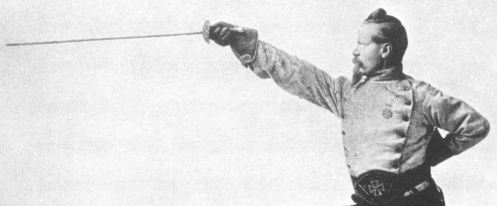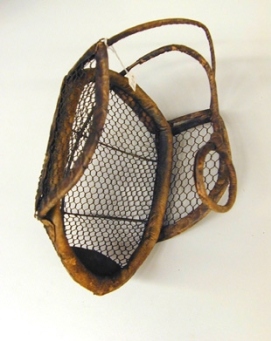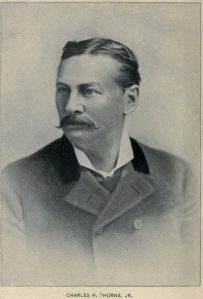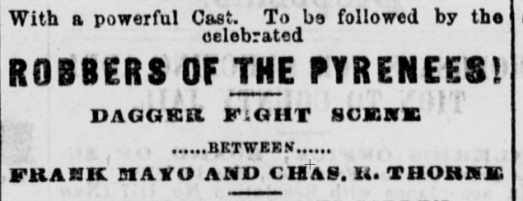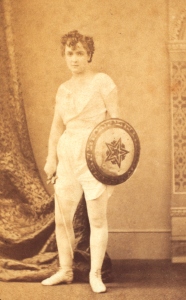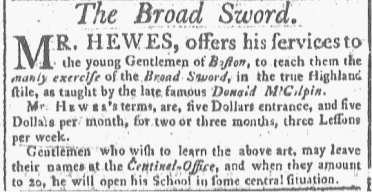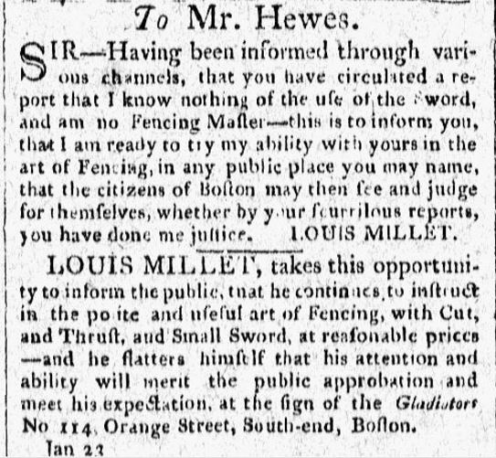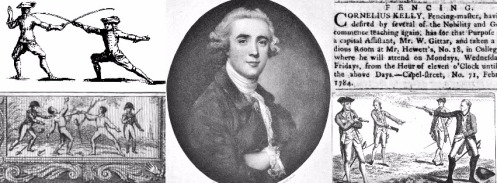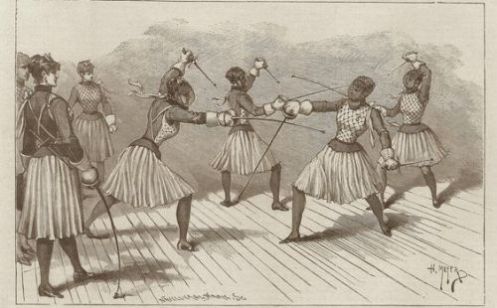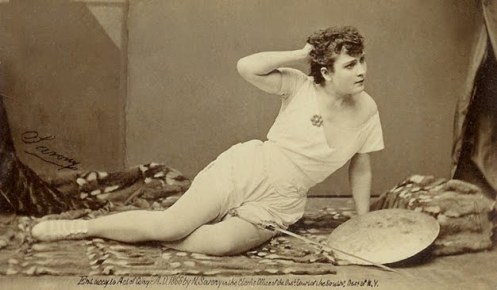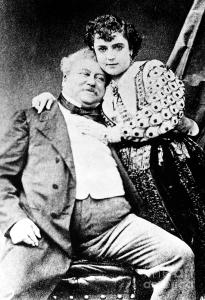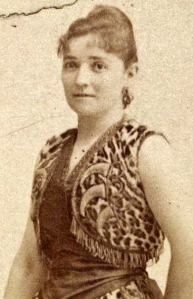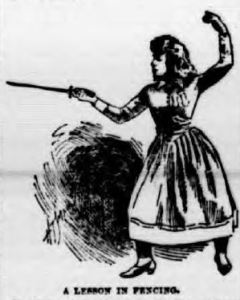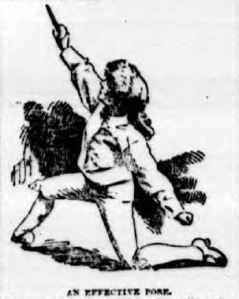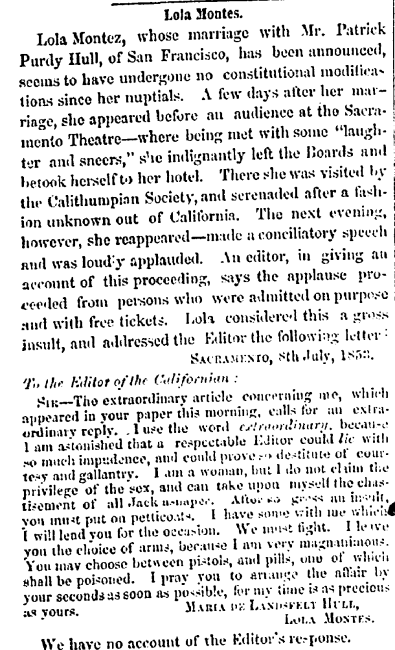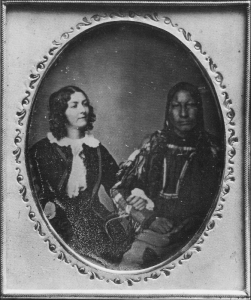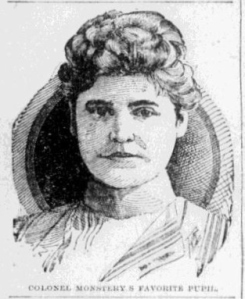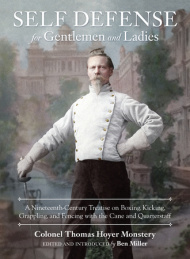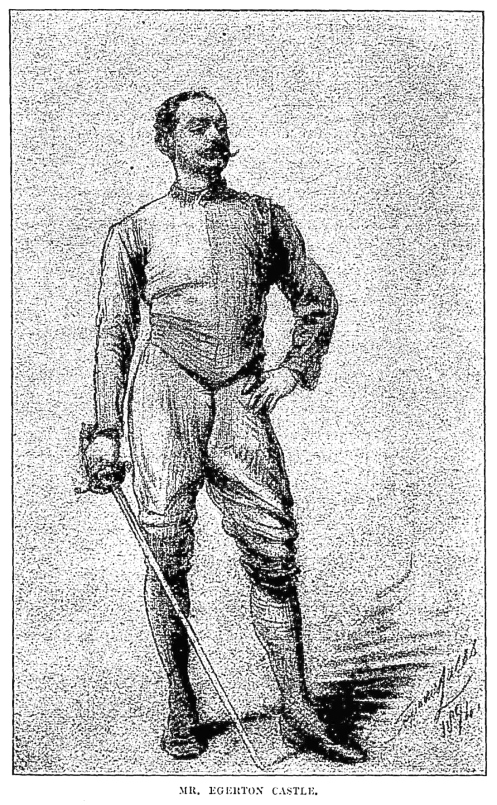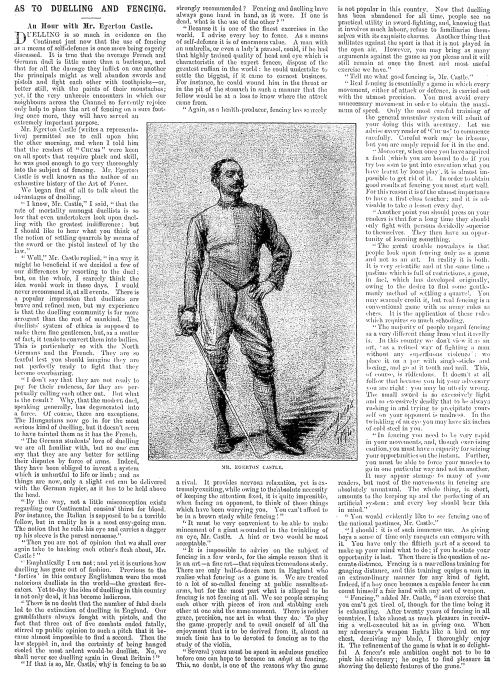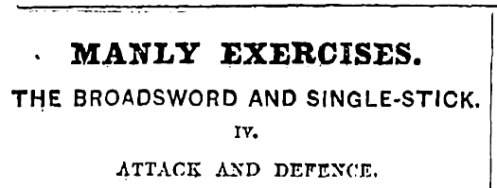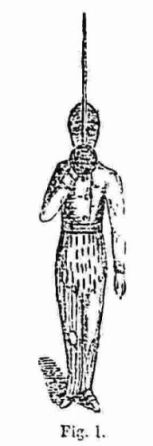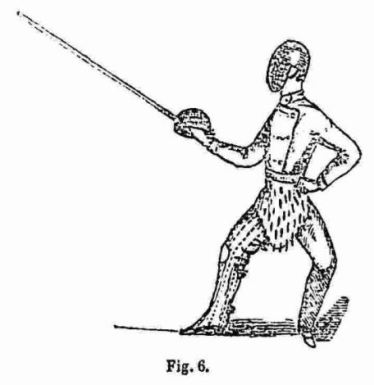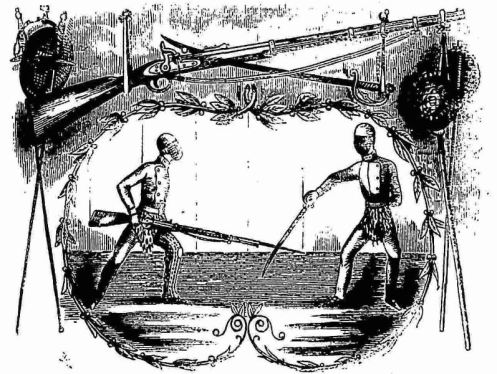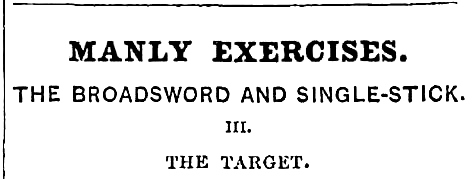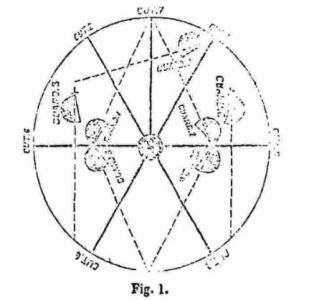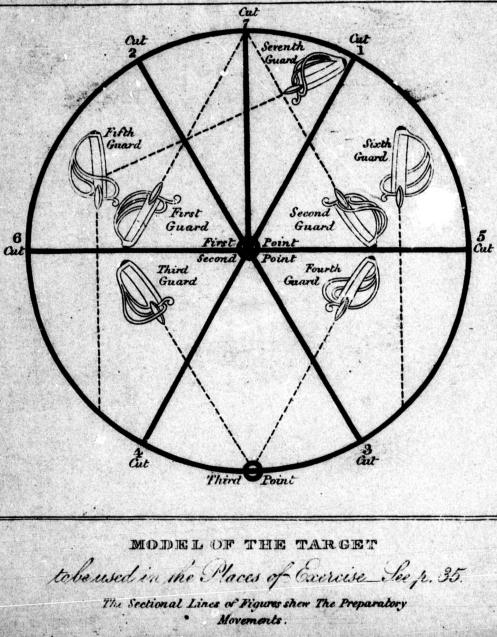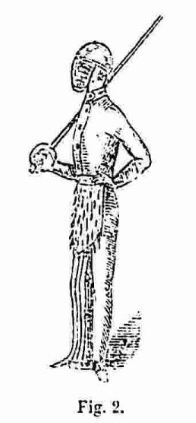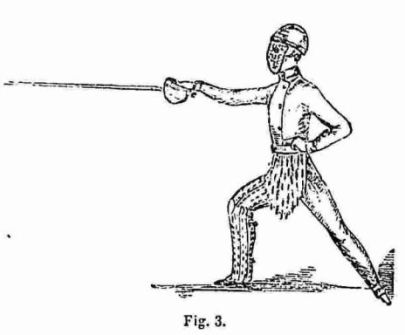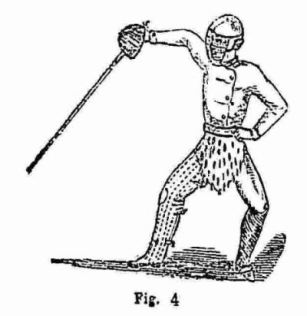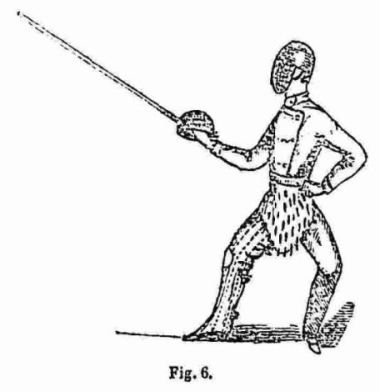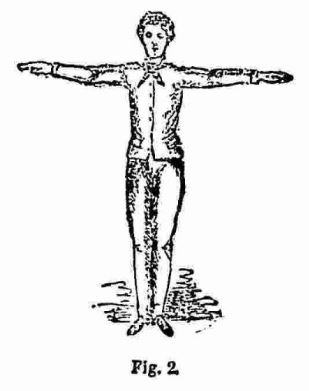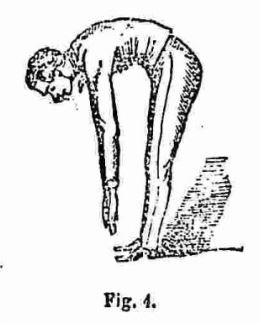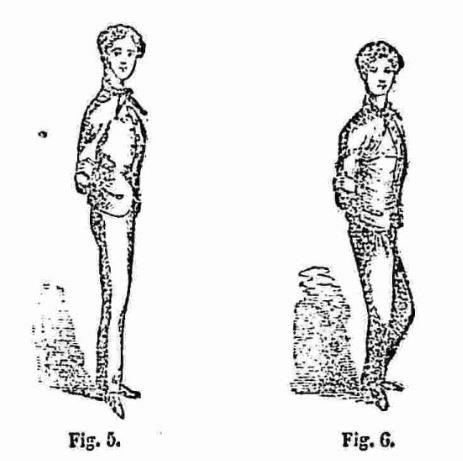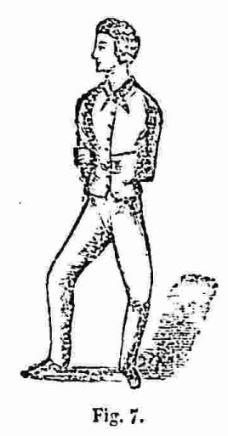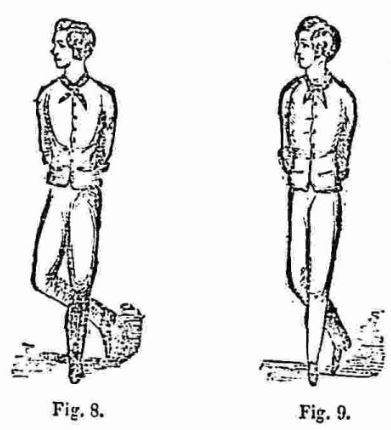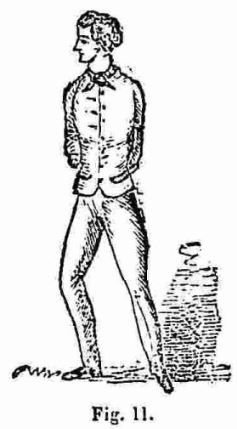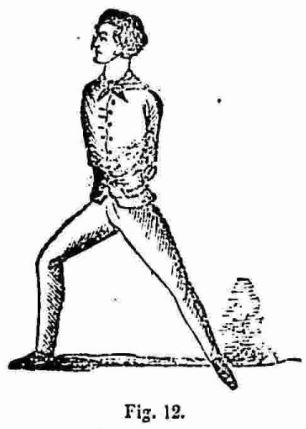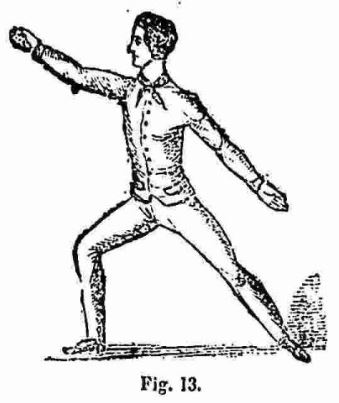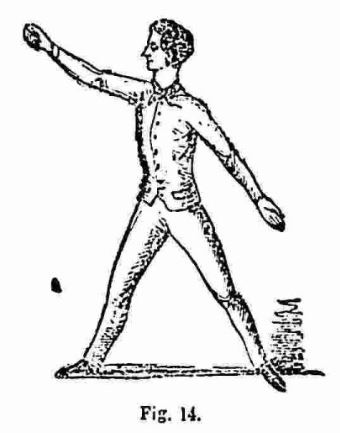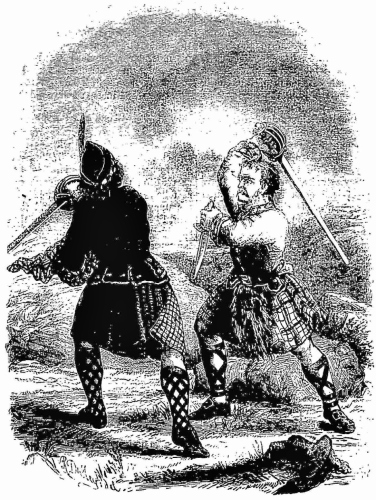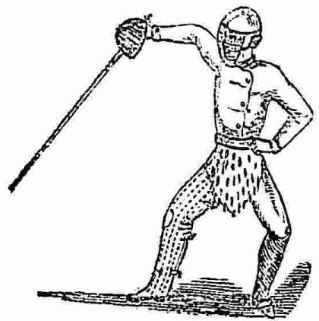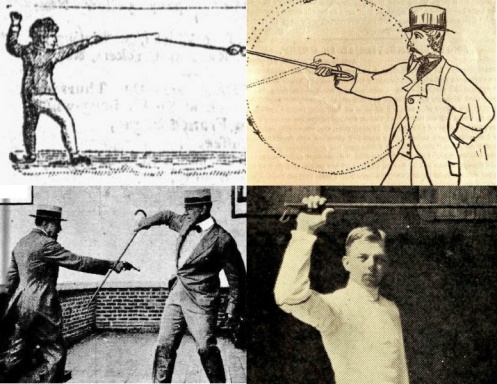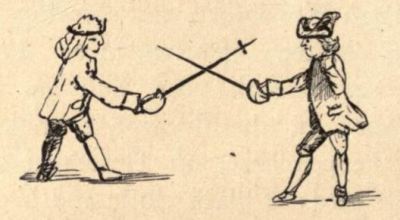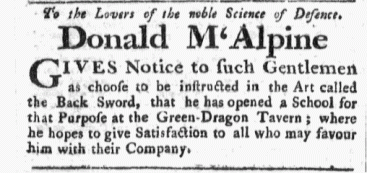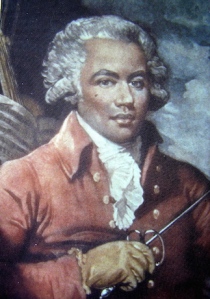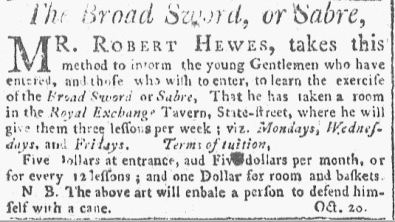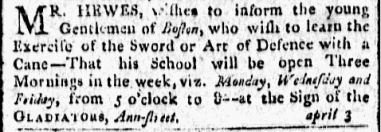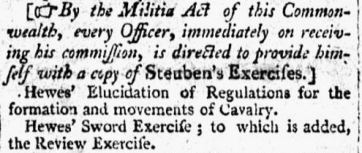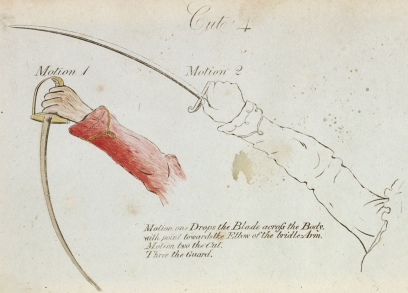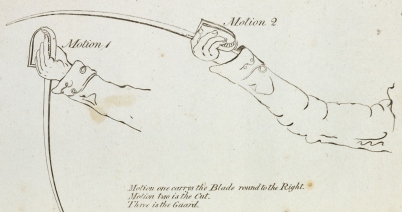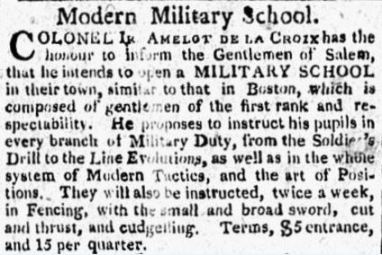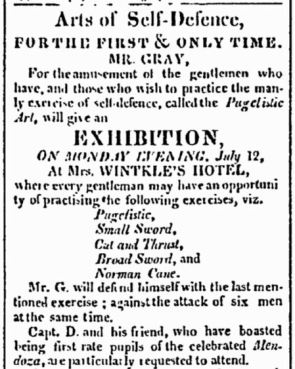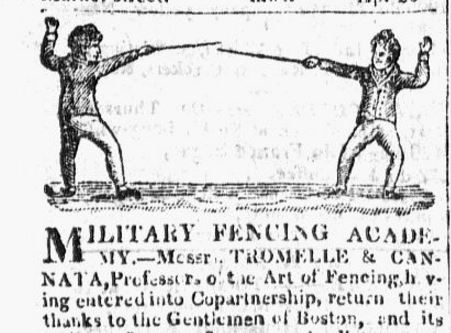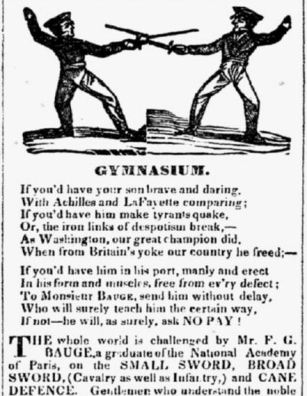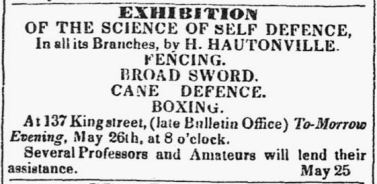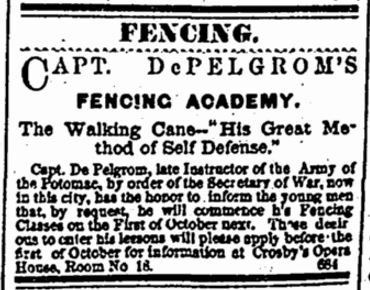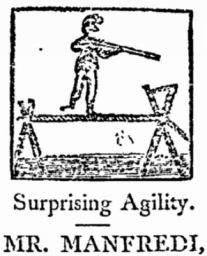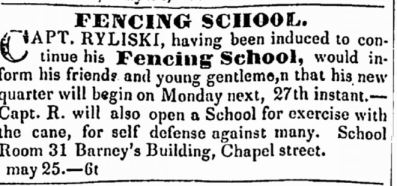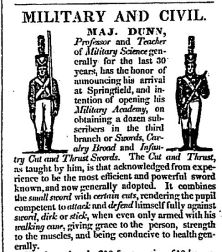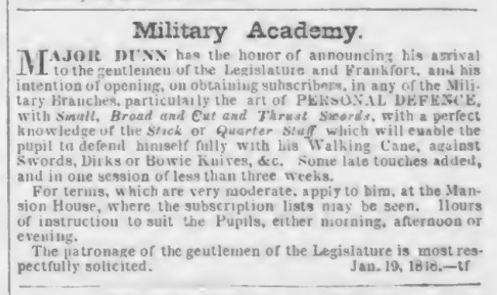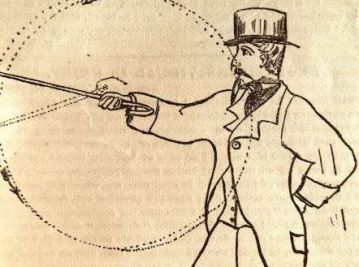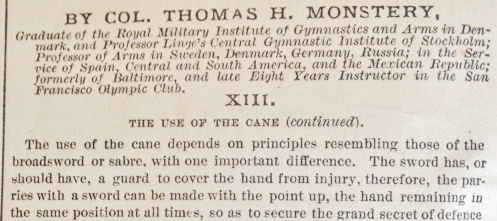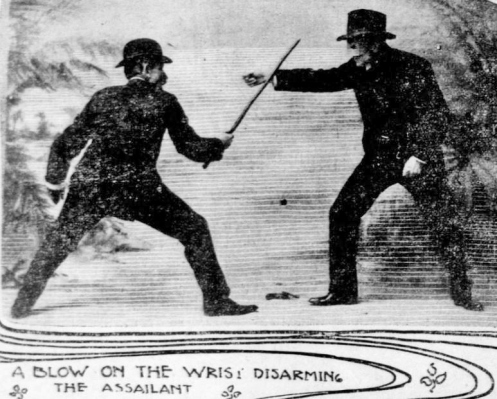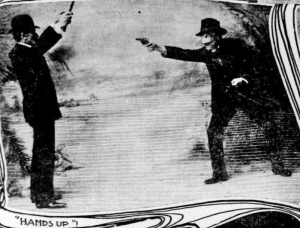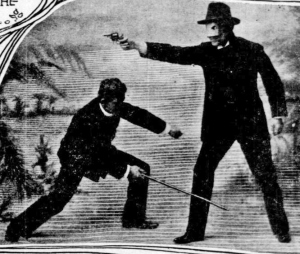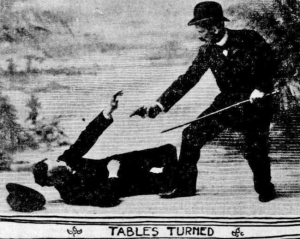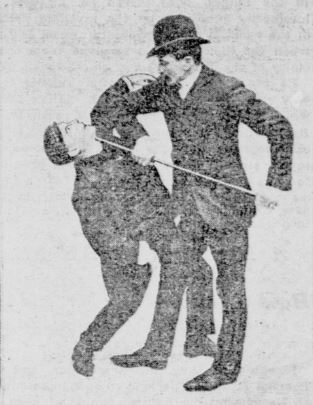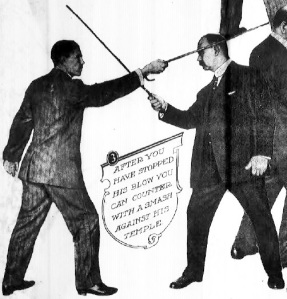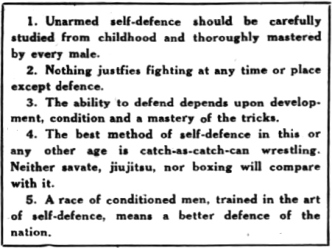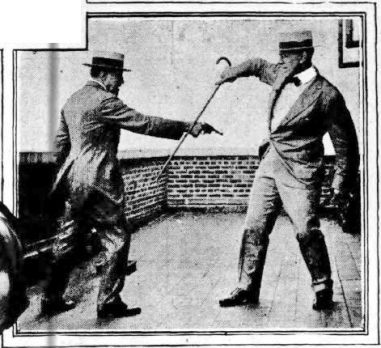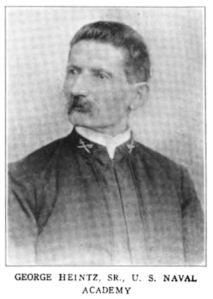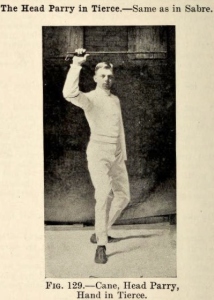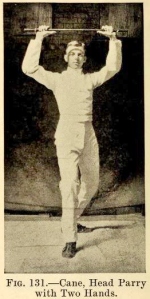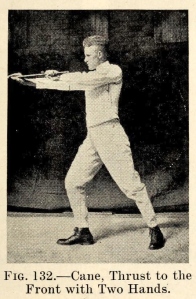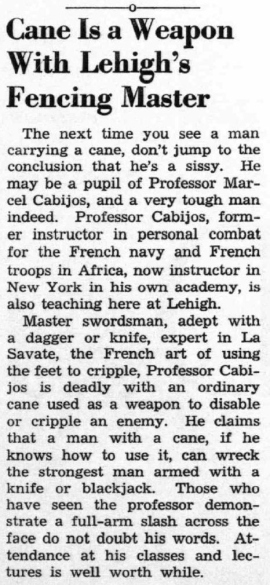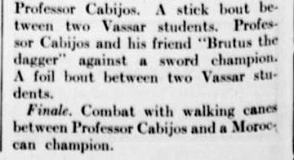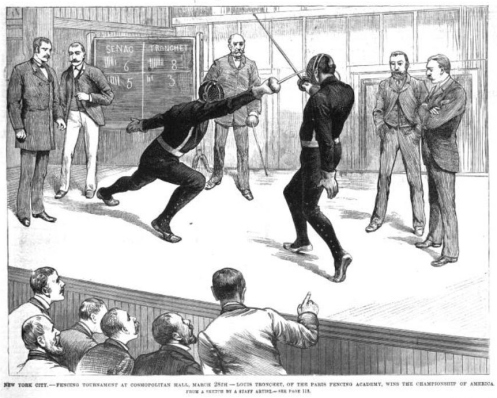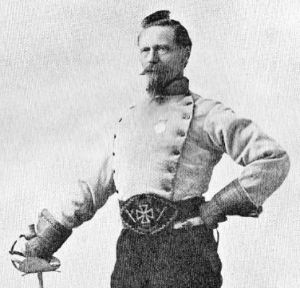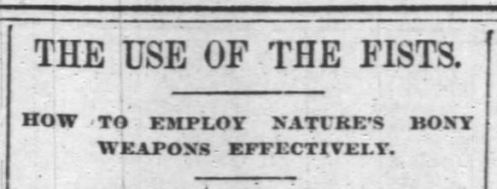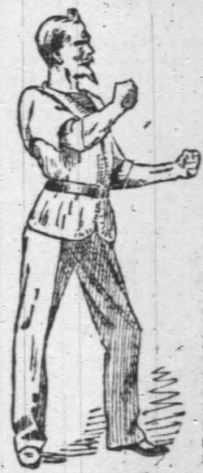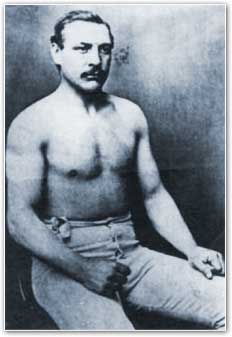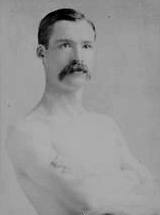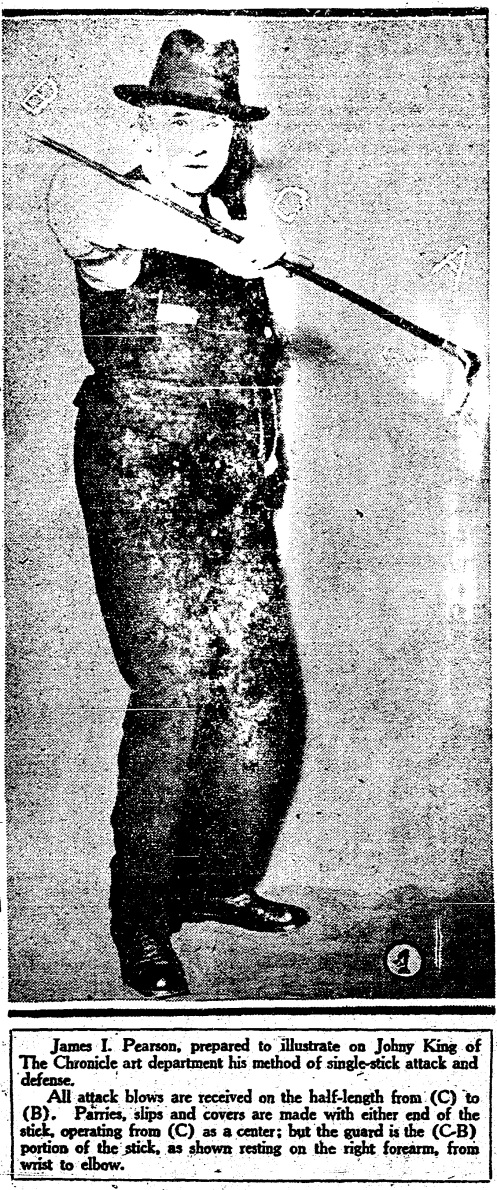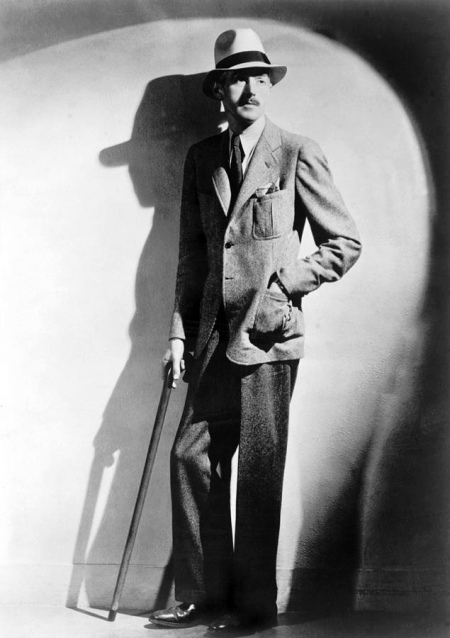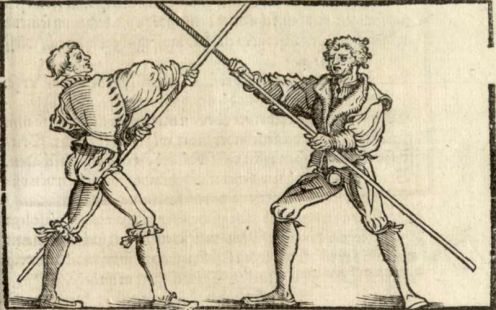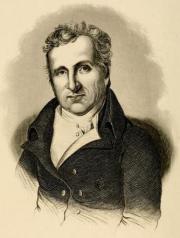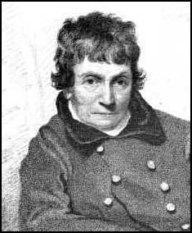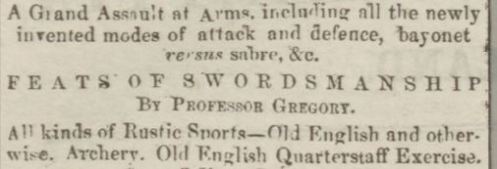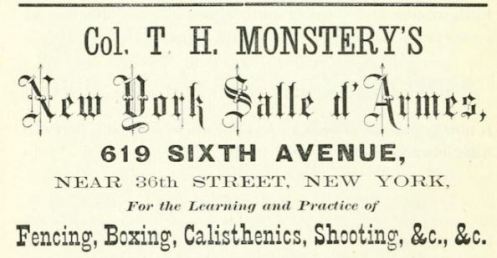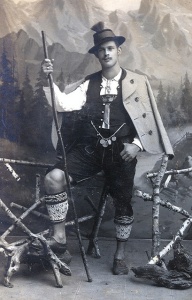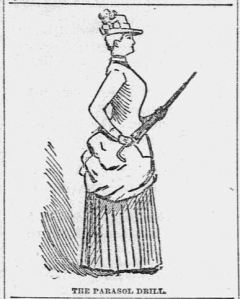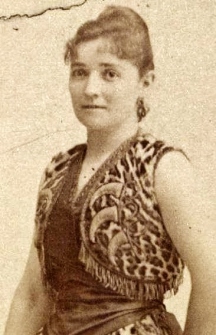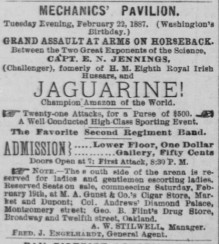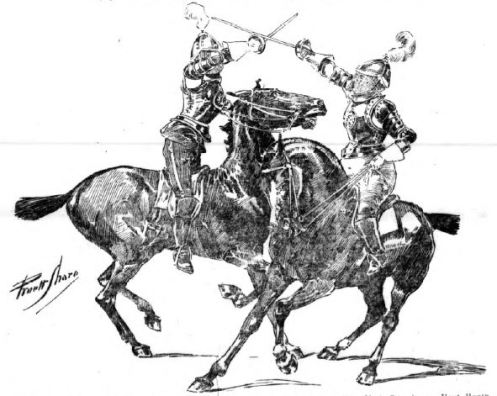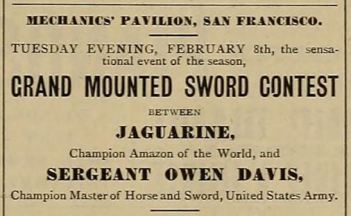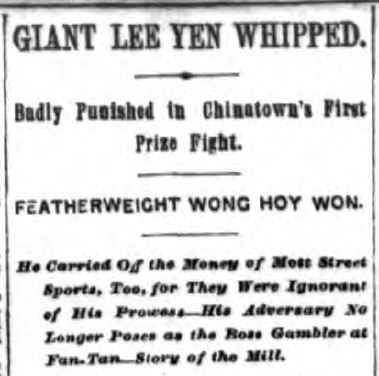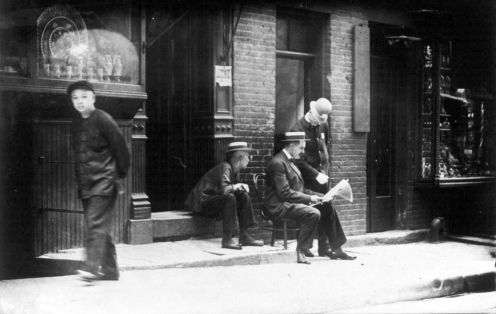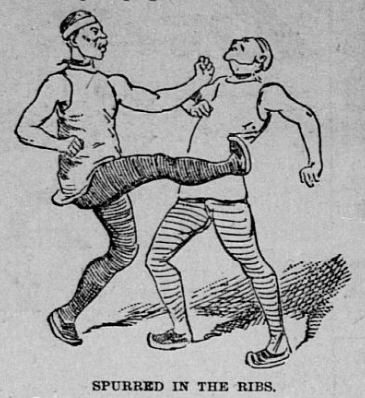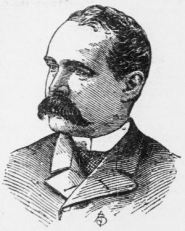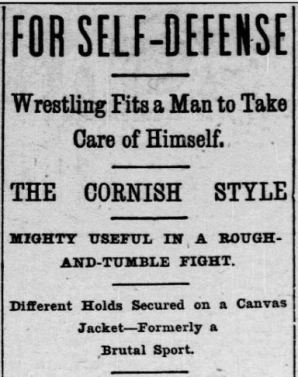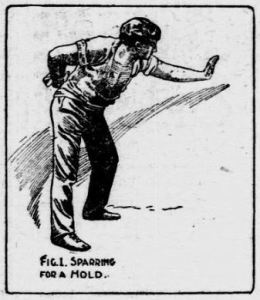“This,” said the professor, “is my bayonet and dagger breastplate. You see, I teach both bayonet and dagger or knife fencing, and I should not like to hurt my pupils…”
The following article appeared in the February 17, 1883 issue of the Chicago Daily News, and contains an interview with the celebrated duelist, swordsman, boxer, and master of arms, Colonel Thomas Hoyer Monstery. It appeared in print very shortly after Monstery’s arrival in Chicago from New York, and appears to be the first profile of the fencing master written and published in the Windy City. The interview is especially interesting, as it provides a great deal of information about Monstery’s weapons, training equipment, and students (both male and female). Here follows the article in full, supplemented by related historical images, and a few newly inserted footnotes.
HANDLERS OF THE FOIL.
AMATEUR SWORDSMEN OF AMERICA.
Fencers and Fencing in Chicago—An Old Master’s Choice Weapons—Thorne and Mayo as Dagger-Duellists—Experts with the Rapier.
“On guard, if you please; now parry this,” followed by the whistling of foils and sounds such as emanate from a room wherein fencing is being practiced, were what one entering a certain room on Randolph street might hear any afternoon.
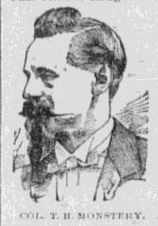 The words were spoken by Col. Monstery, the swordsman, to a young athlete whose tutor he was. The colonel was instructor in his art in leading military schools in Europe, and under his training a hundred duels have been fought. He is a soldier in appearance, and stands erect five feet and ten inches. He is spare in his physique, but his frame is of iron and full of suppleness. His hair is gray, and his fast whitening mustache and imperial are waxed after the manner of Napoleon. His eyes are as bright and sharp as those of a man of twenty-four years, and his very carriage shows that age has not detracted from the grace and agility which marks the perfect master of the sword. The colonel was born in 1821, in Baltimore, Md., of Scandinavian parentage¹. He early went to Denmark, where he was for a number of years pupil in the Royal military academy, in which school he afterward became an instructor in fencing. His life has been a varied one, and yet, in spite of all his hardships, he is as cheery as a youth. For many years he has taught fencing in all the large cities of Europe, where his name is remembered with pleasure by swordsmen. Among his noted pupils was the Grand Duke Constantine. In 1868 he followed Maximilian to Mexico, where he was made instructor in swordsmanship to the Mexican army. He served through the war of that time and became noted by his wonderful proficiency with every style of weapon.
The words were spoken by Col. Monstery, the swordsman, to a young athlete whose tutor he was. The colonel was instructor in his art in leading military schools in Europe, and under his training a hundred duels have been fought. He is a soldier in appearance, and stands erect five feet and ten inches. He is spare in his physique, but his frame is of iron and full of suppleness. His hair is gray, and his fast whitening mustache and imperial are waxed after the manner of Napoleon. His eyes are as bright and sharp as those of a man of twenty-four years, and his very carriage shows that age has not detracted from the grace and agility which marks the perfect master of the sword. The colonel was born in 1821, in Baltimore, Md., of Scandinavian parentage¹. He early went to Denmark, where he was for a number of years pupil in the Royal military academy, in which school he afterward became an instructor in fencing. His life has been a varied one, and yet, in spite of all his hardships, he is as cheery as a youth. For many years he has taught fencing in all the large cities of Europe, where his name is remembered with pleasure by swordsmen. Among his noted pupils was the Grand Duke Constantine. In 1868 he followed Maximilian to Mexico, where he was made instructor in swordsmanship to the Mexican army. He served through the war of that time and became noted by his wonderful proficiency with every style of weapon.
The room in which the old master swordsman stood was a curiosity. On one wall was a large rack in which were some thirty foils, of all styles of make and quality. Just below these were boxing gloves, and guards for the fencer’s hands. Above the rack was a magnificent Toledo blade which, the colonel said, was his favorite, and was 500 years old. Crossed with that was a Swedish sword, whose perfect steel could not be equaled in America. Next to this pair of matchless weapons was an English army sabre, crossed with a Danish “iron-cutter,” and hanging beside these were two other swords. On the colonel’s desk were two daggers, one a genuine Roman weapon, the other a curious antique knife, which was a masterpiece of workmanship, evidently produced by a rival of famed Damascus. Near these were dueling pistols and revolvers, with the use of which the colonel was perfectly acquainted. On the front wall between two windows hung a breastplate of steel, found in Central America, and undoubtedly worn by one of the Spaniards who first invaded that land. Near this were found rules for fencing and boxing², originated by the professor and adopted as the standards. There was another breastplate of steel, heavily gilded, but battered and marked by constant use.
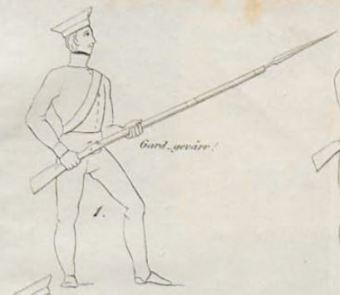
Bayonet guard (1838) in the system of Pehr Henrik Ling, which method Monstery learned, among others.
“This,” said the professor, “is my bayonet and dagger breastplate. You see, I teach both bayonet and dagger or knife fencing, and I should not like to hurt my pupils. I had this and that (pointing to a similar plate hanging in another place) made for me in Denmark out of Swedish steel, so that I know they are proof against blows.”
On the third wall was a motley and interesting collection of wire masks of all varieties.
“These,” continued the Colonel, “are for light fencing. I had to import them from Europe. As you see, they are strong steel wire, made by hand. They have no pads outside, and to outward appearance are but the common fencers’ mask, but they all came from the Royal Arsenal in Denmark, and are pure shining steel. Here, however, are the broadsword masks (taking down a heavy head covering of steel network). They are made extra strong, and have padding on the top of the head and in the side, so that the exercisers may not be hurt. I have more varieties, but they all serve the same purpose. Here is the glove of stiff leather that we wear when using the broadsword or German ‘schlaeger.’ Up above them you see the three cornered or triangular rapier of the purest and best steel and are usually taken by the duelists. They were the weapons worn by the noblemen of old and used in their combats with such fatal effect. Next to these are the pointed and bladed cut and thrust straight sabers which have been in eight duels in this country, one on Long Island, some years ago³. Just beyond these are foils with their buttons off. They have also seen their duels and have each drank blood, though I am happy to say no life blood.”
“Here are my daggers and knives. You see they have guards, but removed they are pretty ugly. I teach the defense from the bowie knife and the defense from the dagger. Here is the common plastron, made extra heavy and used in the saber exercise with the heavy masks you see there. This plastron I have made myself and I have used it with many celebrated persons in their day.”
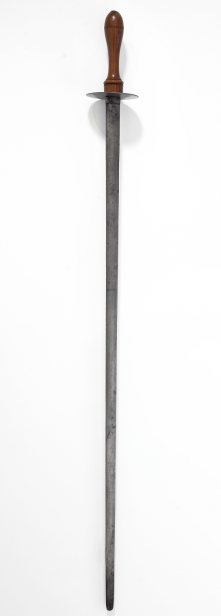
Florett, or foil, with an unusually broad blade, from the Livrustkammaren in Stockholm (it is not known how similar this may be to the foils Monstery describes).
“Before we sit down, let me show you my foils. They are from Denmark, and, as you see, are broader than the ordinary foil, so that if by any mishap the button should break, the foil cannot penetrate the mask and lacerate the face. Many fathers buy the common narrow foil, and I have seen many persons badly hurt to the face by them.”
“The Americans have no patience to learn to fence well. Some of them try it, but they give it up soon. I tell you, sir, it is the best thing in the world for the men—and the ladies, too. It is not violent and rough, like boxing, and it does not strain the nerves, like rowing, but it makes the warm blood run through your body, and it makes health come. Besides it strengthens you wonderfully. A wealthy gentleman of Boston—Mr. Whitcomb, now in Paris—came to me when he was about 40, and said, “Colonel, I am afraid of consumption.’ I said, ‘I will cure you, come and fence.’ He did, and where he had been stoop-shouldered he is now strong and hale, and over 60 years of age. Such is the beauty of fencing.”
[Journalist:] “Who is the best fencer in Chicago?”
“Fred Englehardt is probably the best amateur. He is very quick, and his passes are made beautifully. Next to him is Mr. Ribolle, who, though only a pupil, gives good promise of being a fine swordsman. He is especially proficient with the broad sword. Then young Mr. Arnold is excellent with the cane. Mr. K. G. Nixon is a clever handler of the cane, the foil, and the single stick, and will yet prove a formidable opponent to the most expert. There are also Sparling, Ryerson, Hansen, Barker, Mason, and Gregory, all Chicagoans, and all quick and neat in their ways.”
“Do the editors of the papers and the news paper ever come to you?”
“Not here in this city. I have only had one newspaper pupil. He was Mr. John Ballantyne, but for some reason he gave it up some time ago. In other cities, though, I have had many. James Gordon Bennett has been under my tuition for a time. He was a good swordsman, and since I have been away from New York he has been under another’s care.”
“Who was your best pupil?”
“Francis G. Wilson, the young actor who was with the ‘Our Goblins’ last year. He won the amateur fencers’ prize, and, by his beautiful skill, has made his way on the stage. Peter Barlow, the wealthy New Yorker’s son, and the young society gentleman, is also a beautiful fencer, and for one so large—he weighs 250 pounds—he is very graceful with the foils. The one who is the best of these New Yorkers who have come under my care is Congressman Belmont, whose autograph you see here in my book (showing an old account book). Since I have been away from New York I have lost him. Why, my dear sir, before I left New York, eight years ago, I had twenty-three pupils regularly every day in my rooms, and they are all skillful swordsmen. William W. Riggs, the son of the now dead Parisian banker of the firm of Corcoran & Riggs, was one of the best swordsmen I have seen. He could use both hands, and could change his foil with ease from one hand to another. Catheart is another fine swordsman, and is the equal of the best of them. The finest swordsmen and athletic young men are to be found in California. There the foils are at home, and there I have had many a good round. I was instructor in fencing and boxing in the Olympic Club gymnasium in San Francisco for eight years before I came here, and my pupils have conquered all they have met. Robinson, the man who outboxed Slade, was first my pupil.”
“Who are the best swordsmen in the world?”
“With the broadsword the Americans and the Germans. With the rapier and the foils, I think the Americans can again take the palm. The most celebrated French swordsmen were with Maximilian when he went to Mexico, and I know that out of over two hundred duels that were fought there, the Mexicans won two-thirds. They are beautiful swordsman. He keeps his skill well, for he teaches fencing, and he keeps in practice. If more Americans would take fencing, they would be the best in that, as they are in everything. Mind, I don’t want them to fight duels. That is not what the noble exercise is for. It is to make them graceful, and bright, and quick.
“Have you had many pupils with the knife?”
“Not many in the east. In California I had a large number, and in Europe also. On the stage, however, all the great knife duelists have been my pupils. When Charley Thorne, now dead, poor fellow, was young he played with Frank Mayo in a piece called “The Robbers of the Pyrenees,” I think it was. In it was a duel with knives between two characters taken by Thorne and Mayo. I was in New York then, and I taught them to use the knife. They did well, too. I have had many more, but they are enough.”
“Have you had many actors as pupils?”
“Oh, yes. Junius Brutus Booth, who was the best amateur swordsman while he lived, was a pupil of mine. He taught his son Edwin how to fence. He was my favorite pupil of old. John McCullough, Lawrence Barrett, Charles Thorne, Dolly Davenport, E. J. Davenport, Frank Mayo, and Edwin Forrest have all had their names on my books as pupils.”
“Have you had many lady pupils?”
“Not here, but in the east. Lola Montez and Adah Isaacs-Menken were two of my most noted pupils, and learned their beautiful skill from me. I had a number of society ladies in New York, in Europe, and in California.”
“Do the ladies make good fencers?”
“Oh, yes. If they keep at the work long enough they become even better than the men, for they are more supple. I like to teach a lady, for she tries much harder, and gives much satisfaction.”
NOTES:
¹ This statement is erroneous. Birth records show that Monstery was born in 1824 in Copenhagen, Denmark.
² These rules have been reprinted in full in the Appendix of Monstery’s Self Defense for Gentlemen and Ladies.
³ An account of this duel, between Col. Canzi and General Fardella, and of Monstery’s training of the former, can be found in the Introduction to Self Defense for Gentlemen and Ladies.
“Come, Mr. Millet, attack me in your turn, and do it well, or I shall catch you.” – Robert Hewes
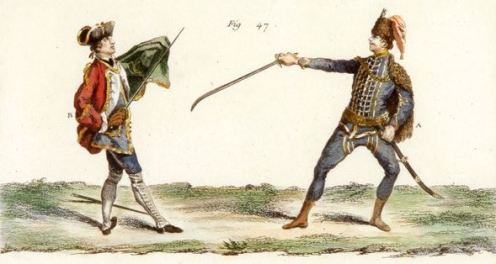
Smallsword defense against Broadsword, from Angelo’s plates from L’Ecole des Armes included in “Escrime,” Encyclopédie (Paris, 1765).
Today, it is not uncommon to witness or overhear martial arts enthusiasts arguing over the merits of various weapons and respective martial arts methods, and their supposed superiority (or inferiority) over others.
Such a discussion, it turns out–in the form of a public controversy–also took place in early nineteenth century Boston, at a time when the world of American journalism was quickly expanding, making public arguments even more possible–and likely to occur–than ever before.
At the center of the incident was one Robert Hewes (1751-1830), a Boston native, local eccentric, and fencing master. Described by his contemporaries as an “extraordinary” and “ingenious” man, Hewes was a former member of the secret revolutionary society, the Sons of Liberty, and the first American fencing instructor that we know of to publicly advertise instruction in cane defense. He was described by the Boston press as a surgeon, as well as a “celebrated bone-setter and fencing master.” In acknowledgement of this fact, Hewes hung a sign outside his residence which humorously read, “Bone breaker and bone-setter.” According to Hewes himself, his training in fencing began about 1770, at which time he entered the school of the Scottish Highlander, Donald McAlpine.
Hewes was not the only fencing master in Boston at that time, as the city played host to numerous schools and academies–including several run by French immigrant fencing instructors. Animosity had evidently sprung up between Hewes and one of his French competitors, for, on January 23, 1808, the following announcement appeared in the pages of the Boston journal, the Columbian Centinel:
Evidently, Louis Millet had recently arrived in Boston, for very the same day he posted his challenge to Hewes, he also published (in the same issue) his first fencing advertisement in the city, informing the public that he offered instruction in the “polite and useful art of Fencing, with Cut, and Thrust, and Small Sword, at reasonable prices.” Millet was also associated with a group of French instructors, including Messrs. Tromelle and Girard, at the military fencing school of Colonel Amelot De La Croix, also in the Boston area (Independent Chronicle, March 20, 1809).
Only a few days later, on January 27, Hewes published a response in the Centinel, containing an account of a previous combat between himself and Millet. Hewes’ unusually detailed description, related with his characteristic humor, offers insight into the fencing method he was using, as well as a fascinating glimpse into the fencing world of post-Revolutionary Boston:
To Mr. Millet.
SIR—In last Saturday’s Centinel, you charge me with saying, that you know nothing of Fencing, &c—and invite me to a public trial of skill, &c—As to the scurrilous charge of my saying that you know nothing of the use of the Sword, I can in conscience deny it:—But, what I have said, and do now say, is this—That I believe you understand the Small Sword very well; but that you do not so well understand the Broad Sword;—so think some of your friends.
Mr. MILLET, you must give me leave to presume, that I do understand what the Broad Sword is scientifically; having learnt it of the famous DONALD Mc GILPIN, a Scotch Highlander, above thirty eight years ago; and I have had the honor and pleasure of teaching it to many of the Officers of our Revolutionary Army, in Roxbury and Cambridge, in the year 1775—and have done it at times, ever since. During the last ten years I have kept a regular school. But the Broad Sword you understand, is the French Counterpoint—a great difference.
The next thing is you invite me to a publick trial of skill.—With whom? A man I do not know. And for what? Why to please you, and a gaping multitude, that will know no more of the merits of it after it is over, than they did before it commenced.—What I, the hoary head, in boyish martial sports, on publick stage exposed! Oh, no no! Mr. MILLET; my rank in society, my age, forbid it; especially with a competitor I do not know. But why do you want another trial, when we have already had a fair one, by your own application and desire; and contrary to my wish; yet I desire to be thankful it was so public that I have sufficient evidence to full substantiate the merits of our combat.— A plain recital of the facts, attested by the evidence with a technical description of our combat, I will endeavor to relate in truth and dispassionately;—
About a month ago, you was introduced to me by your friend, Mr. ————. After being in the room a little while, you desired to play with me—I declined. There were two young gentlemen, my scholars, in the room—I pointed to the eldest of them, and said, “Play with him.”
“Yes,” said the young gentleman, “I will play with you.”
(MILLET.) “No,” said you, “if I play with any body here, I shall play with the master.”
“Then,” said I, “you’ll play with me, quick time.”
I then presented you with one broad sword Foil; I having the other myself. My two pupils paid strict attention to everything we did; but your friend, Mr. P———, seemed to be regardless of what was going on, for he sat all the time eating nuts as hearty as a grey squirrel.
Now comes the technical description of the combat:—First, we join issue upon an inside guard—I cut you with cut two, on the outside of your arm:—you then come to the counterpoint guard in seconde—I cut you four, under your arm;—we join again and I cut your leg with cut six;—the next was a counter.
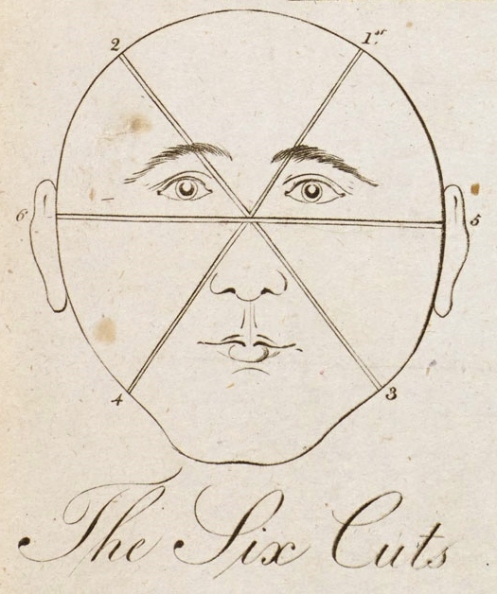
An image showing the numbered cuts from the treatise of Col. Le Marchant, which was edited and republished by Hewes in America.
I then said, “Come, Mr. MILLET, attack me in your turn, and do it well, or I shall catch you.” You then made a little movement and hit my arm. You then came in a very swordsman like manner, and made cut five, at my body—I spring back, slipped your cut, and gave you a plump cut upon the head—and so the combat finished, by my cutting you four times, and you cutting me once.
Now, Mr. MILLET, since you have treated me in this scurrilous manner, by denying the merits of our combat, which was solicited by yourself, and persisting in publishing your scurrilous piece; I am determined never to have another trial of skill with you, publick or private; nor to have any altercation or conversation with you, written or verbal; and if any thing more shall appear in the papers, I am determined not to take the least notice of it.
ROBERT HEWES,
Jan 25, 1808.
[The two gentlemen scholars of Mr. H. have appeared at this office, and testified to the truth of Mr. H’s account of the combat, above referred to.]
More than a year later, on May 17, 1809, Hewes felt compelled to offer details of another similar incident, in the following nationalistic piece, published in the pages of the Centinel:
To Young Gentlemen who intend to learn the Art of Defence on foot with the Broad Sword and Sabre or Cut and Thrust.
IT always has been, and with some is still a disputed point which is best, the Broad Sword, or Small Sword.—Some will assert, (not knowing what the true Scotch Broad Sword is) that the Broad Sword is no manner of Defence against the Small Sword.—Others (who understand the Broad Sword well, and can play well, by daily experience) prove, that it is a complete Defence against the Small Sword, by evading or guarding their thrusts—and cutting their head or arm, which they generally do twice out of three:—the reason is, being too much practised in bending the elbow the Cuts of the Broad Sword meet their arm instantly;—as was verified the other day thus:—One of my Scholars introduced a French Gentleman and desired to play the Small Sword with him. We played loose pretty sharp a few moments, and neither hit.—He then desired us to play Cut and Thrust—we did;—but he no sooner moved than I cut his arm three times. He then says to my Scholar the reason Mr. HEWES cut my arm so easy is, because I am too much in the habit of playing the Small Sword with a crooked arm—therefore I cannot play Cut and Thrust. This Gentleman was candid enough to own, that the Cut and Thrust cannot be played with a crooked arm:—Therefore, to play true and with safety with a Cut and Thrust, the Broad Sword, according to the Scotch and Austrian systems, must be well learnt.—Which forbids the bending the elbow, raising or lowering the arm or passing the line to the right or left—in fine, the arms is as an iron bar, the wrist the pivot round which the Sabre flies, or in other words, the hand and hilt of the Sword is the centre of action, as a hob to a wheel; the blade as the spokes.
If there are any young Gentlemen Americans, who believe that a Prophet can have honor in his own country, and that it is not supernatural or notional to be master of an art, they may well have full satisfaction, as to the true system of the Broad Sword, uniting the Scotch and Austrian methods, which constitute the Cut and Thrust, by applying to their humble servant, ROBT HEWES,
Sign of the Gladiators, Ann Street, near the Draw Bridge, Boston—who has had the pleasure of teaching the Broad Sword near forty years.
VIVAT YANKEE DOODLE
N.B.—The Horse and Train of Artillery Sabre Exercise—and Cane Fighting taught as heretofore.
May 17.
Hewes’ French rivals were evidently furious, for the next day they published the following in the Centinel:
Take Particular NOTICE!
SOME Fencing Masters have read in the Columbian Centinel, the observations of a Mr. Robert Hewes, styled Primary Military School—setting forth the advantage of the Scotch Broad Sword—Experience having demonstrated to then, that the gentleman infallible to a mistake, without enlarging on the observations, which would demonstrate that even a slight wound on the arm would not prevent his antagonist from thrusting his sword through his body, and without remarking, that gentlemen in the habit of fencing with baskets, as it has been observed, would soon be disabled in the hand if armed with an ordinary Sabre—In order to prove in an undeniable manner, what they now assert—the Fencing Masters have the honor to invite Mr. Hewes, respectfully to attend the general assault—to be given on the 23d inst. at the Military School, Court-street, No. 17, where he may have his choice in any kind of fencing, or cane-fighting, on the true principles of the Paris Academy. They flatter themselves that Mr. Hewes will not fail to appear—his assertions render his presence indispensible, and the Spectators are entitled to a demonstration.
Boston, May 18.
Hewes, however, true to his word, neglected to take this “bait,” although he remained an ever-present voice, and teacher, in the Boston fencing world until his death in 1830.
POSTSCRIPT:
In the end, Hewes merely defended his method as a “complete defence” against other weapons such as the small-sword, and did not necessarily assert its superiority over them. By contrast, Donald McBane–a Scottish swordsman regarded as one of the most prolific duelists of all time–wrote in his treatise that the small-sword had “great odds” over the broadsword, and over nearly all other weapons. If anything, the outcome of Hewes’s combat with Millet (if we are to believe the former’s account), attests to the usefulness (and during the period, the necessity) of a swordsman being familiar with both (or all) predominant methods and weapons in use at the time. Indeed, in considering the entire history of fencing, it is evident that the ultimate superiority lies in the fencer who wields the sword, not in the particular type of weapon wielded.
As a treat for readers, we end with another lengthy, colorful, and humorous period fencing advertisement, courtesy of Robert Hewes:
Announcing the release of the book, Irish Swordsmanship: Fencing and Dueling in Eighteenth Century Ireland, available in October 2017.
The product of more than ten years of research, the first part of this book tells the story of eighteenth century Ireland’s most renowned duelists, gladiators, and fencing masters, as well as that of Ireland’s most celebrated fencing society, the Knights of Tara—whose lavish fencing exhibitions won fame and glory for Ireland, and whose member’s innovative writings on bayonet fencing found their way into the hands of George Washington.
Notably, this book also includes extracts from several Irish texts on the martial arts (written or published between 1780 and 1860) which have previously not been noticed by scholars, and contains the complete text of A Few Mathematical and Critical Remarks on the Sword (1781)—an almost completely overlooked Irish fencing treatise, now published again for the first time in more than…
View original post 766 more words
“It is a great mistake to suppose that women cannot learn fencing as quickly as men…the fact is the women are much the quicker pupils. They are more flexible of body; their limbs are more supple and elastic—that’s one advantage. Their mental brightness enables them to pick up the strategy of the art quicker—that’s a second advantage. And, thirdly, they have more nerve—it’s a fact; I don’t know why, but it’s a fact.” – Col. Thomas Monstery, 1888
Continued from Part I.
By Ben Miller
In 1870, one of America’s most distinguished martial arts masters opened a “School of Arms” in New York City. He was a fencing master, boxer, marksman, sailor, adventurer, street fighter, soldier of fortune, and world traveler. He was Colonel Thomas Hoyer Monstery.
When it came to combat, Monstery had an impressive resume. He had fought under twelve flags in numerous wars and revolutions, had survived participation in more than fifty duels with the sword, knife, and pistol, and had twenty-two scars on his body to prove it. In addition to being a “master of all arms” (which included the rapier, dagger, broadsword, Bowie knife, lance, bayonet, and quarterstaff, among others), Monstery was also a “professor of sparring,” and taught a special system of bare-knuckle self-defense that integrated punching, grappling, and kicking techniques, designed to be effective against a wide range of fighting styles.
One of Monstery’s most unusual traits, however, was that he encouraged women to take up fencing with a variety of weapons, as well as boxing, long before it was both popular and fashionable for them to do so. Monstery claimed that he taught his female pupils no differently than he did men. This was a great point of distinction; typically, the scarce fencing instruction available to women during this period was limited to the use of the foil, an academic training tool. Monstery, however, did not limit his instruction to the art of the sword; in 1888, he was teaching “two classes of lady-boxers”; in New York City, he also held several ladies’ classes in stick self-defense. Evidence also suggests that to select female students, he also provided instruction in the rapier, dagger, knife, and bayonet. Additionally, Monstery included a special drill in his curriculum intended to prepare his female pupils for potential street encounters, teaching them to deliver a “bayonet thrust” with their parasols, which, he said, “would break a rib, or a one-handed thrust, that would put out an eye.”
Perhaps due to this progressive attitude, Monstery was able to attract a remarkable number of high-profile female students, some of whom led truly extraordinary lives. Following are their stories.
Ada Isaacs Menken (1835-1868)
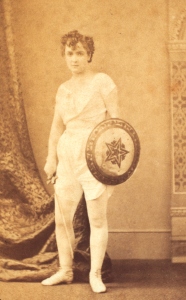 On the right, Ada Isaacs Menken poses with sword and shield for her role in the melodrama “Mazeppa.” According to the Daily Inter Ocean of Oct. 29, 1893, Colonel Monstery personally prepared Menken for this role; although she had only intended to learn fencing for this specific production, she afterwards became a regular student of Monstery’s.
On the right, Ada Isaacs Menken poses with sword and shield for her role in the melodrama “Mazeppa.” According to the Daily Inter Ocean of Oct. 29, 1893, Colonel Monstery personally prepared Menken for this role; although she had only intended to learn fencing for this specific production, she afterwards became a regular student of Monstery’s.
Menken was the highest earning actress of her time, all the more impressive considering that she had to overcome the society-imposed stigma of mix-raced ancestry. Her parents were Auguste Théodore, a free black, and Marie, a mixed-race Creole, and Ada was raised in the New Orleans area as a Catholic. Ed James, a journalist friend, wrote after her death: “Her real name was Adelaide McCord, and she was born at Milneburg, near New Orleans, on June 15, 1835.”
Menken became best known for her performance in Mazeppa, with a climax that featured her apparently nude and riding a horse (lying on her back face-up) on stage. She was also an accomplished writer and poet, and became close friends with Walt Whitman, Charles Dickens, and William Makepiece Thackeray. For a short time, she was married John C. Heenan, the famous pugilist. During her stay in Paris, she engaged in a “scandalous” affair with the French novelist Alexandre Dumas, famous author of the “Three Musketeers” and “The Count of Monte Cristo.”
She died in the Jewish faith in Paris on August 10, 1868. On her deathbed, she talked of this world and the next with a rabbi she had befriended, and then wrote, “I am lost to art and life. Yet, when all is said and done, have I not at my age tasted more of life than most women who live to be a hundred? It is fair, then, that I should go where old people go.” She was buried in Montparnasse cemetery. On her tomb, at her request, were engraved the words ‘Thou Knowest’.
More about Menken’s amazing life and career can be read about here and here.
Marie Jansen (1857-1914)
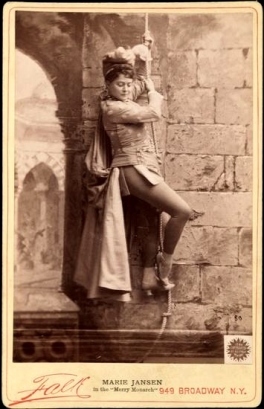 Marie Jansen, another fencing student of Colonel Monstery’s, is pictured here scaling a castle wall for her role in “The Merry Monarch.” The New York Herald of February 1, 1891, reported that “Marie Jansen lost ten pounds in three weeks under Colonel Monstery.” In an 1888 issue of the Daily Inter Ocean, Monstery recounted: “Marie Jansen was a pupil of mine. She was quite an expert fencer, but grace of movement is her forte. She moved like a—ah, what shall I say?—a swan. Her pose, her graceful methods of parry and of thrust are enough to enchant an antagonist.”
Marie Jansen, another fencing student of Colonel Monstery’s, is pictured here scaling a castle wall for her role in “The Merry Monarch.” The New York Herald of February 1, 1891, reported that “Marie Jansen lost ten pounds in three weeks under Colonel Monstery.” In an 1888 issue of the Daily Inter Ocean, Monstery recounted: “Marie Jansen was a pupil of mine. She was quite an expert fencer, but grace of movement is her forte. She moved like a—ah, what shall I say?—a swan. Her pose, her graceful methods of parry and of thrust are enough to enchant an antagonist.”
Jansen was born in Boston in 1857. She would go on to star in a number of successful comic operas, Edwardian musical comedies, and comic plays in New York, Boston, Philadelphia and London during the 1880s and 1890s. Later in her career, she performed in vaudeville and formed her own touring theatre company.
More about Jansen’s life can be read about here.
Ella “Jaguarina” Hattan (b. 1859)
Ella Hattan, better known by her nom-de-guerre “Jaguarina,” was Colonel Thomas Monstery’s most accomplished student. Born in 1859 in Ohio, she would go on to become widely regarded as one of the greatest swordswomen of the nineteenth century, and perhaps of all time.
When Monstery presented Hattan to the world in early 1885, he “pronounced her the equal of any swordsman in America barring none, she seemingly having a wrist of steel and muscles of iron under a velvet skin.” This statement would prove prophetic, as Hattan would go on to defeat more than 60 men (half of them fencing masters) on horseback and on foot. Decades later, Hattan recounted that her training under Monstery was harsh—so much so that in three years her teacher “had never given her one word of encouragement,” he being “determined that she should learn confidence by experience and hard knocks.” Yet Hattan was also quick to give Monstery credit for his abilities. Prior to her contest with Sergeant Owen Davis, in an 1887 interview, she stated that “with the exception of Colonel Monstery, Sergeant Davis and Captain Jennings were probably the best [swords]men she had met.” Years later, in 1896, Monstery would return the compliment, reportedly averring that “Jaguarina is undoubtedly the greatest woman fencer that ever lived.”
For more details of Hattan’s extraordinary career, her training, and her lengthy master-student relationship with Monstery, see this article.
Mildred Holland (1869-1944)
 Mildred Holland is pictured here in her 1904 role as Catherine the Great. Next to Ella Hattan, Holland was one of Monstery’s best known students and a “champion” of many fencing contests.
Mildred Holland is pictured here in her 1904 role as Catherine the Great. Next to Ella Hattan, Holland was one of Monstery’s best known students and a “champion” of many fencing contests.
In the Dec. 9, 1888 issue of the Inter Ocean,
“Colonel [Monstery]…confesses that [Holland] is often a match for his superior skill. ‘Can ladies fence! Well, did you not see Miss Mildred kill me then? Ladies, when trained, are perfect artists with the foils.’”
Mildred Holland would later become a respected fencing instructor in her own right. In 1895 she presided over exhibitions of rapier and dagger in New York City, and delivered lectures on “the Art of Defense” for women, “Referring Especially to Umbrellas in the Hands of Experts.”
During the 1890s, Holland held bouts of rapier and dagger fencing in New York City, and lectured on women’s self defense. Following is an excerpt from a period article, with images, about Holland’s training under Monstery, published in the New York World on June 22, 1890:
“Miss Holland is not a social star, but a hard-working student. Self-reliance, grit and confidence in her own capabilities are elements which have sustained the little lady in her ambition. She is not rich, and her tuition was secured by her well-saved earnings. Her pluck has been demonstrated by her wonderful dexterity with the foils.
“In this accomplishment she is a pupil of Col. Monstery, is accounted one of the most expert swordswomen in the United States and is the possessor of two gold medals for efficiency, one of which was won two years ago at a contest and presented to the fair champion by Lieut. Gov. Smith. Holland makes a series of rapid, graceful attitudes. The little white wrist is as firm and flexible as steel, the ankle well turned and solid, and the head gracefully poised, She is quick in her motions, exhibiting litheness, grace and precision. Her recoveries are rapid, her eye true, and she enters into her work with striking coolness and nerve. Col. Monstery says she is a wonder and the Conservatory is proud of its champion, for, in addition to her trophies, she defeated by six points Miss Anna Schaffer, one of the professional Viennese swordswoman. Miss Holland is modest of her achievements.
“‘I began fencing when I entered the Conservatory,’ said she. ‘It is part of the instruction. Its object is to train the muscles of the entire body, to develop flexibility and to give one a facility of poses that cannot otherwise be attained. Then you know it strengthens the lungs, trains the eyes, and, I think, cultivates one’s courage. You know it takes courage to appear properly before an audience, and I am sure my ‘faculty’ of courage has developed since I began fencing.'”
Lola Montez (1821–1861)
 “Lola Montez,” in actuality Marie Dolores Eliza Rosanna Gilbert, Countess of Landsfeld, was an Irish dancer and actress (born in Limerick) who became famous as a “Spanish dancer,” courtesan, and actress. After performing in various European capitals, she settled in Paris, where she was accepted in the rather Bohemian literary society of the time. After the 1845 death of her lover, newspaperman Alexandre Dujarier, in a duel (unrelated to her), she left Paris, and became mistress of King Ludwig I of Bavaria, who made her Countess of Landsfeld. She used her influence to institute liberal reforms in Germany. At the start of the Revolutions of 1848 in the German states, she was forced to flee. She proceeded to the United States via Switzerland, France and London, returning to her work as an entertainer and lecturer.
“Lola Montez,” in actuality Marie Dolores Eliza Rosanna Gilbert, Countess of Landsfeld, was an Irish dancer and actress (born in Limerick) who became famous as a “Spanish dancer,” courtesan, and actress. After performing in various European capitals, she settled in Paris, where she was accepted in the rather Bohemian literary society of the time. After the 1845 death of her lover, newspaperman Alexandre Dujarier, in a duel (unrelated to her), she left Paris, and became mistress of King Ludwig I of Bavaria, who made her Countess of Landsfeld. She used her influence to institute liberal reforms in Germany. At the start of the Revolutions of 1848 in the German states, she was forced to flee. She proceeded to the United States via Switzerland, France and London, returning to her work as an entertainer and lecturer.
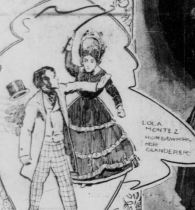 The Trenton Evening Times reported that:
The Trenton Evening Times reported that:
“Lola Montez was skillful with both pistol and rapier…She once challenged a journalist at Grass Valley, California, to meet her with pistols according to prevailing rules governing such meetings, and, upon his refusal to do so thrashed him with a cowhide upon a public street.”
The article pictured here, with Lola’s challenge to duel in California, was published in the Richmond Whig of August 16, 1853.
Montez challenged at least two men to duels with poison pills, and at least one with the pistol (see picture). Another of her challenges (to an insulting French editor of the Lyons Constitutionnel, in 1851) reads:
“If you continue, sir, I will be obliged to send you my card, and my seconds, to put an end to your ridiculous animosity; but it will not be with pistols; I am more generous in a combat. I will offer you two pills in a box, one of them will be poisoned; and you will not be able to refuse a duel with arms that are so familiar to you. I have the honor of saluting you.”
In 1860, it was reported, erroniously, that Lola was killed in a duel at San Juan de Niblo.
Montez seems to have become a student of Monstery’s rather late in her life, which was cut tragically short by a stroke in 1861. In the November 30, 1886 issue of the Daily Inter Ocean, Monstery recounted
“an incident of a combat between the elder [Junius] Booth, who was the champion amateur swordsman of his time and himself, on an occasion of [Monstery’s] benefit in San Francisco a number of years ago. While the fight was on Lola Montez, who was one of the Colonel’s pupils, occupied a conspicuous box. During the bout she became so interested that she arose in her place, utterly forgetting where she was, and went through the movements as though actually one of the combatants on the stage. Of course her carrying on the imaginary combat attracted the notice of the house, which with divided attention cheered alternately the excited Lola and the two on stage.”
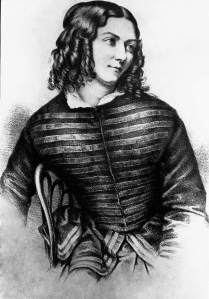 In America, Montez eventually gave up acting and gave lectures on “Gallantry, Heroines of History and other subjects.” She was highly critical of the “Modern Women’s Right Movement.” Montez felt that rather than lobbying men to give them more rights, women should endeavor to become strong and powerful themselves. Following are but a sampling of her statements:
In America, Montez eventually gave up acting and gave lectures on “Gallantry, Heroines of History and other subjects.” She was highly critical of the “Modern Women’s Right Movement.” Montez felt that rather than lobbying men to give them more rights, women should endeavor to become strong and powerful themselves. Following are but a sampling of her statements:
“One or two hundred women getting together in a convention and resolving that they are an abused community, and that all the men are great tyrants and rascals, proves plainly enough that they the women are somehow discontented, and that they have, perhaps, a certain amount of courage, but I can not see that it proves them to have any remarkable strength of mind. Really strong-minded women are not women of words but of deeds, not of resolutions but of actions.”
“History is full of such examples, which indicate the courage and intellect of woman, and her right to claim equality with the harder sex whenever Heaven has imparted to her the gift of genius. I can hardly see how it is possible that any woman of true genius should ever feel the necessity of calling together conventions for the purpose of resolving that she is abused. One woman going forth in the independence and power of self-reliant strength to assert her own individuality, and to defend, with whatever means God has given her, her right to a just portion of the earth’s privileges, will do more than a million of convention-women to make herself known and felt in the world.”
“There is a class of heroines who have been more powerful in the world than the mighty women of the sword or of the pen. I mean those who have united great personal beauty with rare intellectual powers! In such women there is a power stronger than strength. The annals of Greece and Rome, from the memorable days of Troy, down to the Roman age, furnish nothing more remarkable than the omnipotent sway of female genius and beauty in the affairs of the world.”
“The Amazons were regular woman’s rights women; for they made laws by which the women were enjoined to go to the wars, and the men were kept at home in a servile state, spinning wool and doing all manner of household work. No woman was allowed to marry till she had slain at least one enemy on the battle-field. The right breasts of all the female children were seared with a hot iron, in order to give the freest use of the right arm in wielding the sword or in shooting arrows; and they even debilitated the arms and thighs of the male children, that they might be rendered unfit for war. That, I should say, was carrying the woman’s rights question to an extent that ought to satisfy even our modern agitators. But in justice to these terrible Amazon women, it must be confessed that the world has never known better and braver warriors than they.”
With declining health, she finally moved to Brooklyn, New York, where she lived until her death. She spent her last days in rescue work among women.
More about Montez’s extraordinary life can be read about here.
Adele Belgarde (1867-1938)
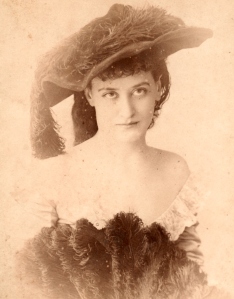 Born in Mississippi, Adele Belgarde (actual name Adelaide Levy) starred in a number of theatre productions in New York City during the late 1870s. She initially came to Monstery to learn fencing in order to prepare for her starring role in “Hamlet.” She would also star in “Romeo and Juliet” and would play Queen Elizabeth. In 1895-1896, Belgarde toured with Thomas W. Keene, the famous Shakespearean tragedian, playing Lady Anne to his Richard III. She also played Marie to his Louis XI. She would go on to star in at least one silent film titled “Happiness” in 1910.
Born in Mississippi, Adele Belgarde (actual name Adelaide Levy) starred in a number of theatre productions in New York City during the late 1870s. She initially came to Monstery to learn fencing in order to prepare for her starring role in “Hamlet.” She would also star in “Romeo and Juliet” and would play Queen Elizabeth. In 1895-1896, Belgarde toured with Thomas W. Keene, the famous Shakespearean tragedian, playing Lady Anne to his Richard III. She also played Marie to his Louis XI. She would go on to star in at least one silent film titled “Happiness” in 1910.
She died in 1938 and is buried in Forest Lawn Memorial Park, Glendale, Los Angeles County, California.
Maude Forrester
Maude Forrester was a lesser-known English actress who also, along with Ada Isaac Menkan, starred in “Mazeppa.” Under Monstery she became “quite proficient” in fencing. She was also billed as a “celebrated equestrian actress” who was known for her “matchless impersonation of Mazeppa! accompanied by [the] celebrated and highly trained steed, ‘Lightning’,” and was “universally recognised as Queen of the Amazons at the Alhambra before the advent of the colossal Marian of ‘the Praerafaellite maxillary angle’.” She also played the title role in Lady Godiva.
Pauline Kelly
Not much is known about Pauline Kelly. A number of references indicate that she was a pupil of Monstery’s while studying at Kayzer’s Conservatory in Chicago. She was “regarded in Chicago as a very promising and gifted young actress.” Monstery described her as an “expert fencer.”
Mabel Marsh
Miss Mabel Marsh learned fencing under Monstery at his Chicago salle d’armes on Randolph Street, where she often crossed blades with fellow actress and prodigy Mildred Holland. A detailed, firsthand account of Marsh’s training under Monstery can be found on pages 24-26 of the Introduction to “Self-Defense for Gentleman and Ladies” by Col. Thomas H. Monstery. These pages can be read in the free online preview of the book on its Amazon page.
Colonel Thomas H. Monstery‘s martial wisdom survives in his treatise on Boxing, Kicking, Grappling, and Fencing with the Cane and Quarterstaff, which was recently published by North Atlantic Books in book form for the first time. This volume contains a new, detailed biography of Monstery, and includes additional writings by the Colonel.
This article © 2015 by Ben Miller.
Additional articles about Colonel Monstery:
A Grand Assault-of-Arms in Old New York, directed by Col. Thomas Monstery
Colonel Thomas H. Monstery and the Use of the Quarterstaff
The Victorian Gentleman’s Self-Defense Toolkit
A Bare-Knuckle Fight at Colonel Monstery’s
This historically important film shows children demonstrating martial arts techniques on Mott Street in Chinatown, New York City, on or around January 29, 1930. This footage was recently discovered by Rodney Bennett of Anglesea, Australia.
“It doesn’t at all follow that because you hit your adversary you are right: you may be utterly wrong. The small sword is so excessively light and so excessively deadly that to be always rushing in and trying to precipitate yourself on your opponent is madness. In the twinkling of an eye you may have six inches of cold steel in you.” – Egerton Castle
Egerton Castle (1858-1920) was a British swordsman and antiquarian, probably best-known for his reconstruction of historical fencing methods during the late nineteenth century. His 1885 book, Schools and Masters of Fence, from the Middle Ages to the Eighteenth Century, is still regarded as a standard reference on fencing history that has yet to be surpassed.
The following interview was given by Castle in 1898, and appeared in the March 9 issue of Chums Magazine.”
Click below to enlarge the image, and read the article in full:
A newly penned article about what classical fencing is and is not (as well as info regarding different styles of nineteenth century fencing), by Russell Hogg, instructor at the Cote du Golfe School of Fencing.
Continued from PART III.
MANLY EXERCISES. THE BROADSWORD AND SINGLE-STICK.
IV.
ATTACK AND DEFENCE.
THIS portion of our studies must be gone through in strict accordance with the rules we have laid down in our first paper. “Keep your temper,” and “Play fairly,” are two phrases which must never be forgotten throughout this exercise.
Commence by drawing swords, according to the directions given at p. 101. Having done so, proceed to acknowledge each others’ presence by the act of courtesy called
THE SALUTE,
which is to be performed as follows :—Raise your single-stick until the hilt is just below the chin, the stick perpendicular, edge to the left, your thumb extended on the side of the handle, your elbow close to your body; your left pendent upon the left side. See Fig. 1, and the directions for “Recover Swords,” at p. 101.
Next raise your left arm as high as your shoulder, and bring your hand round by a circular motion over your eyes, your knuckles uppermost, and your fingers extended; at the same time you lower your weapon and your right arm to its full extent, to the right, the edge of the sword falling towards the left, your right elbow close to your side. (See Fig. 2.) After neatly and gracefully making the salute, step towards your opponent, and proceed to “Prove Distance.” (See p. 102.) If you have taken up a proper distance, the point of each stick should touch the guard of the other.
Join sticks, which should cross each other about eight inches from the point, with the “Single Attack” and the “Inside Guard.”
Change to the “Outside Guard.”
FIRST COMBAT.
Make “Cut One” at the left cheek, which your opponent meets with “First Guard.”
 Your opponent gives “Cut Two” at your right cheek, which you guard with “Guard Two.”
Your opponent gives “Cut Two” at your right cheek, which you guard with “Guard Two.”
Make “Cut Three” at your opponent’s wrist, to which he will reply with “Third Guard.”
Opponent gives “Cut Four” at your leg; your defence being “Fourth Guard.”
You make “Cut Five” at opponent’s left side, which he meets with “Fifth Guard.”
Opponent replies with “Cut Six” at your right side, which you defend with “Sixth Guard.”
Make “Cut Seven” at opponent’s head, his defence being “Seventh Guard.”
Throughout this engagement there must be no flinching or jumping about; protection against each cut must be obtained by the stick, and not by the inglorious use of the legs—in jumping backwards or upon one side. At the same time, it must be borne in mind that every cut is to be given so lightly, that if it be not warded off by the proper guard, and is thus enabled to fall upon the body, it cannot hurt. This combat is to be renewed until both adversaries are perfect in every cut and guard.
SECOND COMBAT.
Join sticks upon the outside guard.
Yourself.—“Cut Four” at opponent’s leg. Opponent.—“Fourth Guard.”
Opponent.—“Cut Six” at your neck. Yourself.—“Sixth Guard.”
Yourself—“Cut Six” at opponent’s leg. Opponent.—“Sixth Guard.”
Opponent.—“Cut Five” at your neck. Yourself. —“Fifth Guard.”
Yourself.—“Cut Five” at opponent’s leg. Opponent.—“Fifth Guard.”
Both.—Resume the position of “Guard,” and afterwards that of “Slope Swords.” Repeat the combat till perfect.
THIRD COMBAT.
Both come to the position of “Guard.”
Yourself.—“Cut Seven” at opponent’s head. Opponent.—“Seventh Guard.”
Opponent.—“Cut Seven” at your head. Yourself.—“Seventh Guard.”
Yourself—“Cut Four” at opponent’s leg. Opponent.—“Seventh Guard.”
Opponent.—“Cut Four” at your leg. Yourself.—“Seventh Guard.”
Yourself. —“Cut Seven” at opponent’s head. Opponent.—“Seventh Guard.”
Opponent.—“Cut Seven” at your head. Yourself.—“Seventh Guard.”
Return to “Guard.” Resume the position “Slope Swords.”
This combat to be repeated several times.
FOURTH COMBAT.
Join sticks, and form guards as explained in first combat.
Yourself.—“Cut Seven” at opponent’s head. Opponent.—“Seventh Guard.”
Opponent.—“Cut Seven” at your head. Yourself.—“Seventh Guard.”
Yourself.—“Cut Two” at opponent’s arm. Opponent.—“Guard Two.”
Opponent.—“Cut Seven” at your head. Yourself.—“Seventh Guard.”
Yourself.—“Cut Seven” at opponent’s head. Opponent.—“Seventh Guard.”
Opponent.—“Cut Two” at your arm. Yourself.—“Second Guard.”
Yourself.—“Cut Seven” at opponent’s head. Opponent.—“Seventh Guard.”
Opponent.—“Cut Seven” at your head. Yourself.—“Seventh Guard.”
Yourself.—“Cut Six” at opponent’s right side. Opponent.—“Guard Six.”
Opponent.—“Cut Seven” at your head. Yourself.—“Seventh Guard.”
Yourself.—“Cut Seven” at opponent’s head. Opponent.—“Seventh Guard.”
Opponent.—“Cut Six” at your right side. Yourself.—“Sixth Guard.”
Both return to position of “Guard.” Both resume position of “Slope Swords.”
CONCLUDING OBSERVATIONS.
We have now gone through the whole of the Broadsword and Single-Stick Exercises; but before taking leave of our subject we wish to make a few observations either general, or as further illustrating some of the more difficult portions of the study we have been going through with our pupils. The proper execution of the Cuts and Guards lies at the foundation of all good Single-Stick or Broadsword play. If the cuts are not given in the proper direction, if the guards are not formed precisely after the manner shown upon the target delineated at p.100, none of our pupils need expect to become formidable against an adversary, or secure against scientific attack.
It being our object to smooth away every difficulty, to anticipate every obstacle, that may arise in our series of “Manly Exercises,” we have gone carefully through the three parts of the Broadsword Exercises already published, with the view of endeavouring to find out anything that might appear obscure or insufficiently explained. The motions, positions, construction of the target, and the rules for the selection of weapons, we find require no further comment; but as the execution of the cuts and guards needs such careful study, we think it advisable to add a few remarks, additional and explanatory, to those already furnished at p. 101.
We will suppose ourselves to be placed in front of the target, at the proper distance, and in the First Position. We are now ready for what we shall term the
FINAL TARGET DRILL.
At the order “Cut One,” you make a stroke diagonally through the target; the cut commencing at that point marked 1 in our illustration [of the target] given at p. 100, and coming out at 4. When the point of the stick has cleared the target, you, by a turn of the wrist, bring the weapon up to the left shoulder, with that part of it tuned the edge towards the left.
At the order “Cut Two,” proceed as in the foregoing manner, but commence at 2 and terminate at 3. At the finish of the cut, the wrist should he a few inches outside and below the right hip.
At the order “Cut Three,” cut upwards, diagonally, beginning at point 3 and terminating at point 2.
At the order “Cut Four,” cut upwards, diagonally, commencing at point 4 and terminating at point 1.
At the order “Cut Five,” cut horizontally through the target, from right to left, beginning at point 5 and concluding at point 6.
At the order “Cut Six,” cut horizontally through the target, from left to right, commencing at point 6 and terminating at point 5. After the cut, continue the sweep of the single-stick until you bring the hilt above your head; the edge of the stick upwards, the point hanging over the back.
At the order “Cut Seven,” execute, from the preceding position, a downward stroke, vertically, from point 7 to the centre of the target.
The positions of the guards require no explanation further than those already given: in making an enlarged copy of the target we have supplied, it must, however, be remembered that no deviation in the directions of the guard can be allowed.
As in the words of command given for the Rifle Exercises in our last volume, it is necessary to remember that the first portion of the word is cautionary only; and that no movement is to be made until the last syllable is given.
THE BROADSWORD AGAINST BAYONET
is the name of the exercise we are about to append; but, according to our safe system of performing it, it becomes the exercise of Single-Stick versus Broomstick. One boy takes the single-stick, another an ordinary broomstick, which latter must be supposed to represent a rifle with its bayonet fixed. The adversaries take up a position about three paces distant from each other. The swordsman assumes the position of “Outside Guard.” (See directions and Fig. 6, p. 104. [Editor’s note: for convenience, this image has been added below.])
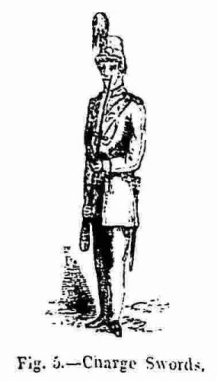 The bayoneteer also comes to the position of “Guard,” which is performed thus: In the first instance, fall into the attitude termed “Charge Swords” in the Rifle Exercises. (See the directions and illustration given at p. 364, vol. vi., of the BOY’S OWN MAGAZINE [Editor’s note: this image has been added to the right].) In the next place, lower the right wrist upon the upper part of the right hip, and at the same time bring the left elbow close to, and in front of, the body. In that position the broomstick will be grasped with the right hand within about six inches of its end, while with the left hand it will be seized about the middle of its entire length. The broomstick should be held in a horizontal position, with its point directed towards the height of the swordsman’s breast.
The bayoneteer also comes to the position of “Guard,” which is performed thus: In the first instance, fall into the attitude termed “Charge Swords” in the Rifle Exercises. (See the directions and illustration given at p. 364, vol. vi., of the BOY’S OWN MAGAZINE [Editor’s note: this image has been added to the right].) In the next place, lower the right wrist upon the upper part of the right hip, and at the same time bring the left elbow close to, and in front of, the body. In that position the broomstick will be grasped with the right hand within about six inches of its end, while with the left hand it will be seized about the middle of its entire length. The broomstick should be held in a horizontal position, with its point directed towards the height of the swordsman’s breast.
The next movement is “Prove Distance,” which is performed by each opponent thrusting forth his weapon until it lightly touches the breast. This done, both resume the position of “Guard.”
Bayoneteer—Make a thrust at the upper part of swordsman’s breast. Swordsman.—Defend by the “First Guard.”
Bayoneteer.—Return to the position of “Guard” as above explained. Swordsman. —Assume the position of “Slope Swords.”
Bayoneteer.—Come to “Shoulder Arms.” (See directions and illustration given at p. 362, vol. vi., BOY’S OWN MAGAZINE [Editor’s note: this image has been added below to the left]).
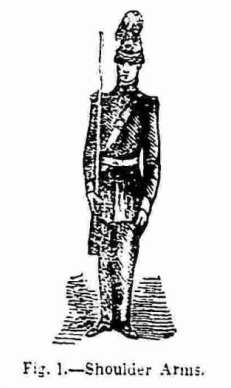 Bayoneteer.—Come to the position of “Guard.” Swordsman.—Come to the position of “Outside Guard.”
Bayoneteer.—Come to the position of “Guard.” Swordsman.—Come to the position of “Outside Guard.”
Bayoneteer.—Make a thrust at swordsman’s breast. Swordsman.—Defend by the “Fifth Guard,” and raise the left hand ready to seize the rifle and bayonet—in the other words, the broomstick. Next grasp the weapon with the left hand and force it down, at the same time bringing forward the left leg. Finally, assume the position to deliver “Cut Six.”
Swordsman. — Relax hold upon the broomstick, and assume the position of “Guard.” Bayoneteer.—Assume the position of “Guard.”
In the preceding mimic encounter the swordsman has achieved the victory; for he has obtained possession of his opponent’s weapon, and has brought his own into play, ready to give “Cut Six” at his adversary; which, cut, being a horizontal one, and directed at the throat, might, were the swordsman armed with a sharp weapon, and had he strength, determination, and skill enough, cut off bayoneteer’s head at one blow. Bayoneteer must, however, be done justice to, and accordingly we will explain how he may defend himself against the above unpleasant termination. The whole of the above exercise is to be gone through precisely as already explained; but when swordsman brings forward his left hand to grasp the broomstick, bayoneteer foils him by assuming the position termed “Shorten Arms,” which is performed in this way: The right arm is thrown back to its full extent, the left arm also being carried back—both hands still retaining the hold upon the weapon, which, in consequence of the movement thus made, is brought backward in a horizontal position across the upper part of the chest, until not more than a fourth of its length projects beyond the bayoneteer’s left shoulder, and is, in consequence, quite out of reach of the swordsman.
The exercise then terminates by swordsman assuming the position or “Slope Swords,” and bayoneteer that of “Shoulder Arms.”
In conclusion, we must again impress upon our pupils the necessity for always making use of the mask in these exercises. One of the best draughtsmen of the present day, who is also a very fine swordsman, lost the sight of one of his eyes through neglect of this necessary precaution. We are only acquainted with two modern treatises upon the broadsword. These lessons constitute the third work upon the subject; and we feel a certain amount of satisfaction, and are egotistical enough withal, to state that our work is the only one that could be placed in the hands of boys. We will explain how this is. The first work is solely for use in her Majesty’s Army. In it, swords, bayonets, and an elaborate and complicated system of drill are employed; consequently it would be as useless as dangerous to our pupils. Work number two is founded upon the military manual, and is dangerous, useless, and moreover absurd, for it employs the sword instead of the single-stick; and, among other mistakes, contrives upon one occasion to get the swordsmen in position one exactly behind the other; after which it proceeds to give a long series of cuts and guards, which are all very nice for the person in the rear, because he has an opponent turned with his face, hands, and weapon completely away from him; but as for the unfortunate individual in front—he can only “cut and guard” at the air in return for the castigation he is receiving from his adversary behind his back. Work number three is our own. It is founded upon the system in use in the British Army; but, by being cleared of complications, unnecessary drilling, and by recommending the use of harmless weapons, it constitutes the art of Broadsword at once safe, certain, and valuable as a “Manly Exercise” for those who wish to become skilful, graceful, and strong men, without paying the penalty of losing an eye, or having the muscles of their arms divided, for these same advantages.
[Transcribed and edited by Ben Miller, 2017]
Here ends this series. More vintage articles on self-defense can be accessed on our Resources page.
Continued from PART II.
THE BROADSWORD AND SINGLE-STICK.
III.
THE TARGET.
THE first thing to be done is to construct a target for ourselves. Procure a stout sheet of cartridge-paper, about four feet square; lay it upon a table, and proceed to describe a large circle upon it as follows:—Insert at the central point, marked O in our illustration, a strong drawing-pin, or, still better, a small brad-awl; tie upon this a piece of string about twenty-four inches in length. Upon the other end of the string affix a pencil; draw the string tight, so that it shall correspond with the line coming from the centre and reaching the circle, at the point marked “cut 7” in our drawing of the target. Keeping the string tightly drawn out, describe a circle upon the paper; next remove the string, and with a straight piece of wood draw the lines from the centre to the edge of the circle precisely as they occur in our illustration. When you have drawn the circle and the black lines which converge from it to the centre, go over them with a brush filled with red paint. You have now the dotted lines to fill in; and as these are to be less prominent than the former, you will fill them in with thin lines of a green colour—of course drawing them in the exact positions given in Fig. 1. To complete our target, we must draw in, at one end of each of the green lines, the hilt of a sword. Your target is now complete; and at a glance you will see that the thick black lines denote the seven “cuts;” and that the thin green lines, with a sword-hilt attached to them, mark the inclination of the seven “guards.”
[Editor’s note: As the above illustration is nearly illegible, reproduced below is a nearly identical target, published in Abstract of cavalry movements: intended for the use of the volunteer corps of Upper and Lower Canada. ([Montreal]: 1839)].
WHERE TO PLACE THE TARGET.
The target may be fixed in any spot which will afford plenty of space wherein to execute the positions, guards, &c. A garden or a field will serve your purpose perfectly. If you choose a garden, the wall, or if a field, a tree, will form a support for your target, which is to be fixed so as to have its centre o about the height of your breast. From below that centre a line is to be drawn upon the ground, directly in front and at the distance of about ten feet, whereon you most take your stand in the position of “ATTENTION,” with your left heel on the line, so that when you turn to the “FIRST POSITION” your right foot may cover it.
EXPLANATION AND USE OF THE TARGET.
In our illustration you will perceive there are seven cuts and guards. The “cuts” are directed through the centre, distinguished by lines, and named according to that number from which each cut commences. The “guards” are executed by holding your stick opposite to, and in the direction of, the dotted lines of our drawing and the green ones of your target. You must be exercised in performing every cut and guard in exact accordance with the lines drawn upon the circle; and there must be no variation in your practice until you have gained the proper direction of the cuts as well as the inclination of the stick and position of the wrist in forming the “guards.” You must, however, remember that the target merely directs you how to form the “cuts” and “guards,” not precisely where, as that will depend upon how your adversary acts when attacking you. The cuts 1, 3, and 5, may be directed at any part, from head to foot, on the left; and the cuts 2, 4, and 6, equally so on the right; the former being termed “inside,” and the latter “outside” cuts. One, three, and five, are the corresponding “Inside guards;” and two, four, and six, the “Outside guards.” You will now perceive that your target is a sure guide and reference for correctly forming the guards, and giving a proper direction of the edge in executing the cuts.
When you have thoroughly mastered all the cuts and guards, you may take your stick in hand. But let us first of all become acquainted with its strong and weak parts. The Fort (strong) is the half of it near the hilt; the Foible (weak) the half towards the point. A knowledge of these distinctions is very material either in giving or guarding a cut; and much depends upon their proper application. From the hilt upwards, in opposing your adversary’s stick, the strength of the defence decreases in proportion as the cut is received towards the point; while, on the other hand, it increases from the point downwards.
Always seek to gain your opponent’s Foible with your own Fort. All your cuts should be given within eight inches of the point, so that your stick may clear itself. When delivering a cut always seek your adversary’s Foible, as that will, as a matter of course, force his guard.
STICK PRACTICE
commences with the order,
“DRAW SWORDS.”—Seize your stick with your left hand, just below the hilt, which should be raised as high as your hip; bring your right hand smartly across your body, grasping the stick at the hilt, and turning it at the same time to the rear; raise your hand the height of your elbow, your arm being close to your body. Now draw the stick through your left hand, as though you were drawing a sword from its scabbard, by extending your arm, the edge being to the rear; lower your hand until the hilt falls just below your chin, the stick perpendicular, the edge to the left, with your thumb extended on the side of the handle, your elbow close to your body. This forms the position, “RECOVER SWORDS.”
Lower your wrist below, and in line with, your right hip, your elbow being drawn back, your arm extended as much as can be done with ease; your hand lightly grasping the stick, but prepared, by a contraction of the fingers, to resume a firm hold. The upper portion of the stick will then be in the hollow of your right shoulder, with its edge to the front; or, in other words, the position of “CARRY SWORDS.”
When the stick is drawn, your left hand falls into the position of “ATTENTION.” At the order, “SLOPE SWORDS,” bring your hand to the front, in line with your elbow, which must fall close to your body; the stick resting upon your shoulder, its edge to the front.
At the order, “RETURN SWORDS,” carry the hilt to the hollow of your left shoulder (bringing your left hand to your side, as though in the act of raising the scabbard of your weapon), with the stick perpendicular; the back of your hand to the front. Next, by a quick turn of your wrist, drop the point of the stick as if it were about to enter the scabbard, turning the edge to the rear until the hand and elbow are in line with each other, square across your body.
At the order, “TWO,” press the stick down into your left hand until the hilt touches the thumb and forefinger.
At the order, “THREE,” bring your hands to the position of “ATTENTION.”
At the order, “DRAW SWORDS,” act as previously directed.
At the order, “SLOPE SWORDS,” execute the motion already described.
At the order, “PREPARE FOR SWORD EXERCISE,” turn your body and feet to the “FIRST POSITION;” your left hand resting upon your hip, the thumb to the rear. (See Fig. 2.)
At the order, “RIGHT PROVE DISTANCE,” “RECOVER SWORDS” with your forefinger and thumb stretched along the hand, your thumb being upon the back, and the end of the hilt in your right palm.
At the order, “TWO,” extend your arm to the right, and lower your stick in a horizontal direction from the shoulder; its edge to the rear; your left shoulder square to the front.
At the order, “SLOPE SWORDS,” act as before directed.
At the order, “FRONT PROVE DISTANCE,” elevate your stick as before; then step smartly out to the “THIRD POSITION,” and extend your arm—lowering the point of your stick towards the centre of the target, with its edge to the right. (See Fig. 3.)
At the order, “SLOPE SWORDS,” act as previously directed.
At the order, “ASSAULT,” elevate your arm to the front, with your wrist opposite No. 1, your elbow rather bent towards the centre of the circle, the back of your stick resting on your shoulder, near the point, with the edge inclined to the right.
At the order, “ONE,” extending your arm, direct the cut to the front, diagonally, from right to left, as marked on the target from 1 to 4; and as the point clears the circle turn your knuckles upwards, and continue the sweep of the stick so as to bring the point to the rear of the left shoulder, upon which it rests with its edge inclined to the left, and your wrist opposite No. 2.
At the order, “TWO,” direct your cut from 2 to 3, and turn the wrist so that your stick continues its motion until the point is below your right hip, the edge downwards, your elbow bent inwards, and wrist towards 2.
At the order, “THREE,” cut upwards in a diagonal line from 3 to 2; and continue the motion of your wrist until the point of the stick is below your left hip; the edge downwards; your elbow bent and elevated, with the wrist towards 1.
At the order, “FOUR,” make a cut upwards, in a diagonal line from 4 to 1; and turn your knuckles downwards, with the edge of the stick to the right, and the point to the rear, over the right shoulder; your elbow bent, your wrist towards 5.
At the order, “FIVE,” make a horizontal cut from 5 to 6, and turn the knuckles up, with the edge of the stick to the left, and the point to the rear, over your left shoulder; your elbow bent, your wrist turned towards 3.
At the order, “SIX,” make a horizontal cut from 6 to 5, and bring your hand in the direction of 7; your sword being on the same line, over the head; its point lowered to the rear, its edge uppermost.
At the order, “SEVEN,” cut down vertically from 7 to the centre of the circle, and remain with your arm extended; placing your thumb along the back of the handle; your left shoulder pressed well back.
At the order, “DEFEND,” take the “FIRST GUARD” by turning the edge of your stick to the left, your thumb resuming its grasp of the handle, and draw in your elbow close to the body; your wrist being kept to the front, and your stick placed opposite the dotted diagonal line shown on the target from the hilt, marked “FIRST GUARD.” In this and the succeeding guards, distinguished as “SECOND,” “THIRD,” &c., the point should be advanced rather to the front, your left shoulder being well kept back in the guards to the left, but rather brought forward in those to the right, as also in the “SEVENTH GUARD.”
At the order, “SECOND,” turn your wrist with your knuckles uppermost, and the edge of the stick to the right, your stick being placed opposite the diagonal line marked “SECOND GUARD.”
At the order, “THIRD,” turn your wrist and edge to the left, nearly as high as your shoulder, with the point lowered to the right, the sword placed as marked, “THIRD GUARD.”
At the order, “FOURTH,” elevate your elbow, and turn your wrist and edge to the right, with the point to the left, precisely as shown in the target, marked “FOURTH GUARD.”
At the order, “FIFTH,” turn the edge to the left, with your wrist as high as your shoulder to the front and left of your body, the stick being placed opposite the perpendicular line, marked “FIFTH GUARD.”
At the order, “SIXTH,” bend your wrist, and turn the edge of your stick to the right, so as to bring it opposite the perpendicular line, marked “SIXTH GUARD.”
At the order, “SEVENTH,” elevate your wrist above, and in advance of, your right ear, your elbow up and kept well back, your stick in the direction marked “SEVENTH GUARD.”
At the order, “PARRY,” lower your wrist nearly close to your right shoulder, the edge of the stick to the right, your hips well pressed back, and with the hilt of your weapon opposite 1.
At the order, “SECOND MOTION,” turn your wrist so that your stick-point falls towards the left rear, and, forming a circle from left to right of your body, resumes its former position.
At the order, “SLOPE SWORDS,” proceed as before directed. The SEVEN CUTS should also be gone through in the following manner:—
At the order, “ASSAULT,” they should be combined in regular succession without any material pause between each, or, by a proper and neat turn of the wrist, the cuts will lead into each other. The cuts should be given with force, with the edge leading forwards, the wrist retaining its direction to the front as much as possible; and in returning to prepare for another cut, the edge should be drawn back in nearly the same line, your arm being slightly bent, so as to allow free play to your wrist, elbow, and shoulder, in giving due effect to the force of the cut, and then extended to the utmost in the delivery of it.
In order to enable you to carry the edge well in making the assault, you should practise a combination of the cuts one and four, repeating them several times, as well as two and three, five and six, taking care that the edge leads in the respective lines of the target, your wrist being darted towards the centre in each cut.
We have now to study the GUARDS.
At the order, “GUARD,” advance the point of your stick, extending your arm towards the centre of the target, with the edge downwards. Next, without pause, bending your body, drawing in your chest and neck, and bringing your left shoulder a little forward, step out smartly to the “SECOND POSITION,” with your elbow bent and raised, so as to have your hand nearly above the right foot; the edge of the stick turned upwards, with the point lowered and inclined to the left, the target distinctly seen within the angle formed by your arm and stick, the hilt being inclined to 1, and the point directed below and to left of 4. (See Fig. 4.)
At the order, “INSIDE GUARD,” elevate your head and body, lowering your wrist, with the knuckles down and over the foot, the point of the stick to the front, its edge to the left, your hand as low as the elbow, a little above, and in front of your hip, at the same time making the “SINGLE ATTACK” according to the directions already given. In this position your wrist must be inclined towards 4, and the point of the stick towards 1. (See Fig. 5.)
At the order, “OUTSIDE GUARD,” turn your wrist, with your knuckles upwards, and the edge of the stick to the right, repeating the “SINGLE ATTACK,” your hand inclining to 3, your stick-point directed towards 2. (See Fig. 6.)
As merely playing at cuts and guards with the sticks, without any definite intention, would be only so much waste of time, we will now append a course of combinations of those best calculated to advance the young broadswordsman in his attempts to gain a mastery of the art.
COURSE OF STICK-DRILL AND POSITIONS.
Execute in the following order:—Cut One and Third Position; First Guard and First Position ; Cut Two and Third Position; Second Guard and First Position; Cut Three and Third Position; Third Guard and First Position; Cut Four and Third Position; Fourth Guard and First Position; Cut Five and Third Position; Fifth Guard and First Position; Cut Six and Third Position; Sixth Guard and First Position; Cut Seven and Third Position; Seventh Guard and First Position. Guard according to directions already given; Slope Swords according to directions furnished above.
SECOND COURSE.
Guard, as already directed; Inside Guard, as already directed; Outside Guard, as before directed. The whole of the following cuts are to be given in the Third Position, after which you must, in every case, spring up to the First Position in forming the Guard. Cut Two and Second Guard; Cut Three and Third Guard; Cut Four and Fourth Guard; Cut Five and Fifth Guard; Cut Six and Sixth Guard; Cut Seven and Seventh Guard; Slope Sword according to directions already given.
THIRD COURSE.
Deliver the Outside and Inside Cuts from one to six, returning to Guard after each Cut; all the Inside Cuts to be given from the Outside Guards (see Fig. 6), and all the Outside Cuts from tho Inside Guard. (See Fig. 5.) In order to enable the young broadswordsman to form more readily and effectively any defensive position, the drill-instructor for the time being should practise him in making any cut and guard he may command, such cut and guard to be required out of the regular order. For example, instead of requiring him to execute the cuts and guards from one to seven in succession, he will give the word of command—Cut 3, cut 6, cut 1, cut 5, and so forth.
[Transcribed and edited by Ben Miller, 2017]
Continue on to PART IV of this series.
More vintage articles on self-defense can be accessed on our Resources page.
Continued from PART I.
THE BROADSWORD AND SINGLE-STICK.
II.
BEFORE placing the “single-stick” in your hand, it is our intention to put you through a short course of preliminary drill, the object of which is to teach you the free and active use of your limbs. When we have instructed you how to apply the full force of your muscular power, when we have demonstrated how you may best give proper effect to the “cuts and guards,” and finally, when we have indicated to you the best means of attaining to an easy pliability of strength in every position, both of attack and defence, then we shall allow you to arm yourself with your wooden representative of the sword, as you may then be considered to be in a position to employ it effectively.
In our next paper we shall take up our weapon; meanwhile, let us proceed to what may be termed the A B C of the sword exercise, the “Extension motions and positions,” the object of which is to expand your chest, raise your head, throw back your shoulders, and strengthen the muscles of your back.
The first thing to do is to fall into the position of “attention”—see our directions, page 215, Vol. VI., of the BOY’S OWN MAGAZINE. Cautionary word of Command.—“FIRST EXTENSION MOTIONS.”
ONE.—At this order bring your hands, arms, and shoulders to the front, fingers lightly touching at the points, the nails downwards. Next raise them in a circular direction well above your head, your finger ends still touching, your thumbs pointing to the rear, your elbows pressed back, your shoulders kept down. (See Fig. 1.)
TWO.—At this order separate and extend your arms and fingers upwards, forcing them back in an oblique direction until they come extended on a line with the shoulders; and, as you allow them to fall gradually thence to your original position of “attention,” endeavour as much as possible to elevate your neck and chest. (See Fig. 2.)
THREE.—At this order turn the palms of your hands to the front; press back your thumbs with your arms extended, and elevate them to the rear until they meet above your head, your fingers pointing in an upward direction, your thumbs locked, with the left in front. (See Fig. 3.)
FOUR.—At this order keep your arms and knees straight, and bend over until your hands touch your toes, your head being brought down in the same direction. (See Fig. 4.) Next resume the “third motion” by elevating your arms to the front.
FIVE.—At this order resume your preliminary position of “attention” according to the method indicated at “Two.”
All the preceding motions must be gone through slowly and deliberately, so as to feel the exertion of the muscles throughout. The First and Second should occasionally be performed with your head turned as much as possible to the right or left. After you have practised these motions often enough to go through them quickly and readily, you may execute them from first to last without any pause or separate word of command, so as to make them all lead into each other.
When you have mastered the “First Extension Motions,” you may proceed to execute the “FIRST POSITION,” which for greater clearness and simplicity, we will divide into three motions.
ONE.—At this order move your hands smartly to the rear, your left hand grasping your right arm just above the elbow, your right supporting your left arm beneath the elbow.
TWO.—At this order make a half face to the right, turning on your heels in such a manner that the back of the left touches the inside of the right heel, your head retaining its position to the front.
THREE.—At this order bring your right heel before the left; your feet being at right angles, your right foot pointing to the front, the weight of your body supported by your left leg. (See Fig. 5.)
When you have gone through the above frequently, you may proceed to take the next step in your education, this being the “SECOND POSITION” in two motions.
ONE.—At this order bend your knees gradually, keeping them as much apart as possible without raising your heels or shifting the erect position of your body. (See Fig. 6.)
TWO. — Step out smartly with your right foot about fourteen inches in line with your left heel; the weight of your body resting on your left leg, your right knee easy and flexible. (See Fig. 7.)
Let us now make another advance, and go on to the mastery of “THE BALANCE MOTIONS.” These are divided into four motions, and should be gone through in the following manner:—
ONE.—Move your right foot about seven inches to the rear of your left heel, your toe lightly touching the ground, your left heel perpendicular to it; your knees kept well apart. A glance at our illustration, marked Fig. 8, will at once show what we mean.
TWO.—At this order gradually raise your body by the extension of your left leg. (See Fig. 9.)
THREE.—At this order bend your left knee until, in point of fact, you resume the first motion. (See Fig. 8.)
FOUR. — At this order advance your right leg, and, with a smart beat of your foot, resume the “Second Position,” which was that from which you commenced the “Balance Motions.” (See Fig. 6.)
At the order, “First Position,” extend both your knees, and bring your right heel up to the left, assuming the position shown in our illustration, marked Fig. 10.
We will now execute the “THIRD POSITION,” which has two motions.
ONE.—At this order incline your right side to the front in such a way that your shoulder and knee shall be perpendicular to the point of your foot, keeping your body erect. (See Fig. 11.)
TWO.—At this order step out smartly to the front, about thirty inches, your right knee perpendicular to your instep; your left knee and foot kept straight and firm. Your heels must be in a line, your body erect, and your shoulders square to the left. (See Fig. 12.)
In this case, as in every other, repeat the motions we have described until you can perform them quickly and neatly. Having mastered all we have hitherto set before you, you may go on to the important “SECOND EXTENSION MOTIONS,” which you will execute in the following manner:—
ONE.—At this order throw your arms to the front of your body, your hands being closed, with the knuckles uppermost, and in contact with each other below the lower button of the waistcoat; next, gradually raise your wrists, bearing them inward the while, until they touch your breast, at the same time keeping your elbows up. Now force back your shoulders, so as to draw your hands apart; depress the elbows, and smartly extend your arms and fingers in a diagonal line, your right wrist being as high as your head, your elbows well kept down, and your thumbs pointing to the right. (See Fig. 13.)
TWO.—At this order elevate your body by extending your right leg, keeping your arms, wrists, and shoulders in the former position. (See Fig. 14.)
THREE.—At this order resume the position you fell into at the order “ONE,” by bending your right knee and advancing your body. (See Fig. 13.)
Supposing you to have gone through the foregoing movements at the command of a “Drill-instructor,” it will be the duty of the latter to come forward after the execution of each order, and prove the stability of your posture by slightly, but firmly, pressing upon your shoulders in each position. This pressure you should be able to bear without losing your position, at the same time there should be no unnecessary rigidity of pose, for you must remember that the object of the drill is to give the necessary flexibility to enable you to advance upon or retreat from your adversary.
But, as by this time you are somewhat tired with remaining at the third of the “Second Extension Motions,” your instructor must relieve you with the order, “FIRST POSITION,” at which you spring up, throwing your arms to the rear, and bringing your right heel close to the left, thus gain the “FIRST POSITION.” (See Fig. 5.)
Let us now go through a few variations of the exercise. Execute each order, when demanded, according to our previous directions in the following order:—First Position—Second Position—First Position—Third Position — First Position— Second Position—Third Position—Second Position.
You will find the foregoing a capital piece of drill, and sufficiently interesting also. When you can perform it neatly, accurately, and promptly, you will have made no inconsiderable progress as a broadswordsman or single-stick player. Remember we left you in the “Second Position” (See Fig. 7), and from this you may execute as follow:—
SINGLE ATTACK.—At this order elevate your right foot and beat it smartly on the ground.
DOUBLE ATTACK.—At this order elevate your right foot as before, and beat it upon the ground twice, first with your heel and after wards with the flat of your foot.
ADVANCE.—At this order throw forward your right foot a few inches, and place it smartly on the ground; next bring up your left foot about the same distance.
SINGLE ATTACK.—To be executed as above.
RETIRE.—At this order move your left foot lightly to the rear, balancing your body upon it; next move your right foot back the same distance, and place it upon the ground with a smart beat.
DOUBLE ATTACK.—To be executed as above.
FRONT.—At this order throw yourself into the position of “Attention.”
WORDS OF COMMAND.
It will greatly facilitate the study of the stick-drill to have the following list of words of command copied out in a large and legible hand, and read off by the drill-instructor to his squad—the squad, of course, executing each movement as it is ordered. When the student practises alone, he may stick up the list before him, and proceed to go through the exercise according to the word of command. Finally, whenever there is a doubt as to whether the movement has been properly executed, our instruction, already given at length, should be referred to.
Although our students should not be too eager to dispense with the book, they will find it a great convenience to perform their exercises from the list we now append. For the Extension Motions and Positions, the progressive orders are:—
ATTENTION.—First extension motions (in five movements). One—two—three—four—five. First position (in three movements). One—two—three. Second position (in two movements). One—two. Balance motions (in four movements). One—two—three—four. Third position (in two movements). One—two. Second extension motions (in three movements). One—two—three. First position. Front. Attention. The annexed are the words of command for the positions:—First, Second, First, Third, First, Second, Third, Second, Single Attack, Double Attack, Advance, Single Attack, Retire, Double Attack, Front, Attention.
For the details of the whole of the foregoing, our pupils will refer to the paragraphs explanatory of each movement, which have been already given.
Our lesson has been somewhat long; but, if followed practically, it must have proved exceedingly interesting. When we were treating of the rifle exercise, in our last volume, we took occasion to speak of the theoretical principles of projectiles, and of gunnery. In the present instance, we intend to pursue the same plan, and to say a few words about the
THEORY OF THE BROADSWORD.
Not many years ago; it would have been difficult to find a single scientific treatise relative to the weapon; but a clever French officer having conceived the idea of beguiling the tedium of garrison-life by making researches upon swords, he, after a long series of experiments, succeeded in evolving a theory, which has been received by military men as a very sound and sagacious one. We will quote a few of his deductions.
According to his view, the hilt of the sword should be constructed of steel, with the pummel somewhat weighted. The grip should be smooth and narrow. In order to ensure a light, well-balanced weapon, he prescribes that the blade should be stouter near the point than at its lower portion. The metal of which the blade is manufactured ought to be such as will take a fine edge, and yet one that will resist a blow.
Nothing will sooner destroy the edge of a sabre than the continued drawing and sheathing it in a metal scabbard. To obviate this, he advises that a piece of wood should be adapted to the interior of the scabbard which shall preserve the fine edge from contact with the metal in drawing or returning swords.
The most effective cut is that which is effected by the combined motions of the upper and forearm, the wrist, and the sword in the hand. The French regulations for using the sword prescribe that the thumb should be placed upon the back of the hilt in striking. This is a mistake; for by so doing the motion of the hand and that of the wrist cannot have full play. Many swords have a very fine edge: this is attended with the disadvantage of weakness. In order to combine strength with an edge which cuts as though it were very sharp, the blade should be made more or less curved. More than all, this effect is produced by always dealing a blow—not in a chopping manner, that is to say, by striking perpendicularly from edge to back; but in cutting obliquely, or, in other words, from hilt to point. To a knowledge of this simple rule, combined with a great deal of practice, is due the success of all great sabreurs. A whole sheep is cut through, not by a chopping blow, which would not cause the sword to penetrate more than a few inches, but by an oblique or sawing one. The feat is performed with such rapidity, that we cannot see the action of the weapon, but science tells us that it could alone be accomplished by drawing through the carcass almost the entire length of the blade from hilt to point. The distinguished French swordsman, whose theory we have been elucidating, speaks throughout his book of the old British light cavalry sword as an admirable weapon. By way of confirming his remarks, we will quote from Captain Nolan—the same who fell so gloriously at Balaclava, and who was one of the best swordsmen and horsemen in the British army.
He says:—“When I was in India an engagement took place between a party of the Nizam’s Irregular Horse and some rebels. My attention was drawn particularly to the doctor’s report of the killed and wounded, most of whom suffered by the sword; and in the column of remarks such entries as the following were numerous:— ‘Arm cut from the shoulder.’ ‘Head severed.’ ‘Both hands cut off (apparently at one blow) above the wrists, in holding up the arms to protect the head.’ ‘Leg cut off above the knee,’ &c.”
Some time afterwards Captain Nolan chanced to visit the scene of action—“And,” exclaims he, “now fancy my astonishment! The swords they had were chiefly old dragoon blades cast from our service. The men had remounted them after their own fashion. The hilt and handle, both of metal, small in the grip, rather flat; not round, like ours, where the edge seldom falls true. They had all an edge like a razor, from hilt to point, and were worn in wooden scabbards. . . . An old trooper of the Nizam’s told me the old English broad blades were in great favour with them, when remounted and kept as above described. I said, ‘How do you strike with your swords to cut off men’s limbs?’ ‘Strike hard, sir,’ said the old trooper. ‘Yes, of course; but how do you teach them to use their swords in that particular way?’ (drawing it.) ‘We never teach them any way. A sharp sword will cut in any one’s hand.’”
Had the old trooper been more scientific, he would, doubtless, have explained that the real reason for his comrades’ skill was that they used their weapons after the oblique mode—the natural way with all Easterns, who, moreover, have always been admirable as swordsmen—and that they were not spoiled by being taught the chopping style of delivery prevalent with Europeans.
[Transcribed and edited by Ben Miller, 2017]
Continue on to PART III of this series.
In the meantime, more vintage articles on self-defense can be accessed on our Resources page.
The following series of undated “lessons” appeared in the Boy’s Own Magazine, the first and most influential boys’ magazine, in Great Britain during early 1861. Spread out in separate installments across four issues, these unique articles contain illustrated instruction in the use of the broadsword and single-stick (the blunt training tool for the broadsword). Billed as an introductory “course” for British youth, they include rules for “single-stick play,” a discussion of fencing theory, special calisthenic exercises intended to condition the broadsword fencer, directions for practice, target drill, lessons in attack and defense, and a special concluding section detailing the use of the broadsword against the bayonet. To our knowledge, this series has not seen the light of day since it was first published during the late nineteenth century.
Following is Part I of the four-part series, originally published in Issue No. 1, Vol. VII, January 1861, of the Boy’s Own Magazine. The remaining chapters will follow in weekly posts on MartialArtsNewYork.
THE BROADSWORD AND SINGLE-STICK.
I.
THE STICKS AND MASKS.
The whole of the exercises we intend to give in this course are based upon the system long employed in the British army for making cavalry soldiers and infantry officers masters of the sword. Even in the army, single-sticks are always substituted for the sword, as, in fencing, foils are used instead of the sharp-pointed rapier. In learning the art of fence, our object is not to acquire a dexterity which shall enable us to run an adversary through the body before he can accomplish as much for ourselves, but rather to strengthen our frames, and improve our deportment by means of a noble and healthful exercise. Rapiers are no longer worn by gentlemen; duelling has died the death of all false and absurd practices; and the fashion of settling a quarrel hilt to hilt has become a thing of the past.
But as, because we may never have occasion to parry a thrust from a rapier, is no argument against learning to fence, so the fact of our never making use of a broadsword except in war, is not allowed to interfere with our desire to acquire dexterity in wielding such a weapon. There are very few boys of a spirited nature who do not long to be able to execute the broadsword exercise. The common habit of flourishing a stick about is only a vague and loose expression of this natural inclination.
In all these exercises our personal safety demands that, although we are studying the modes of using a broadsword, we shall always employ a single-stick.
In fencing, we practise with a foil, the point of which is covered with a knob of leather; in the broadsword exercise, we execute the cuts or guards with a piece of wood, which can do us no greater injury than an occasional rap upon the knuckles or leg, and only then if we are more than ordinarily clumsy. Let us remember, then, that when we use the term stick or sword, we, for those reasons, always mean the single-stick. One thing must, however, be understood, and this is, that the stick must always be used as if it were a real sword, with a true cutting edge. In delivering a cut, this edge must always be turned towards the object cut at. As we shall often have occasion to speak of the “edge” of the weapon, we wish it to be understood that we refer to an imaginary line running down the stick from hilt to point. It will be as well, at first, to draw a line of red paint down the stick along that side opposite to the open part of the hilt. If our students will give a glance at the relative positions of the edge of a sword and its hilt, they will at once see what we mean.
Single-sticks may be purchased at any fencing-foil vendor’s, at the rate of about eighteen-pence per pair. This first outlay includes the pair of basket hilts, which will last as long as you may have occasion to use them. The sticks themselves are apt to get broken after a time, but, as you can purchase others, made to fit into the basket handles, for two-and-sixpence per dozen, you may consider your weapon a sufficiently cheap one. The sticks are about forty inches long, are made both of ash and hazel, and should not be so weak as to bend. Ash sticks are the best, for, being whiter in colour than the hazel, they are more quickly seen by the eye in the exercise. Forty inches will be found too long a stick for a boy of short stature, in which case it may be cut down some inches. This will necessitate the abridgment of the opponent’s stick, as both weapons should always be of an equal length.
Masks must be worn on every occasion—on no pretext whatever is single-stick play to be engaged in without their use. It is a pity that these indispensable adjuncts to our exercises happen to be rather expensive. They are usually sold at about eighteen shillings the pair. They are absolutely necessary, but they are dear. What are we to do if we cannot afford to purchase them? Why, make them for ourselves. The best plan is to get them from a maker, if we can spare the money; if we cannot do so, the next best thing is, when we pay a visit to the manufacturer to purchase our single-sticks, to examine the construction of these masks very carefully, and go home, and make, perhaps, a clumsier article, but still a perfectly efficient one for our purpose. In the present case, both necessity and economy combine to give a spur to invention. We leave the rest to our students’ ingenuity.
We must now say a word as to the
BEST MODE OF PERFORMING THE EXERCISES.
The system should be one of mutual instruction. Select a school-fellow or companion about the same stature as yourself, and each of you, with a copy of our BOY’S OWN MAGAZINE in your hands, act alternately as instructor. At first every student may practise our lessons singly; but, towards the close of the course, when the various modes of attack and defence come to be described, the exercises must be performed by two boys—one to attack, the other to defend. It will be remembered that we have already laid down precise rules for this part of our studies, both in the preliminary instruction for the performance of the young rifleman’s drill, and also for the art of fence. It will be as well to turn once more to our remarks made at page 313, Vol. V., and to page 214, Vol. VI. We have only to add, that strict attention must be paid, to every direction we have given, as they are carefully written, and must not be varied or departed from. The jacket or coat should be thrown off before commencing this exercise, so as to afford free play to the upper portion of the body.
EXPLANATION OF TERMS.
The broadsword exercise consists of seven cuts or directions of the edge, and of the same number of defensive positions. We shall speak further of this part of the subject in our next lesson.
Engaging is the act of joining swords with an opponent previous to an attack. In Engaging, there should only be a slight pressure exerted upon the stick, in order that both your hand and wrist may be thus rendered capable of performing any motion required by circumstances.
The Inside and Outside Guards are merely the terms used to denominate the modes of engaging your adversary’s weapon, and are merely preparatory to any offensive or defensive movements that may be made.
Each cut is numbered, as is also its corresponding guard; and, whenever we have occasion to order any cut or guard to be made, we shall designate each by number. All the seven cuts and guards are to be carefully learned and practised until the student can deliver them without the least hesitation. The directions of the sword in both cases will be explained when we speak of the broadsword target.
A Feint is a half-cut menacing a certain part, whilst the intention is to direct it at another; and the true cut should be given immediately upon the opponent answering to the Feint.
A Lunge is the art of extending yourself to the full distance of your stride, in order to approach your opponent’s body in delivering your cut.
Recovering is the act of resuming the position of guard, after you have lunged at your opponent. Nothing is more conducive to your safety than a quick and easy recovery to guard.
Prove distance will be hereafter explained.
Extension motions, balance motions and positions, the target, &c., require no independent explanations, as all will be fully treated of in detail in the succeeding lessons.
RULES FOR SINGLE-STICK PLAY.
1. No cut to be given too violently, or in such a manner as to cause anger or irritation.
2. All disparaging criticisms of an opponent’s play are to be studiously avoided.
3. Every cut to be acknowledged on the student’s receiving it, by his passing his stick into the left hand; the opponent, at the same moment, coming to an Engaging Guard.
4. Upon the renewal of the contest, both players are to take up a position out of distance, and to come within it cautiously, in order that neither may be taken by surprise.
5. No two cuts to be made upon one lunge.
6. Should both opponents make the same cut at the same time, that player’s cut which has been given in the third position to be considered effective.
7. No cuts to be made at the head.
8. No cuts to he made for the leg, without a previous warning “for the leg.”
9. As every cut is made from a defensive position, care must be taken to immediately return to such as soon as the cut is delivered.
10. The stick being the substitute for the sword, no cut can be deemed fair and effective which has not been given with that part corresponding with the edge.
11. No movement, either of attack or defence, to be attempted with the single-stick which could not be performed, or would not be hazarded, with the sword.
12. On no pretext whatever is practice to take place without masks.
With these important rules we close our first lesson on the Manly Exercise of Broadsword. Although it will be our endeavour to make the course as plain and interesting as possible, it must still be borne in mind that these instructions are not intended to be merely read—they must be practised; and, as they are composed in such a way as to give you as few obstacles as possible in becoming master of the single-stick, we expect that you will at once set about exercising your limbs. If you desire to improve your health and strength, you must constantly bear the lines of the poet in your mind—
Unless with exercise and manly toil
You brace your nerves, and spur the lagging blood,
Your muscles will be flaccid, weak, and worthless.
[Transcribed and edited by Ben Miller, 2017]
Click here to continue on to PART II of this series.
More vintage articles on self-defense can be accessed on our Resources page.
A History of Cane Self-Defense in America:
1798-1930
During the eighteenth, nineteenth, and early twentieth centuries, America could be a dangerous place, and knowledge of self-defense was often necessary for use in both urban and rural environments. To those ends, fencing masters and instructors often modified and applied fencing techniques to the cane or walking stick, creating their own systems of self-defense. This article proposes to look at various methods of cane defense, taught by fencing masters and instructors, that were specifically intended for practical use in self-defense encounters in the everyday world.
The individuals who taught such techniques hailed from a variety of backgrounds—from England, France, Italy, Ireland, Poland, Belgium, Denmark, and Germany—and specifically discussed the cane’s efficacy in defending against other potentially deadly weapons such as the sword, sword-cane, stick, dirk, Spanish knife, Bowie knife, bayonet-rifle, boarding pike, and revolver. These fencing methods were applied to canes both with and without hooks, and included techniques designed to defend against multiple attackers, variously utilizing both single and double-handed grips.
In some cases, these methods of defense were influenced by one or more other formalized systems of saber, broadsword, singlestick, bayonet, French la canne, and canne royale. Although combative methods of singlestick (that is, the training weapon), la canne, canne royale, and Irish shillelagh were also used in America, and may have impacted these techniques, methods belonging explicitly to those systems are beyond the scope of this article. Moreover, they have already been written about extensively, and can be read about here and here.
Historical Background:
Eighteenth Century America and Europe
An extensive study of colonial American fencing schools known to exist up to the year 1800 suggests that instruction in practical cane defense was not offered in the United States until 1798. Prior to this time, as the sword was still worn and carried as a personal sidearm as well as an article of dress, the walking-stick may have been regarded as a superfluous instrument for self-defense—even though it, too, was carried as a common article. That does not mean, however, that sticks were never used for combative purposes. Games, or combat sports, of “cudgeling” often made their appearances at fairs and gatherings in colonial America, and “cudgels” were often used as non-lethal instruments for settling disputes. Fencing instructors often used the cane or singlestick as a training tool for the backsword, broadsword and sabre in various salles des armes. The following crude illustration, sketched by Sir Benjamin Thompson, depicts young fencers training with singlesticks in the school of the Boston-based Scottish fencing instructor Donald McAlpine, and is currently the earliest known illustration of fencing technique in America:
By contrast, during the 1730s, authors in Europe were already writing of applying fencing theory to the cane or walking stick. In 1736, the French fencing master P. F. Girard wrote of using the cane in conjunction with the sword as an auxiliary weapon—that is, wielded in place of the dagger. And in 1771, British fencing instructor Andrew Lonnergan wrote,
“If your desire still leads you after a knowledge of the use of any other weapon, I would prefer that of our English broad, or back-sword, to dagger, lance, cloak, or dark-lanthorn fighting; for being only armed with a stick or a cane, when insulted or attacked, it would be very needless to seek for any of those instruments of cowardly defence, whilst you may disengage yourself from even a superior weapon by the one you undesignedly carry, especially when furnished with, some lessons of its use.”
Lonnergan also explains how the cane is to be used differently than the sword:
“If your weapon be blunt, such as a cane or stick, either batter or whip when you defend, and intend this cut so that you may have more room for your blow and that it may be more powerful.”
During this same period, other European fencers were known to wield their canes in self-defense when necessary. In the second volume of The Reminiscences of Henry Angelo, the author describes how his father, the renowned fencing master Domenico Angelo, successfully used his cane to defend against the attack of a stick-wielding Irishman named Redman, ultimately “breaking” the latter’s head. Likewise, in Domenico’s seminal 1787 work, The School of Fencing, the author records the following techniques:
“In case of need, one might defend one’s self against a sword with a cane and cloak; for after having parried a thrust of the sword with a cane, one should close in at the same time, without quitting his blade, and cover his head with the cloak. To perform this operation well, one ought to be well skilled in fencing, very cool and resolute.” (p. 97)
The Chevalier Saint-Georges, one of the most famous fencers of the eighteenth century, also employed the use of the cane or walking-stick in an encounter with multiple adversaries, as reported in The Journal General de France on February 23, 1790:
“The Chevalier was peacefully walking to Greenwich one night where he was going to make music in a house where he was awaited when he was suddenly attacked by four men armed with pistols. Nevertheless he managed to drive them off with the help of his stick.”
Taking such European sources into consideration, it is possible that instruction in cane self-defense was also offered in America during the middle and late eighteenth century. However, exactly what form this may have taken, or to what degree it may have existed, available evidence is not yet forthcoming.
ROBERT HEWES (1751-1830)
“He teaches the art of Bone Breaking—genteely.”
In the United States, the first fencing instructor that we know of to publicly advertise instruction in cane defense was Robert Hewes, a native of Boston, Massachusetts. Described by his contemporaries as an “extraordinary” and “ingenious” man, Hewes engaged in a number of professions, including glass-making (for which he became renowned), hog-butchery, hardware retail, soap making, and glue manufacturing. He was also described by the Boston press as a surgeon, as well as a “celebrated bone-setter and fencing master.” In acknowledgement of this fact, Hewes hung a sign outside his residence which humorously read, “Bone breaker and bone-setter.” According to Hewes himself, his training in fencing began about 1770, at which time he entered the school of the aforementioned Donald McAlpine. In 1808, Hewes recounted:
I do understand what the Broad Sword is scientifically; having learnt it of the famous [DONALD MCALPIN], a Scotch Highlander, above thirty eight years ago; and I have had the honor and pleasure of teaching it to many of the Officers of our Revolutionary Army, in Roxbury and Cambridge, in the year 1775—and have done it at times, ever since.
During the 1770s, Hewes was also a member of the secret revolutionary society, the Sons of Liberty. At this time, an incident occurred involving Hewes’ first cousin, George Robert Twelves Hewes, which may very well have impressed upon Robert the cane’s efficacy as a weapon, and the necessity for civilian self-defense training. The memoir of George (who later became famed as one of the oldest survivors of the Boston Tea Party and Boston Massacre) refers to “Robert Hewes, my cousin” and recounts the following incident, which occurred shortly after the Boston massacre:
“One day…as I was returning from dinner, I met a man by the name of John Malcom, who was a custom-house officer, and a small boy, pushing his sled along, before him; and just as I was passing the boy, he said to Malcom, what, sir, did you throw my chips into the snow for, yesterday? Upon which Malcom angrily replied, do you speak to me, you rascal; and, as he raised a cane he had in his hand, aiming it at the head of the boy, I spoke to Malcom, and said to him, you are not about to strike that boy with your cudgel, you may kill him; upon my saying that, he was suddenly diverted from the boy, and turning upon me, says, you d—d rascal, do you presume too, to speak to me? I replied to him, I am no rascal, sir, be it known to you; whereupon he struck me across the head with his cane, and knocked me down, and by the blow cut a hole in my hat two inches in length.”
While his attacker was promptly pursued, flogged, tarred and feathered, the unconscious Hewes was conveyed to the noted Doctor Joseph Warren, who dressed his wound and told him upon awakening, “it can be considered no misfortune that [you] had a thick skull, for had not yours been very strong, said he, it would have been broke; you have come within a hair’s breath of loosing your life.”
The increasing local mob mentality, as well as the profusion of gang warfare (involving clubs, staves, and swords) in eighteenth century Boston, may have further convinced Robert Hewes of the need to make self-defense training available to civilians. A relative later recounted that Hewes “taught the Scotch Highland broad sword to the officers of the army in the Revolution.” However, as far as we know, Hewes did not begin publicly advertising his services as a fencing instructor until 1798, at which time he began keeping a “regular school,” which provided instruction in the “Broad Sword, or Sabre,” and the “Manly and Wholesome Art of Defence” three days a week at the Royal Exchange Tavern on State Street. Hewes’s earliest advertisement noted that “the above art will enable a person to defend himself with a cane.”
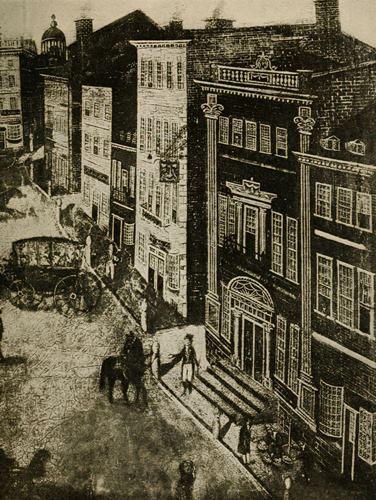
The Royal Exchange Tavern (white building at center) on State Street, where Hewes taught cane fencing three days per week
In a 1799 advertisement Hewes further stated that with his “system of defence…a person attacked can defend himself against the Small Sword, Broad Sword, Sabre, Gun and Bayonet, cane or small Stick of Wood.” Later notices by Hewes added the “spaderoon,” “Claymoor,” and “rapier,” to the list of weapons taught, and the “boarding pike” to the list of weapons which the cane was capable of defending against. Hewes further explained:
“According to the present appearance of things, and as Effeminacy forms no part of the American Character—Mr. HEWES has Reason to Expect a full Employ—even Invalids had better Learn to wield the Sabre, than swing the Dumbells—for health, Rosey health is in Exercise found.”
In 1798, Hewes also offered to teach “the true Highland stile, as taught by the late famous Donald McAlpin.” An avid collector of fencing treatises (his bookshelf contained Angelo’s, among others), Hewes later claimed to have united the “French, Scotch, and Austrian Methods into one System.” Regarding the specific use of the cane, which he typically referred to as “Cane Fighting, or the Art of Personal Defence,” Hewes stated:
“Some private gentlemen content themselves with carrying a large knotted cane—cost perhaps five dollars. All that may be very fashionable and very well; but a little attention and practice with Master HEWES, at the head play and knock-down lessons, would make that cane look more graceful, and feel more agreeable in the hand than before…Other private gentleman will not carry a cane, or any other weapon of defence—but depend upon their own good behaviour and civil deportment for protection; which is really a good sentiment, and will almost always answer the purpose: But there are times when all that goodness will not protect them against the attacks of a ruffian, but be rather an incentive… therefore the art of defence is necessary.” (Columbian Centinel, Oct 27, 1802)
Hewes would go on to republish a number of books on fencing and military tactics, including the 1796 saber treatise, Rules and Regulations for the Sword Exercise of the Cavalry by Major-General John Gaspard Le Marchant, which, according to the title page, Hewes had “revised and corrected.” Later in the century, Hewes’s edition did not escape the notice of fencing scholar Egerton Castle, who included it in the bibliography of his landmark Schools and Masters of Fence, from the Middle Ages to the Eighteenth Century.
Given that Hewes frequently relates his method of cane defense to fencing with the broadsword and saber in his numerous advertisements, it is worth taking a brief look at the Rules and Regulations. The text describes six cuts, eight guards, “the modes of parrying,” and defense against cavalry, bayonet, as well as “the defence of one man against two.” It notes that all cuts are to be made from the wrist, “without giving action to the elbow,” and exhorts practitioners
“not to hold their swords too tight; but to allow the hilt to play in the hand, by the second, third, and fourth fingers being distended or contracted, as may be necessary to accord with the motion of the blade; taking care invariably to hold the gripe firm with the fore-finger and thumb.”
Hewes felt strongly enough about his edition to send a copy to President Thomas Jefferson, to whom he urged its adoption in the American military, complaining that “our Cavalry are truely Millitary Monsters haveing no Sistem of Exercise.”
Hewes continued to teach cane defense, as well as fencing “in all its various branches,” for several decades in the Boston area, posting his last known advertisement in 1826. One of his last notices contains an eloquent passage on self-defense training, interspersed with Hewes’s characteristic humor:
To cure the body the mind must be pleased by the exercise—for instance, learning the art of defence…has restored many young gentlemen in this city to health and strength. The mind being pleased with the theory, the body naturally gains strength with the practice, and when masters of the art, they may defend themselves scientifically, save their limbs and perhaps their lives by their skill. But some will say that in a government like ours, the law is our protection—in carrying a civil deportment and gentleman-like appearance we are safe enough; a great mistake in both arguments. In the first place, the law cannot protect you at the moment of attack, is expensive and troublesome, and you cannot expect to have a constable always at your heels, padding after you, like Corporal Trim after Uncle Toby. In the next place, your mild and genteel appearance, does not but invite the attack of the foot pad or ruffian; they mark you as their prey, as the hawk does the dove…therefore the art of defence is necessary, and if you come and learn, it will answer two good purposes, viz: it will cure you of bodily weakness and me–of the Mal de Pouch, if you pay me for it, as Lope Toco says to Roque. Please apply to ROBERT HEWES, Corner of Essex street, where he practices the art of Bone Setting—or at his Fencing Room, Boylston Market, where he teaches the art of Bone Breaking—genteely.
Hewes’s many business ventures seem to have paid off, for in later years he was regarded in Boston as a “gentleman of leisure,” living in a “large house, with a spacious court, and magnificent shade trees” on the corner of Essex and Washington streets. He also became known as something of an eccentric, and was often seen in his dressing-gown “playing with the peacocks and paroquets in his yard.” It was related that in 1826, he told his housekeeper, Sally, “I am 75 years old today, and I can handle a broad sword better than any young man in Boston.” Hewes passed away in 1830, and is buried next to an unmarked stone in Boston Common.
THE NINETEENTH CENTURY
The nineteenth century saw an explosion in the number of cane fencing instructors in the United States. That the walking-cane was employed in earnest in street encounters can be verified by a number of news reports, of which the following is only one example:
“Baltimore, Feb. 2. An attack was made upon a gentleman last evening about nine o’clock in High, near Stiles street, no doubt with the view of obtaining plunder—the gentlemen received a severe blow over his right eye, but being somewhat on the lookout, made a good defence with his cane—the ruffian then attacked him with large stones, but was compelled to retreat into an alley between Albermarls and President streets and thus effected his escape.” (New York Evening Post, 1830)
In the years following the appearance of Robert Hewes, a number of other instructors in “cane defence” and “cane fighting” publicly offered their services. Seven of these individuals appear to trace their fencing lineage to a single source: the Military School of Colonel Irénée Amelot De la Croix.
COLONEL DE LA CROIX
De La Croix was a former nobleman of Flemish, French, and German ancestry, a member of the ancien régime, and a decorated military veteran. His voluminous 1814 biography describes many of his incredible feats and adventures, noting that in the course of his career, the Colonel had impressively “been fourteen times wounded severely…and has been in fifty-six regular battles, besides near fifteen hundred affairs of out-posts and skirmishes.” (Baron de Vanden Boègard, Portrait of Colonel I.A. de la Croix, Baltimore: Printed by Bell & Cook, 1814). De La Croix arrived in the United States in 1806, where he “married an American lady” and opened a military school in Boston, “where he taught many.” Later De La Croix moved his school to Newburyport, then to Portsmouth, New Hampshire, and from thence to New York City and Baltimore. In New York alone he had “thirty scholars.” During his time in America, he authored several treatises on the art of warfare, and corresponded with Presidents Thomas Jefferson and James Madison.
At least seven of the Colonel’s former students, or students’ students—including Michel (later William) Tromelle, Jean B. Girard, Phillip Haussy, Mr. Nichols, Peter Trinque, Thomas Ryan, and George Gray—would go on to teach “cane fighting,” sometimes referred to as “Norman cudgelling,” the “Norman mode of defence,” or, as Nichols stated simply, “a powerful defence with the cane” (curiously, Trinque and Haussy would at one point describe it as, “the mode of using the single Stick, as practiced by the Romans”). An advertisement by Tromelle, published in Boston in 1810, described De La Croix’s system, and its benefits, as follows:
“The great advantages attendant upon this mode of defence, and the benefits arising from these lessons, where persons are exposed to the insults of disorderly and unprincipled men, as well as an attack by a desperate villain, must be a sufficient argument to attract the attention of most men. It is a fact generally credited by gentlemen who have a knowledge of this defence with a cane, that a person is capable of conquering an attack of six men (with the same weapons), if they should not have a knowledge of this play. And to substantiate this fact, we have been very credibly informed that a gentleman who was taught the Norman mode of Defence, in Boston, has obtained a considerable sum of money by overpowering and driving three as hardy and courageous men as could be obtained to combat against him. We further have the pleasure of asserting that gentlemen who have become acquainted with the Stick Fighting feel more than amply rewarded for all their time and money spent in learning.”(Columbian Centinel, Oct. 6, 1810)
As De Le Croix’s students refer to his method as “Norman,” it may be that it was an early form of, or precursor to, French La Canne. However, as the specific techniques of formal systems of La Canne were not documented until the early 1840s, it is difficult to say how much De La Croix’s method may have resembled mid-nineteenth century French systems. As noted previously, cane fencing had certainly existed in France long before this time, where it took on different forms. According to his biography, De La Croix had studied at the military schools at Chalons, Metz, and Brienne, and served in the French Marines—a fact which may give insight to future researchers.
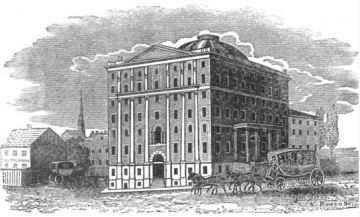
The Exchange Coffee House in Boston, where De La Croix’s students Tromelle and Girard publicly demonstrated cane self-defense
Whatever the case, students of De La Croix’s cane method nearly always stressed its efficacy in combating large numbers of simultaneous attackers. Jean B. Girard, one of De La Croix’s first assistant-instructors, explained,
Mr. Girard will…teach Cudgelling, in the Normand manner, not yet known in this country. If the American gentlemen were acquainted with the utility of this manly exercise, how easily it is obtained, he feels sensible that he would meet with great encouragement; as he has no doubt, that he can enable a pupil, in three months, to make an effectual defence against six assailants. (Boston Commercial Gazette, Nov. 16, 1809)
In 1812, in Baltimore, at a demonstration of “stick exercise or cane fighting” given by “Tromelle & Co.,” it was stated that
“A proficient in the stick exercises, may defend himself with safety, from the attack of four with broadswords at the same time.”
And in 1813, a former Baltimore student of De La Croix, George Gray, gave demonstrations in pugilism, fencing, and the “Norman cane,” and the next year, opened a fencing school in Lancaster, Pennsylvania, of which he noted,
“A proficient in the Norman cane exercise will defend himself against the attack of six men at the same time with the same weapons.”
As late as 1824, Gray’s former colleague, Thomas Ryan, was teaching “Boxiana” and “the use of the cane” at his own School of Arms in Baltimore.
In 1818, after parting ways with fellow instructors Jean Girard and Peter Trinque, the aforementioned William Tromelle took to the Boston press to announce his “co-partnership” with a new fencing master—Antonio Cannata of Italy. Together, Tromelle and Cannata would teach defense with the “stick,” as well as “fencing, in all its various parts” for the next year at No. 3 Cornhill Square. Of especial note is an advertisement published jointly by the two on April 21, 1818, in the Boston Daily Advertiser (see below). This notice contains a crude illustration, similar to those found in other American fencing advertisements of the period, except for one important difference: whereas others depict fencers engaging, or lunging, with clearly hilted foils or smallswords, the one published by Tromelle and Cannata shows two fencers facing each other out of lunge distance, with hiltless weapons—possibly sticks or canes. As this same advertisement listed the “Broad Sword,” “Small Sword,” “Cut and Thrust,” and “Stick” as weapons taught, this was certainly one of the possibilities.
Although, given the crudeness of the illustration, it is difficult to say with certainty, this advertisement may possibly represent not only De La Croix’s method of “Norman cane,” but the earliest visual depiction of cane fencing technique published in America.
Roughly one year later, in the spring of 1819, Cannata parted ways with Tromelle (possibly due to the ill-health of the latter, who would pass away in 1822), and announced the “re-opening” of his own solo school. An advertisement for Cannata at this time shows a different image, of fencers lunging and parrying with hilted swords.
OTHER FRENCH INSTRUCTORS
Another French instructor that appeared in America about this time—though not connected to De La Croix—was G. M. Coulon, who, in 1826, “lately arrived in [New York] city from England.” In 1827, Coulon announced the following in the Evening Post:
“The manly foils and broadsword taught upon the most approved method by Mr. C. every Tuesday, Thursday, and Saturday…Self defence with a stick, against any ruffianly attack, taught in six lessons.”
Unfortunately Coulon’s school was not to last, as he unexpectedly passed away in November of the same year.
The years between 1837 and 1840 saw a number of additonal French fencing masters advertising the “use of the Cane and Stick.” The first was François George Baugé, of New York City and Charleston, and who produced at least two subsequent cane fencing instructors, Charton and Chabriel, all originally “of the Royal Academy of Paris.” Although Baugé published a series of illustrations on the art of fencing, these did not, unfortunately, include the cane. Other French instructors of “cane defence” during this same period was H. Hautonville, who appeared in Charleston in 1840, and E. Raux, who ran an “Academy of Arms” in Richmond, Virginia, in 1849 . These individuals all neglected to describe their methods of cane defense, and may very well have been teaching French La Canne, the technique of which would begin to be documented in France during the 1840s.
Approximately two decades later, in 1865, a Captain Arthur De Pelgrom, a Belgian who had evidently instructed soldiers in the Union Army, also offered practical self-defense in the use of the walking stick:
At the same period, a few instructors hailing from other nations appeared, who deserve mention.
SIGNOR MANFREDI
Another colorful character worthy of mention, and who hailed from Italy, is “Signior Manfredi,” described as an “Artist of Agility,” and “astonishing man who has lately arrived in this country from Saddlers Wells,” who performed feats of strength and balance, as well as demonstrations of cane defense.
Manfredi, who claimed to have previously exhibited in London, Saint Petersburg, and Constantinople, gave demonstrations in the American cities of Portsmouth, Albany, New York City, Philadelphia, Baltimore, Norfolk, and Charleston from the years 1803 thru 1808. As Manfredi’s events were billed as a “Grand Display of Entertainment,” and also included “tumblings,” “feats of strength,” “tricks,” balancing acts, feats on horseback, and other acrobatics, it is unclear whether Manfredi’s stick demonstrations were actual exhibitions of self-defense techniques, or were merely staged entertainments. Whatever the case, audiences were impressed:
Signor MANFREDI has indeed already performed feats calculated both to “surprise and astonish.” The manner in which he went through his exhibitions on Monday evening was in the highest degree satisfactory to the audience, who testified their opinions by repeated and long-continued shouts of applause. He is so evidently a master of his business, and with such entire ease and dexterity does he requit himself, that the spectator may view his feats without having his sensations of pleasurable emotion disturbed by apprehensions for his safety.
Curiously, in one Maryland advertisement, Manfredi’s stick is described as “Dutch” rather than Italian. Most of Manfredi’s notices mention the use of the stick against multiple opponents—a feature which echoes the advertisements of De La Croix’s many students.
CAPTAIN RYLISKI
Captain Alexander Ryliski of Poland was another obscure figure, who taught cane defense in New Haven, Connecticut, at No. 31 Barney Hall on Chapel Street. Lest anyone doubt his experience, Ryliski noted in his advertisements:
“As a guaranty that Mr. Ryliski understands perfectly the above arts, he would only remark that for fifteen years he has served as an officer in the Polish army.” January 7, 1839, New Haven Daily Herald
Interstingly, Ryliski noted that he kept two separate schools—one a designated “Fencing School,” in which he taught the foil, broadsword, and bayonet, and the other “a School for exercise with the cane, for self defense against many.”
MAJOR R. I. DUNN
“Against Swords, Dirks, or Bowie Knives”
A particularly notable cane instructor of the same period was Major R. I. Dunn, “Professor and Teacher of Military Science,” a former citizen of Ireland who would become a noted American military officer. Although Dunn had begun teaching fencing in America in 1812, it was not until the 1840s that his military academies in New Orleans, Virginia, Massachusetts, and Kentucky became well-known. In an advertisement for his New Orleans academy, Dunn claimed that his “art of Personal Defence,” or method of fencing
“is a combination of the broad sword, small sword, single-stick or quarterstaff, with the manner of disarming an antagonist…and renders [the practitioner] fully capable of attacking and defending himself against sword (broad or small), bayonet, dirk, or stick, and when even only armed with a walking stick.”
An 1847 advertisement for Dunn’s school in Frankfort, Kentucky, appropriately added the “Bowie knife”—a popular local sidearm—to the list:
The particular mention of the cane used to defend against a Bowie knife is an unusual one, prompting one to wonder if such encounters in earnest ever actually occurred. The answer is yes. According to the Baltimore Sun of August 14, 1856, when one Edward Morton ambushed a Mr. Ben Debar in the streets of St. Louis,
As Debar passed [Morton] jumped out at him and endeavoured to stab him with a Bowie knife; DeBar’s alertness and skill at fencing saved his life. He knocked off the blow with his cane, and then grappled Morton until a policeman came.
It appears that Major Dunn himself had experience using the cane to defend himself in serious combative encounters. In what can only be described as a highly unusual occurrence, the Major is reported as having engaged in a pre-arranged combat with canes and pistols, fought in earnest. According to the May 24, 1844 issue of the Richmond Whig:
A rencontre took place at the Prentiss House, between Major Dunn, well known in this City as a teacher of the art of boxing, fencing, cudgel playing, &c. and Major Anderson Miller with Canes. Dunn it seems wielded his stick “most scientifically.” The parties afterwards met and fired at each other with pistols, but without effect.
In 1841, Dunn published his Condensed Military Pocket Manual. This book contains a chapter on the “Infantry Sword, or Cut and Thrust,” on which Dunn largely based his method of cane defense—with the important modification of eliminating all thrusts while using the cane. Dunn mentions that the infantry sword is lighter than that used by the cavalry, and thus, “much more agility is necessary.” He includes six cuts and a number of “guards,” including “the position of St. George.” Dunn instructs his readers as follows:
The position of the [fencers] will be fronting each other, and placed about four full paces apart, the right foot will be advanced about half a pace, the point of the toe, sword-arm, and right side only, presented to each other, the left hand on the hip, arm a-kimbo, swords crossing each other, in a diagonal position, taking care to keep the sword-hand on the right eye as much as possible, which is the general guard; the cuts will be made with a stiff arm, using the wrist instead of the elbow… When the opponent is a strong and vigorous man, and assaults with rapidity, act on the defensive, retreating a little if too hard pressed; but on discovering that he begins to slacken or get fatigued, then will be the proper time to become the assailant with advantage.
The book contains a small passage on the specific application of these techniques to the cane, which notes an interesting method used to protect one’s hand and fingers:
“In the exercise and use of the cane…the same rules will be adopted as in the cut and thrust sword, with the exception of giving point, which will be unnecessary. It will be advisable (if there should be time) to wrap the hand embracing the cane in a pocket handkerchief, which will guard the knuckles and secure the cane at the same time; the handkerchief must not be tight, as it would confine the cane too much, but crossed lightly from right to left, over the hand.”
COLONEL THOMAS H. MONSTERY
“Almost anything can be made into a weapon if properly used…”
Colonel Thomas Hoyer Monstery was one of the most celebrated American fencing masters of his time, and the first to write extensively about the use of the cane as a method of self-defense. When it came to combat, Monstery had an impressive resume. He had fought under twelve flags in numerous wars and revolutions, had survived participation in more than fifty duels with the sword, knife, and pistol, and had twenty-two scars on his body to prove it. In 1878, Monstery expounded upon his method of cane defense in a series of articles published in the New York press, following his chapters on boxing, grappling, and kicking. More specifically, Monstery treats of a hickory walking-stick, which he describes as “the proper companion of every gentleman”—good against knives, sword-canes, and even guns:
“Boxing will get a gentleman out of a great many scrapes into which he may fall, but in some parts of the Union he will come across men who habitually carry knives or pistols and in such a case a stout walking-stick, if he knows how to use it, may save his own life, and—what I consider more important—prevent the necessity of his taking the life of another. It may seem strange to some that I, who have passed my time in the profession of arms, and have lived so much in Spanish-America, where the use of weapons is universal and duels of everyday occurrence, should have a horror of taking life; and yet I can honestly say that I have always avoided it, except where there was an absolute certainty that the question lay between my own life and that of another who sought to kill me…Many are the pistols and knives that I have struck from the hands of men by a smart blow on the wrist with a cane, and many are the murderous brawls I have prevented in this way. As a queller of disturbances, I know of nothing better than a hickory or ash stick.” (Chapter 12)
To prove the cane’s efficacy as a personal sidearm, Monstery includes a thrilling anecdote regarding an incident when he was attacked by three knife-wielding members of the Spanish secret service, who were intent on assassinating him. Using only his hickory cane, Monstery was able to successfully defend himself, until his attackers eventually fled into the night.
Monstery describes his cane system as being based on the same fencing principles as the saber or broadsword, but with some important modifications to account for the lack of a guard to protect the hand. The parts of the body that he targets are also different than those targeted with the sword, due to the concussive (rather than cutting) nature of the cane. Monstery also notes:
“The hook is an important part of the cane. It doubles its usefulness, serves as a handle to rest on when it is used as a staff, prevents its slipping out of the hand when it is used as a weapon, and serves as a sling when you do not wish to handle the cane. With a hook to his cane, no man need ever abandon it, for he can always hang it over his left arm when not in use, so as to be ready to catch it instantly with the right.” (Chapter 12)
Monstery also eschews the use of single-handed thrusts, which, he states, are “easily parried,” expose the fencer, and can only hurt or disable an opponent in two spots. Although Monstery notes that the case is different with two-handed thrusts, he reserves these techniques for his subsequent chapters on the use of the quarterstaff.
Throughout his life in America, in addition to his New York City academy, Monstery also ran schools in Baltimore, Oakland, San Francisco, and, in his final years, Chicago.
JUSTIN BONNAFOUS (1898)
In 1898, an article on cane self-defense was published by Justin Bonnafous, the American-born son of a French maitre d’armes of the same name. The elder Bonnafous had been a well-known “sword master” at the United States Naval Academy at Annapolis, Maryland. In 1883, Bonnafous Jr. succeeded his father as instructor at the Fencing and Sparring Club of Philadelphia, where he would continue to teach for several decades. In 1898, after having traveled to and returned from Paris, where he had studied fencing, Bonnafous authored a short treatise on self-defense with the cane. It was published in Volume 31 of Outing magazine, and accompanied by nine photographs. Bonnafous’s method shows the influence of French la canne, and includes techniques to defend against knife-wielding thugs as well as multiple attackers, and utilizes both single and double-handed grips. Following is one of several techniques described by Bonnafous:
“If an assailant comes at you armed with a knife or razor, cut for the arm, and, on his dropping it, proceed with treatment as before (see Figures 5 and 9). The thrust for the eye is sometimes used, but should only be resorted to as an extreme measure, for it might prove fatal.”
Bonnafous directs the reader to use a cane “of thoroughly seasoned, straight grained hickory, tapered like a billiard cue, about one and a half inches at the butt, down to three-fourths of an inch at the point. The butt should be surmounted by a knob of silver or other heavy metal, and the point protected by a heavy ferrule.” Unlike Monstery, Bonnafous cautions against using a cane with a hook, for, he warns, “it is apt to become entangled in the clothing at the critical moment, and in such melees every second counts.”
Bonnafous’s article, as far as we currently, know, is the last to treat of cane defense during the nineteenth century.
THE TWENTIETH CENTURY
LOUIS TRONCHET
“The complete defense that lies in a cane…”
Louis Tronchet, a French maitre d’armes, arrived in the United States in 1887, and by April of 1888, had moved from New York to San Francisco, where he began giving fencing lessons at the distinguished Olympic Club, which had been co-founded by Monstery. Tronchet was an exponent of the French school of classical fencing, and had graduated from the military academy of Joinville-le-Pont at the head of his graduating class numbering six hundred. According to his colleague (and occasional rival) Henri Ansot, Tronchet dismissed “wild fencing” in favor of “the more classic style of fencing,” which soon “took the supremacy, under his correct and graceful style of tuition.” This style had evidently served Tronchet well, for in 1887 he defeated the noted New York fencing master Regis Senac in a prominent contest at Cosmopolitan Hall, while adhering throughout to a “faultlessly classical position.”
Tronchet was also a known expert at French savate, and offered instruction in cane self-defense for use in the street. In 1903, after teaching, contesting, and demonstrating fencing in the United States for more than fifteen years, Tronchet published several techniques of cane self-defense in the pages of the San Francisco Call, showing how to ward off several types of armed attack by a “footpad or ruffian.”
“It has remained for Professor Tronchet, instructor of fencing at the Olympic Club, to teach the complete defense that lies in a cane.”
The article, however, does not cover such a complete defense, but, rather, “illustrates a few of the simpler movements and foils which with little practice can be made use of to the advantage of Mr. Footpad by any man of average strength and adroitness.”
The article thus shows a handful of cane defense techniques, utilizing both single and double handed grips, and mostly executed versus a masked attacker armed with a pistol. Tronchet instructs the person accosted to put his hands in the air in a gesture of surrender, but all the while still holding the cane—assuming a position of readiness designed to give the illusion of submission. He proceeds to describe various ways to attack the shins, wrist, and head. For instance, Tronchet instructs,
The simple blow on the wrist is as effective as any blow can be. A right swing of the body and a quick, strong blow across the wrist with the cane causes the footpad’s hand to instantly relinquish the weapon and leaves an opening for an attack with the advantage in favor of the peaceful homegoing citizen. However, he is not quite ready for the homegoing yet. He prefers to see his footpad eating humble pie first.
After advocating several such defenses, including the use of a head butt, throws, and chokes, the article notes that
Professor Tronchet has many more swings and thrusts and tilts of the simple walking cane wherewith to bring the footpad to confusion, but the more difficult ones would require much practice and a close perusal of the rules set down in some pamphlet on fencing…as steady nerve, a cool head, and a quick action are the three requisites–given the walking cane and the ability to use it properly.
The article thus concludes,
Should the cane become a popular weapon of defense against footpads, and according to Professor Tronchet, there is no reason why it should not, it will be necessary for the footpad who wishes to be successful in his chosen profession to take the art of fencing. Otherwise he will find it pleasanter to earn his own living than to depend upon others to earn it for him.
BARTITSU (1903)
“When a man is called on to face a ruffian, he needs no better weapon than a hickory walking stick…”
Bartitsu was an English hybrid martial art developed by Edward William Barton-Wright, and which was practiced in Great Britain between the years 1898 and 1902. Although relatively short-lived, the techniques of Bartitsu were documented extensively in various journals and magazines, which saw widespread distribution. Although much of Bartitsu’s unarmed techniques (particularly grappling) were borrowed from Japanese martial arts, its method of cane self-defense was largely influenced by a style of la canne developed by the Swiss maitre d’armes Pierre Vigny.
Although, as far as we know, Bartitsu was never practiced in America (prior to a late twentieth century revival), its techniques did see publication in America, and are worthy of mention. On August 30, 1903, a lengthy illustrated article appeared in the New York Tribune, under the following heading:
“SCHOOLS WHERE MEN ARE TAUGHT HOW TO DEFEND THEMSELVES AGAINST THE ATTACKS OF STREET ROWDIES”
The piece was accompanied by seven illustrations, excerpted from The Illustrated Sporting and Dramatic News, a British journal. The text of the Tribune article, however, is original, and offers a fascinating glimpse into how New Yorkers viewed the criminal threat at the turn of the century, as well as emphasizing the importance of learning self defense with a cane:
When a man is called on to face a ruffian, he needs no better weapon than a hickory walking stick. A revolver is likely to harm him more than to help. As soon as a man reaches for his weapon, his adversary has the right to shoot, and the accomplished criminal is almost sure to have his weapon ready first. The stick is the better weapon, because it is quicker. It is in one’s hand already. It is always “loaded”…Should a New-Yorker combine both the tactics of the London stick man and the United States naval wrestler, it is safe to say that the police of this city would have far fewer holdups and burglaries to record than at the present time.
The article also offers an interesting look at the perceived fighting styles of various local “thugs” of Anglo-Saxon, Spanish, Italian, and German origin, and offers advice for defending oneself against assaults with the fist, foot, stick, knife, and gun.
MARQUIS OF QUEENSBERRY (1911)
“One advantage of the cane as a weapon is the facility with which a blow may be delivered…In fact, a blow may be delivered with a cane perhaps almost quicker than with the fist. For this reason such a blow is hard to dodge.”
In 1911, another instructional article on self-defense with the cane appeared in the pages of the Chicago Tribune. The author, writing under the name of “The Marquis of Queensberry,” was none other than Lord Percy Sholto Douglas (1868-1920), 10th Marquess of Queensberry, and the second son of John Sholto Douglas, the Scottish nobleman best known for lending his name and patronage to the “Marquess of Queensberry Rules” that formed the basis of modern boxing.
Most of Douglas’s previous columns pertained to boxing and jiu-jitsu; he did, however, include one on self-defense with the cane, and another on the use of the umbrella or parasol (intended for women), both of which were accompanied by a number of photographs, some of which included Douglas himself, and drawings. Like the methods of Hewes and Monstery, as well as the cane techniques set down by fellow Briton R. G. Allanson-Winn, 5th Baron of Headley, Douglas grounded his cane defense firmly on the fencing techniques normally applied to the broadsword and saber.
Douglas’s articles are highly interesting, and probably most useful in their simplicity. They are intended for a general audience, as well as for fencers looking to apply their preexisting knowledge of the sword to common household articles such as the cane and umbrella. From a pedagogical standpoint, Douglas’s series is perhaps also notable for its inclusion of footwork diagrams in its section on the umbrella.
ANDREW CHASE CUNNINGHAM (1858-1917)
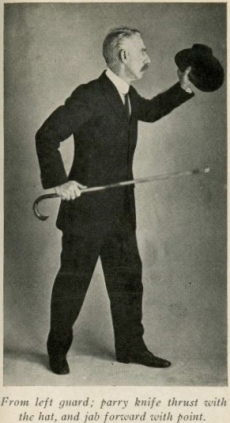 In 1912, another treatise on cane self-defense appeared, published in the form of a short pamphlet by Andrew Chase Cunningham of the United States Navy. Much has already been written about this text, which is also widely available. Suffice it to say that Cunningham was president of the Washington D.C. Fencing Organization, and the author of a fencing text, Sabre and Bayonet (1906). According to this article by Maxime Chouinard, Cunningham had been a student of the elder instructor Antoine J. Corbesier, who had served in the Belgian and French militaries before immigrating to America, where he became instructor at the U.S. Naval Academy in Annapolis, Maryland. According to Chouinard, Cunningham’s cane defense techniques bear some resemblances to Corbersier’s method of Belgian Canne Royale. Cunningham’s The Cane as a Weapon contains eighteen pages of text, as well as twelve photographs.
In 1912, another treatise on cane self-defense appeared, published in the form of a short pamphlet by Andrew Chase Cunningham of the United States Navy. Much has already been written about this text, which is also widely available. Suffice it to say that Cunningham was president of the Washington D.C. Fencing Organization, and the author of a fencing text, Sabre and Bayonet (1906). According to this article by Maxime Chouinard, Cunningham had been a student of the elder instructor Antoine J. Corbesier, who had served in the Belgian and French militaries before immigrating to America, where he became instructor at the U.S. Naval Academy in Annapolis, Maryland. According to Chouinard, Cunningham’s cane defense techniques bear some resemblances to Corbersier’s method of Belgian Canne Royale. Cunningham’s The Cane as a Weapon contains eighteen pages of text, as well as twelve photographs.
DR. BENJAMIN FRANKLIN ROLLER (1915)
“Nothing justifies fighting at any time or place except defence.”
In 1915, bodybuilder and physical culturalist Dr. Benjamin Franklin Roller, M.D., published a series of articles on exercise, diet, healthy living, and self-defense in the New York press. Roller propounded a unique unarmed method of self-defense, which combined savate, boxing, Cornish wrestling, and American catch wrestling (this last being Roller’s specialty) for use against unarmed assailants, as well as those wielding a knife or gun.
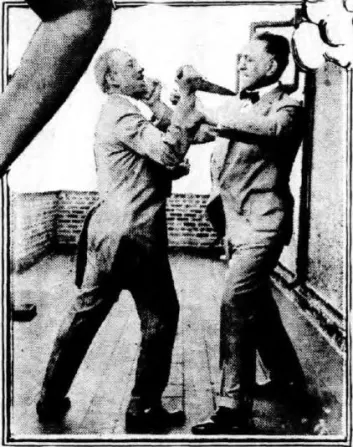
Roller’s unarmed defense against knife: “Parry the stabbing arm with the palm of the left hand. Step boldly inward, forward, and to the left. Spring from the right foot and throw the entire weight, of the body behind a right hand blow to the assailant’s chin.”
In addition, Roller describes what he considers to be the “Eight Essential Exercises,” which includes fencing:
Eight things should every boy be able to do (until he can do every one of them fairly well he is not a man complete)—to run, to jump, to ride, to shoot, to wrestle, to box, to swim and to fence. You don’t have to be an expert in all, or even in any one. These are the fundamental studies of self-defence, and the more you can learn about all of them the more you will increase in ability which some time you may badly need.
Regarding fencing in particular, Roller explains:
Fencing is one of the most beneficial of exercises, great fun and a very effective means of defence. Get the singlesticks, with mask and glove, at any sporting goods house, or you can practise the movement with any old stick. I never took a lesson in this work in my life, but I became so efficient in singlestick fencing that I defeated the best professional fencer on the Pacific coast and twice saved my life by knocking a gun or a knife out of an assailant’s hand by means of an ordinary cane.
The vast portion of Roller’s instructional material treats of his special hybrid method of unarmed self-defense. He does, however, describe and photograph one technique using a hooked cane:
Roller explains this technique as follows:
“Fig. 4.—-A fencing stroke in self defence. The author saved his life in Indiana once by this exact stroke, disarming the assailant and breaking his hand. Step backward and a little to the left. Execute a complete circle from below upward and to the left with the forearm and wrist. The movement is as quick as a flash and very powerful if executed chiefly with the wrist, the elbow being elevated slightly to make the blow more effective.”
GEORGE HEINTZ (1920)
“The cane is the most practical form of sword play for use in those tight places where men care nothing for rules…”
In 1920, another treatise was published containing self-defense techniques applied to the cane. The author was George Heintz, Junior, an instructor at the United States Naval Academy, who included his method in the Naval Academy’s Manual of Athletic Requirements. A number of sources indicate that Heintz had learned fencing from his father, George Heintz, Sr., a German immigrant who had also taught fencing at Annapolis, Maryland, and was well-known in German fencing circles and Turner societies. His son, George Heintz Jr., was a national saber champion in 1890, and was appointed Assistant Swordmaster at the Naval Academy in 1903, taking over as Head Swordmaster from his father in 1915.
In his text, Heintz, Jr., propounds a method that is heavily based on fencing theory, and which is executed “in the same manner as [the] Sword Exercise.” It utilizes a saber grip, moulinets, as well as double-handed parries and thrusts. He outlines his method as follows:
“Remarks. — The cane is the most practical form of sword play for use in those tight places where men care nothing for rules, but only want to make the most out of the weapon which the chance of the moment has put in their hands; should the weapon in hand be an umbrella, the most effective use of the same would be the thrusts with both hands. Bayonet tactics can also be used with the cane or umbrella, such as Long and Short Thrusts, combined with the use of the knee or foot.”
Following are a selection of plates from Heintz’s chapter on the use of the cane:
George Heintz Jr. continued to serve as “Swordmaster” and head instructor at the Naval Academy until 1932.
MARCEL CABIJOS (1893-1964)
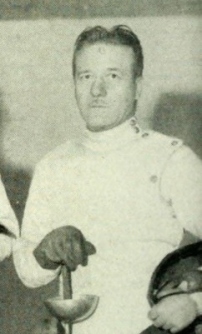 About this same period, another fencing master, of French origin, also began offering cane instruction in the northeastern United States.
About this same period, another fencing master, of French origin, also began offering cane instruction in the northeastern United States.
Born in France, in 1893, Marcel Cabijos served in the French Navy throughout World War I. He was a combat instructor and served in the Fusiliers Marins, a combat unit that was deployed to the land from ships. During his enlistment he founded a fencing society aboard his ship, and became the fencing champion of the French navy. After the war, he received his Maître d’Armes (master of arms) diploma and taught in the south of France for several years before emigrating to New York City in 1924. In addition to his rank as a fencing master, Cabijos was also an instructor in judo and savate. In 1926, Cabijos attained great renown by defeating the sabre and épée champion of the United States, Leo Nunes, with only a twelve-inch dagger against Nunes’s dueling sword.
In New York, Cabijos taught fencing at a large number of schools and institutions. Among these, Cabijos is recorded as having specifically taught cane self-defense at Vassar College, Lehigh University, the J. Sanford Saltus Club, and the Salle d’Armes Henry IV. The following article, culled from the archives of Lehigh University, and published in the magazine Brown and White, impresses upon the reader an idea of Cabijos’s prowess with the cane:
A number of accounts of Cabijos’s cane demonstrations appear in the Vassar Miscellaney, such as the following from February 2, 1929, which was held “before an enthusiastic gathering of about a hundred people”:
Again, in 1930, another account was published:
Unfortunately, as far as anyone knows, Cabijos never wrote any treatises or articles about his method of cane self defense. However, additional accounts of Cabijos and his fencing exhibitions can be accessed in the following collection on Pinterest.
FREDERICK ROHDES (1897-1984)
The history of cane self-defense in America would not be complete without mentioning Frederick Rohdes, a German fencing master who taught the art and science of fencing in New York City in the old tradition.
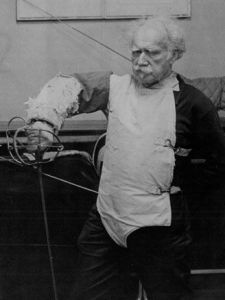
Maître d’Armes Frederick Rohdes, pictured with a schlaeger, one of the weapons taught at his academy, during the late 1970s.
Born in 1897 in Western Prussia, Rohdes taught fencing as an assistant instructor on the American west coast for some time during the 1920s before moving to New York City. He trained under several notable fencing masters, among them Maestri Luigi Barbasetti and Aurelio Greco eventually becoming Provost and Master under Marcel Cabijos (see above). Maître Rohdes opened his own fencing academy in 1948, which was located above the Loew’s Orpheum building on 169 East 86th Street in New York City.
Although he passed away in 1984, Rohdes’s fencing systems and techniques were passed down to his protégé Maestro Ramon Martinez, who continues to teach them today at the Martinez Academy of Arms in New York City. Among the many methods passed from Rohdes to Maestro Martinez include some techniques of cane self-defense. Maestro Martinez has since integrated these techniques into his own method of cane defense. For the purposes of this article, we asked Maestro Martinez to provide a description of his cane defense method. He responded,
“It is not a fencing system or a fighting system; it is a method of pure self-defense. However, it is informed by the knowledge of fencing that I have, as well as other personal martial experience. My objective is to keep it as simple as possible, so that it can be learned quickly. It is intended to be used against both armed and unarmed adversaries.”
POSTSCRIPT
In conclusion, it is important to note that the numerous fencing instructors and schools mentioned throughout this article do not, in all likelihood, represent a complete picture of what existed in America during the periods covered. It is highly probable that many instructors never advertised their services, and that there existed additional masters and instructors in America during these times who have escaped the eye of history altogether. It must be understood, therefore, that the corpus of surviving records represents a window through which one can glimpse only a part of the historical reality. It is to be hoped that, in the future, other researchers will uncover additional evidence of schools and masters of cane fencing in America.
Text of this article, except where quoted, © 2016 by Ben Miller.
“There is no doubt but that it was the finest match seen in America…”
During the late nineteenth century, Maitre d’Armes Regis Senac was one of America’s most widely-known fencing masters. A native of France, Senac had arrived in New York City in 1872, and had set up a fencing school on University Place in Manhattan’s Greenwich Village. The Frenchman had reportedly fought three actual duels in France and had emerged victorious from all.
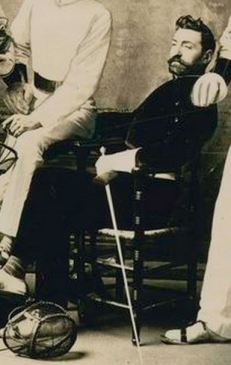
Regis Senac. Source: New York Public Library.
In New York City, Senac engaged in a number of high-profile, controversial fencing contests which were reported on by many major American newspapers. Although he had always emerged as the technical victor, many of these victories occurred by default when distinguished adversaries such as Colonel Thomas Monstery and Maestro Eugenio Pini stormed off the stage with disgust at Senac’s tactics and at the manner in which such contests were being scored. In 1884, during another contest between Senac and fencer Albert Vaughn, the latter walked off the stage after Senac disabled his sword arm with a vicious cut, with Vaughn alleging that Senac “was not disposed to act in a fair and gentlemanly manner.” Whatever criticism could be leveled at Senac, it is clear that within the context of a public fencing contest, he was a dangerous, or at least a puzzling, adversary.
Then, in 1887, Louis Tronchet arrived in New York City.
Tronchet was a formidable fencing master who had graduated from the famous French military academy of Joinville-le-Pont, at the head of his graduating class of six hundred. He was also a known expert at French savate, and offered instruction in cane self-defense for use in the street.
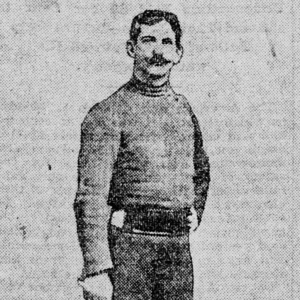
Louis Tronchet
Notably, Tronchet was also an exponent of the French school of classical fencing—a style which, according to a number of nineteenth century fencing texts, strongly adhered to the approach, principles, form, and refined technique embodied by earlier fencing masters such as La Boëssière, Jean Louis Michel, Gomard, Grisier, Cordelois, and others—and which stood in contrast to other fencing styles of the period, variously referred to as “romantic” and “irregular.” In 1892, a brief English language definition of the “classical fencer” was provided by Maître Louis Rondelle, who wrote in his book Foil and Sabre:
“The Classical Fencer. – A classical fencer is supposed to be one who observes a fine position, whose attacks are fully developed, whose hits are marvelously accurate, his parries firm and ripostes executed with precision. One must not forget that this regularity is not possible unless the adversary is a party to it. It is then a conventional bout, which consists of parries, attacks, and returns, all rhyming together.”
At least five separate period sources describe, or refer to, Tronchet’s fencing as being classical. This included Tronchet’s colleague (and occasional rival) Henri Ansot, who recounted that Tronchet dismissed “wild fencing” in favor of “the more classic style of fencing,” which soon “took the supremacy, under his correct and graceful style of tuition.” Another was Tronchet’s protege, Emilio Lastreto, who would later describe his master as a “classical swordsman.” A third source was the New York Times, which stated that “Tronchet’s style is classical,” and a fourth—which shall be reprinted below in full—is Outing’s account of Tronchet’s 1887 match with Senac, which describes Tronchet as adhering to a “faultlessly classical position” throughout. Likewise, the San Francisco Chronicle noted,
“Tronchet’s style is essentially ‘classic.’ By this is meant that he fences in strict accordance with known, fixed and positive rules. Many men have peculiar and individual styles, following no rules and going it haphazard as they think best, and while these happy-go-lucky fellows sometimes attain considerable proficiency, they never reach a high degree of skill.”
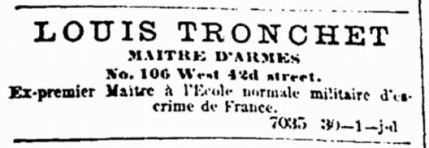
In March of 1887, Senac reportedly made the comment that the recently-arrived Tronchet “knew nothing about fencing.” Tronchet overheard, or got wind, of the comment, and promptly challenged Senac—who claimed the title of “Champion of the Two Americas”—to a public contest of arms. The stakes were set at $1,000 dollars and the championship title of America. Senac accepted, and the contest was arranged to be held in Cosmopolitan Hall on March 28th.

Cosmopolitan Hall, located on 41st Street and Broadway, hosted concerts, as well as a variety of events pertaining to subjects as diverse as flowers, ice skating, and horsemanship. A large building, it boasted a frontage of 90½ feet on Broadway, a depth of 157 feet on 41st street, and a backing of 100 feet on Seventh Avenue. In mid-1887, the theater’s interior would be reconstructed and the entire edifice renamed the Broadway Theatre, although the walls of the old building would remain the same.

Cosmopolitan Hall on 41st Street, in its later incarnation as the Broadway Theatre
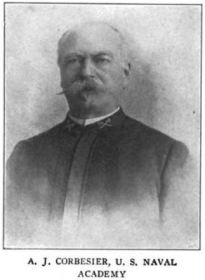 The night of the contest, both men dressed in “black velvet suits,” red belts, and white gauntlets. The conditions of the event were two fifteen minute assaults with foils, with a five minute intermission, to be followed by an assault with “triangular duelling swords”—that is, the épée de combat—after a ten minutes’ rest. During the assault with épées, the fencing became so fierce that at one point Senac broke off the end of his sword, and referee Antoine J. Corbesier (Sword-Master of the U.S. Naval Academy) received a cut across his hand that drew blood, prompting him to “use a sword to defend himself as he looked on.”
The night of the contest, both men dressed in “black velvet suits,” red belts, and white gauntlets. The conditions of the event were two fifteen minute assaults with foils, with a five minute intermission, to be followed by an assault with “triangular duelling swords”—that is, the épée de combat—after a ten minutes’ rest. During the assault with épées, the fencing became so fierce that at one point Senac broke off the end of his sword, and referee Antoine J. Corbesier (Sword-Master of the U.S. Naval Academy) received a cut across his hand that drew blood, prompting him to “use a sword to defend himself as he looked on.”

The most detailed account of the fencing contest between Tronchet and Senac, published in Outing Magazine, and reprinted below in full, sheds light on the different styles of fencing that existed in America during the late nineteenth century.
THE SENAC-TRONCHET FENCING MATCH FOR $1,000 AND THE CHAMPIONSHIP OF AMERICA.
Outing. May, 1887.
This match, which took place on March 28th, at the Cosmopolitan Hall, has been the talk of the town for a month. The daily papers were full of it and gave extended and picturesque descriptions of the contest. Unfortunately, these descriptions were written by reporters who, clever and imaginative though they be, know nothing about the art of fencing, and would be very much distressed were they to be asked the difference between a seconde and a quinte. They praised the gracefulness of one man and extolled the agility of the other; they proclaimed that the first was superior in forcing the combat, and stoutly maintained that the second was the better in rapidly retreating when danger was near. All these statements, hashed up with different sauces to suit the partisan tastes of the reporters, and served hot next morning, were gobbled up with satisfaction by an ignorant public, but proved very repugnant to connoisseurs.
And first, as to the men themselves. Senac is at least by four inches the taller, and was continually doing what is known among fencers as “tendre la perche;” in other words, not attempting to parry a thrust, but relying on the greater length of his arm, he endeavored to stop Tronchet before the latter’s sword could get to his body. This is poor fencing, though often successful. Tronchet, however, was not to be caught by such beginner’s tricks, and, by his superior agility, managed in every case but one to evade the threatening point. Besides, Senac is far more slender than Tronchet, thus affording less striking surface.
As to Senac’s much-vaunted gracefulness, it brings a smile of amusement to the lips of every friand de la lame. Why? Because in fencing, correctness of position is the first thing, gracefulness the second. If the position be both correct and graceful, then the highest art is reached. But for a position to be merely graceful is not enough. An Oscar Wilde position may be very graceful in a drawing-room, but it cannot be called so in fencing, because it is not a position sous les armes. Therefore, Senac’s position was not a graceful fencing position, because it was not a fencing position at all. He stood straight up instead of bending his knees and having his body rest well on his hips. He never used his left arm to balance himself when lunging, and therefore, being unable to retreat promptly after thrusting, was often hit by a clever ripost. He usually rested his left hand on his hips, as if he were practicing broadsword, and even went so far as to let it hang idly by his side. His chest, instead of being well expanded and held straight, was always bent forward; Tronchet, on the contrary, unaffected by the interests at stake, maintained, during the whole length of the assault, a faultlessly classical position. Against a man who had the tremendous advantage of size, he made a clever use of the only means of balancing such a glaring inequality, that of his wonderful agility. Senac’s fencing was wild and irregular; Tronchet’s was ever regulated by the most approved methods and governed by the best and most correct principles. Even when retreating he always presented the point of his foil to the breast or his adversary, menacing him constantly in his advance.
There is one thing we must say right here. We did not have really good fencing on either side; the interests at stake were too large to insure the calmness and equanimity which are absolutely necessary to first-rate fencing; the championship of America and the stake money of a thousand dollars depended on a few touches, and the two contestants were too excited to make use of all the means within their power. Were they to fence again, but in a salle d’armes, with nothing dependent on their skill but the honor of the victory, we would doubtless see marvelous work. Even as things turned out, there is no doubt but that it was the finest match seen in America, and, as The Times very correctly said, the first that was free of ante-contestive arrangements.
The one mistake of the assault was to permit disarmament to count as a touch. This is never allowed in France, and a man striking another in a duel, after having disarmed him, would be guilty of murder. As Senac thinks his disarmaments one of his best shots, he insisted upon counting it, and Tronchet, unwilling to retard the match in any way, consented, under protest. Now that Tronchet is champion, however, he will be able to impose his own conditions, and refuse to consent to such an antiquated absurdity.
To resume this criticism. Tronchet owes his victory to the correctness of his principles acquired in the best school in the world, that of Joinville-le-Pont, the Military Academy of France. In order to beat such a formidable adversary as Senac, he had to make use of rare skill and perfect method, and his victory is as much due to the simple and beautiful principles of the new school as to his own expertness and bravery. Senac, on the other hand, is personally an excellent fencer, his lunge is tremendous, his rapidity remarkable, his bottes are skillful, but his parries are weak, and his fencing belongs to the old school—it is wild, erratic, and without method—and to that he owes his defeat.
The referee, Prof. Courbisier, of Annapolis, was a good referee as far as perfect impartiality was concerned, but he made several mistakes, and they all happened to be in favor of Senac. The most palpable of these was at the end of the second bout with the foil, when he declared that Tronchet was disarmed before he had touched his opponent. As Senac had parried en quinte, and as Tronchet’s sword left a beautiful, white, round spot on Senac’s breast, this was a physical impossibility, and the audience hissed the referee. The seconds did their arduous duties well. Tronchet was represented by Mr. Eugene Van Schaick, the President of the Knickerbocker Fencing Club, and by Maurice Bernhardt [the son of actress Sarah Bernhardt], and Messrs. Ronald Thomas and William Lawson acted for Senac.
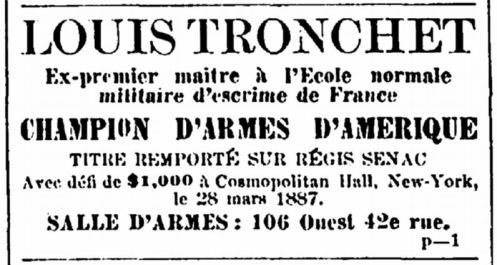
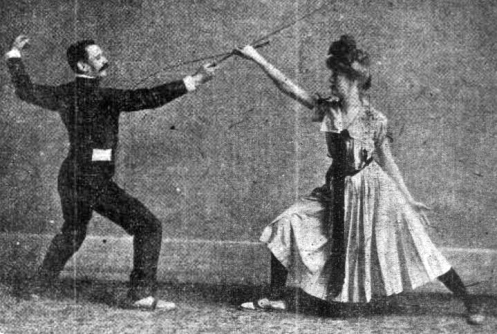
Tronchet demonstrates giving fencing lessons to Elizabeth Forbes in San Francisco, 1902. San Francisco Call.
Sources:
1. Ben Miller, The Monstery-Senac Fencing Contest of 1876. https://outofthiscentury.wordpress.com/2015/05/19/the-monstery-senac-fencing-contest-of-1876/
2. New York Clipper, April 12, 1884.
3. H. Ansot, “The Metamorphosis of Fencing” in Overland Monthly and Out West Magazine, Volume 24, Issue 144, December 1894; 566-575.
4. Emilio Lastreto, “Fencing,” in The Making of a Man (San Francisco: H.S. Crocker, 1915), 68.
5. Louis Rondelle, Foil and Sabre: A Grammar of Fencing (Boston: Estes and Lauriat, 1892), 189.
6. New York Herald, March 15, 1887.
7. Watertown Daily Times, April 9, 1887.
8. New York Herald, March 26, 1887.
9. New York Times, March 29, 1887.
10. New York Herald, March 29, 1887.
11. New York Sun, March 29, 1887.
12. San Francisco Bulletin, March 29, 1887.
13. Frank Leslie’s Illustrated Newspaper, April 9, 1887.
14. Outing, May 1887, Vol. X, No. 2.
15. Courrier des Etats-Unis, December 11, 1887.
16. San Francisco Chronicle, November 18, 1888.
17. San Francisco Call, July 6, 1902.
During the fall of 1911, the following series of articles on self-defense appeared in the pages of the Chicago Tribune. The author, writing under the name of “The Marquis of Queensberry,” was none other than Lord Percy Sholto Douglas (1868-1920), 10th Marquess of Queensberry, and the second son of John Sholto Douglas, the Scottish nobleman best known for lending his name and patronage to the “Marquess of Queensberry Rules” that formed the basis of modern boxing.
![]()
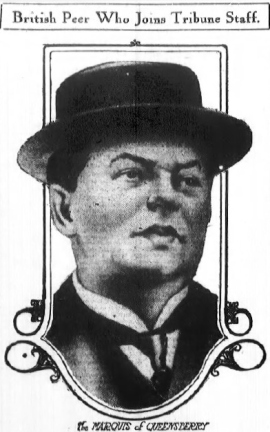
During his youth, Percy Douglas served as a midshipman in the Royal Navy, then in the British Army as a 2nd Lieutenant in the 3rd Militia Battalion of the King’s Own Scottish Borderers, from 1889 to 1891. After spending time in London, Australia, Canada, and Mauritania, Douglas traveled to America in August of 1911. That September, he began writing a series of sporting columns and instructional articles on self-defense for the Chicago Tribune. Most of Douglas’s columns pertained to boxing; he did, however, include two unique articles on self-defense with the cane (intended for men) and the umbrella or parasol (intended for women), both of which were accompanied by a number of photographs, some of which included Douglas himself, and drawings.
Notably, only ten years prior, Chicago had seen the passing of one of its most renowned martial residents, the duelist, swordsman, and fencing master Colonel Thomas Monstery, who had also written a treatise on self-defense with the cane. The collection of techniques presented in Douglas’s articles is not as sophisticated as Monstery’s system, however, his techniques do bear some resemblances (as well as some differences), and are founded upon similar principles. Like Monstery’s system, as well as the cane techniques set down by fellow Briton R. G. Allanson-Winn, 5th Baron of Headley, Douglas based his cane defense on fencing techniques normally applied to the broadsword and saber. Similarly, his umbrella technique is based on the “deadly…edgeless sword,” which Douglas erroneously terms the “rapier,” but is actually a reference to the dueling sword, or épée de combat.
Douglas’s articles are highly interesting, and probably most useful in their simplicity. They are intended for a general audience, as well as for fencers looking to apply their preexisting knowledge of the sword to common household articles such as the cane and umbrella. From a pedagogical standpoint, Douglas’s series is perhaps also notable for its inclusion of footwork diagrams in its section on the umbrella.
Following are Douglas’s two articles, presented together sequentially and in full, for the first time in more than one hundred years.
![]()
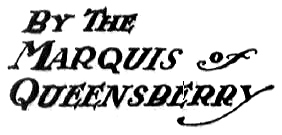
The Ordinary Walking Stick Can Be Used in Self Defense if Properly
Handled. Here Are some Methods of Using Your Cane if Attacked on Street.
The fist is the most natural human weapon and in competent hands, or rather, on competent hands, is a most deadly weapon. But competent hands are rare. Men in these days are too indolent and too secure, or fancy themselves so to be. They are not interested in boxing sufficiently to practice the art. Their attitude toward this sort of thing in general is that of the spectator. Being men of reasonable sobriety and temper, they do not look forward to physical encounters.
But in times of peace prepare for war. You never can be sure that some raw red ruffian is not going to mistake you for an intimate enemy and implant upon you a blow modeled upon the kick of a steam hammer. It is interesting to note that of a party of twenty-five clubmen assembled one evening recently, twenty-three had either been held up on the street or had suffered burglary at home. Of the twenty three only two had made any resistance.
For those men who are not exports with their fists the cane presents itself as a serviceable weapon of self defense. The walking stick is not as good as a sword or a club and its utility is limited, but it happens to be the only weapon a man ordinarily carries and so a consideration of its possibilities is worth while.
* *
Useful Cane Must Have Weight.
In the first place, remember there are canes and canes. A swagger stick would be of little use against an intoxicated human ox who wanted to remove 50 cents from your person by force. So also of the husky looking but brittle canes that are so deceptive. A cane to be useful in a row must have weight and elasticity. A walking stick of snakewood may be admirable. A mahogany stick or any of the strong, heavy woods will do, as will also some of those with steel backbones. There should be no fancy handle screwed or glued in place. The handle should be a continuation of the wood. It should also be a bent handle, so that in striking it cannot fly out of the grasp or be jerked from the hand by some one coming up from behind.
The cane, as has been said, has its limitations. The saber or the rapier can reach any part effectively, but the cane has neither edge nor point. It also lacks the concentrated weight of a club. The clothes protect against it and take something from the severity of the blow. At two points, and two only, can the cane be relied on for deadly work. These are the side of the head and the back of the hand. A quick, strong blow at either of these points is almost sure to disable an assailant.
* *
Blow on Top of Head Wasted.
Don’t waste your precious moment by hitting your assailant on top of the head. His hat will protect him there and, besides, his skull is too thick. The blow upon the hand, especially upon the back of it, will paralyse that member. If some rough comes at you with a knife in his hand, or a bludgeon, of even a revolver, you can disarm him. In the case of the revolver, of course, do not think he will not shoot. If you find yourself covered it is too late to act unless you are willing to take a chance. But there is sometimes an instant after the thug springs upon you before he really has you covered. If you are sure of yourself and quick enough you may be able to disarm him. It is almost impossible for any man who has received such a blow across the back of the hand to retain his hold. There is a small chance that he could pull the trigger—unless, and don’t overlook this possibility—he pulls it an instant before the blow lands.
There are several other vulnerable spots. A blow across the forearm, on the thumb aide, may disable if it is heavy enough. There is also the point on the upper arm where the muscles leave the bone unprotected; this is favorite clubbing spot for the policeman. You could jab a man in the stomach but the effect is not likely to be great, especially as the thug more often than not operates on an empty stomach. A jab in the face likewise might help: You can’t hurt his legs because, for one thing, you can’t get at them. The crazy bone is also out of your reach. The back of the neck is likely to be protected by the coat collar.
* *
Cane for Quick Work.
One advantage of the cane as a weapon is the facility with which a blow may be delivered. It is not necessary to chop wood with it. A short blow is necessary for quick work, and nothing but quick work is of avail. A short swing of the arm with plenty of wrist play is what is wanted. It is the wrist that brings the blow home. In fact, a blow may be delivered with a cane perhaps almost quicker than with the fist. For this reason such a blow is hard to dodge.
An active man with a good cane need not fear an assailant with an ax or a spade. The ax is unwieldy and its reach is not great, The spade is probably the more dangerous. You could not parry a blow from either with a cane, but you could §get in a whack across the temporal bone or the back of the hand before your rampant assailant could swing his implement.
The cane is at a disadvantage against a club or a piece of lead pipe These have the advantages of concentrated weight, heft in a lump, whereas the weight of the cane is too generally distributed. A man trained in the use of a stick should be able to give a good account of himself against a ruffian with a knife. But in all these cases it is necessary to strike first, if you are knocked down don’t try to use your cane afterwards. Unless you are on your feet you can do nothing with it.
Above all things don’t let the other fellow get hold of your stick. You may not be able to recover it and he may jerk you into reach of his corrugated knuckles before you know what has happened. If you strike quick and hard it will be difficult for any man to grab your cane. After your blow has landed remove the stick out of his reach instantly. The cane can also be used to a certain extant to ward off blows. Of course this cannot be done against a weapon of weight, but against another cane it may be used almost as a sword would be in fencing.
It may be remarked by some people that the average man doesn’t carry a cane, but to this I would reply that in any big city it does not pay to go out at night without a stick of some kind. This, however, would doubtless be hard to impress upon the mind of most men because of the general belief that only the dandy carries a walking stick.
* *
1. If a ruffian grabs you by the wrist bring your cane down across the back of his hand, put a lot of wrist motion into the blow. It will paralyze his hand for the moment and he cannot hold you.
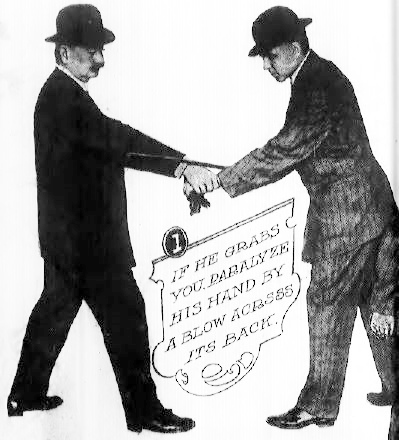
2. If he strikes straight down at you with his own stick, guard your head as with a sword. Hold your cane more nearly horizontal than a sword, however, for it has no guard and his blow may be deflected against your fingers. Stand with your right foot forward, weight about equally divided, leaning slightly forward and stiffening yourself. You can parry a blow for your temple in the same way, only holding the cane vertically.
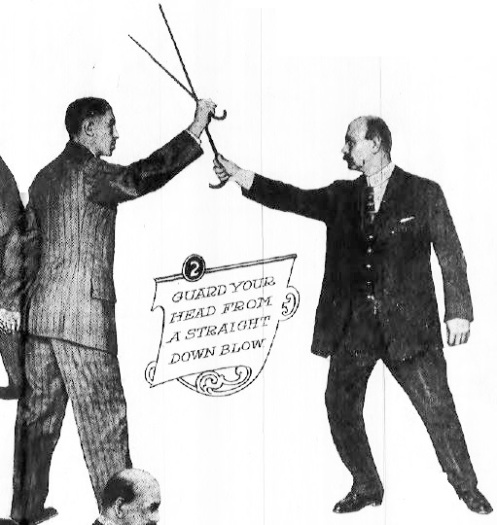
3. After you have stopped his blow at your own head you have a chance to hit him in return over the ear. The instant you feel the contact of his stick start your counter blow. His cane will be stopped and you can whirl your own cane out in a swinging blow against his temple. In striking, keep your thumb out along the back of your cane, as you can guide your blow better in that way.
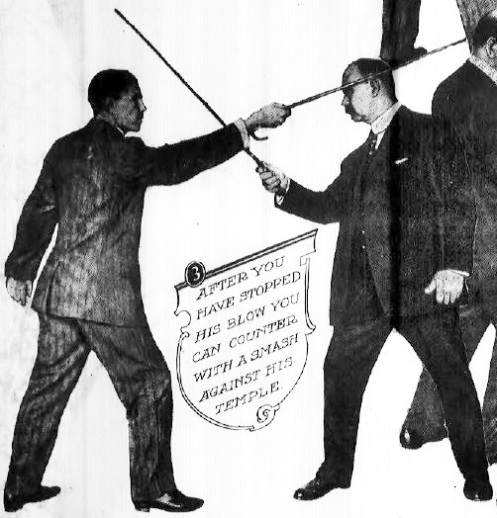
4. If he springs out upon you with a weapon from your right, hit him across the back of his hand. He will drop whatever he is holding. Don’t waste time by raising your cane too high; put the force into it with the wrist. But strike hard. If he raises his hand he will expose the back of it for an instant. That is your time. If he holds a revolver be sure that you strike before he has you covered.
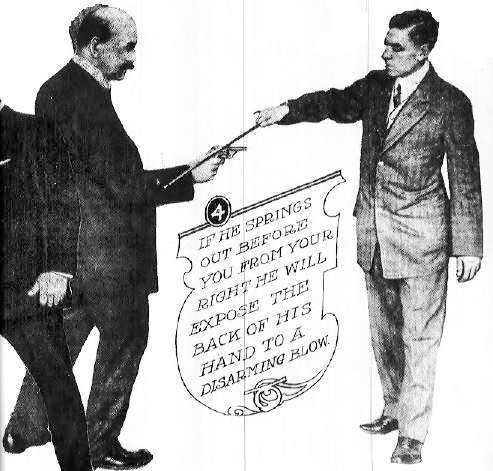
5. If your assailant springs upon you from your left you cannot reach the vulnerable part of his hand. If, on the instant, you jab him in the chin you may bewilder him long enough to enable you to follow up with a blow across the side of his head or the back of the hand holding the weapon. But you are at something of a disadvantage.
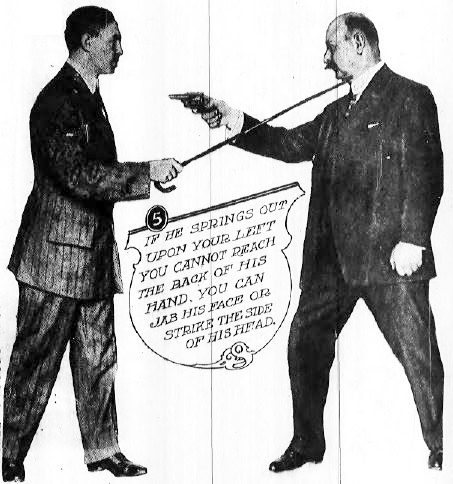
* *
Story of Ginger and Pepper.
I can almost remember when the cane was the generul thing and when few men went without them at night, and many people in good circumstances carried them in broad daylight, and they were people who were by no means “dandies.”
One can never tell when an attack win come. They come usually when least expected, as that seems to be one of the fortifications the thief takes—taking his intended victim by surprise.
I am reminded of a story I heard when in Australia which applies in this case. An old townsman had been advised in his youth to carry a small quantity of red pepper concealed about his person at all times to defend himself against the possible attack of mad bull, this being a big cattle district. He was also advised to carry some ginger to throw into a mad dog’s face. He carried the ginger religiously for many years, but did not see fit to carry the pepper, as he claimed his animals were harmless.
It so chanced that he was walking in his pasture one day whan a mad bull attacked him and almost gored him to death. He did not have the pepper when he wanted it, and he had been told that the ginger would have no effect on a mad bovine. This story illustrates thti value of being prepared.
In my article next week I am going to give some photos and diagrams showing how women may defend themselves with an ordinary parasol or umbrella in case of attack on the street. Women have been known to fatally wound assailants with the timely use of the umbrella rod, and I have gone into this carefully and have found the best and most simple rules to follow out.
Do not lot your pride hold you back in preparing yourself for the use of the cane. When you are cracked on the head some fine night you might regret the inability to use your cane effectively, or the absence of any cane, and then you will remember what I have said here.
* *
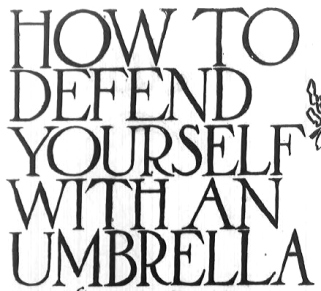
By The Marquis of Queensberry.
There Are Three Possible Movements With the Sharp Steel Rod of The Ordinary Umbrella That Will Disable An Assailant, If The Umbrella is Handled Properly.
Diagrams Showing How Women Practice These Movements.
WHY should women not learn to defend themselves? The “manly” art of self defense may be for men only—there is a difference of opinion as to this. In some households—but there are other methods besides the fist. The hatpin has been used upon occasion with terrible effect, and the steel rod umbrella or parasol in proper hands may be almost as deadly as the rapier.
The present attitude of American women invites aggression. Remember the parable of the dog and the cat. The dog may regard the cat with amiable indifference until the cat starts to run away. Then, the moment the cat shows fear and weakness, the savage instinct of the chase is roused and the dog attacks.
The instinct is primal. Few of us but feel it. The weak are their own worst enemies. Given, therefore, a dark, deserted street, a woman glancing timidly from side to side, a vagabond, perhaps well dressed, probably inflamed with alcohol, and the stage is set for robbery and tragedy,
* *
All Women Not Defenseless.
Women should not go out at night alone. But this cannot always be avoided. Some are forced to take the risk by their employment, others by unforeseen circumstances. Still others, and these form the greater number of those who come to grief, take the risk for no adequate reason. They find it stupid to stay at home, there is no man handy to escort them, and they go alone.
The woman who finds herself obliged to pass through the streets unattended owe a duty to the public—she should learn to defend herself to the best of her ability. Not all women are defenseless creatures; the news reports show that. More than one has successfully fought off or captured a highwayman where her husband or brother would have stood tamely and surrendered. At the age of 10 the average girl is almost a match for the average boy of the same age. There is no reason, save only mental attitude and hobble skirts, why an active young woman should not defend herself and her property with effect.
The carrying of firearms concealed is a misdemeanor. But prominent men have advocated it for women. The story is still new of the policemen’s wife in a western city who carried her revolver in a paper big and winged the miscreant who attacked her at a dark corner. Women have an odd fear of firearms, but all women can and do carry a parasol or an umbrella. In the umbrella the woman of courage and skill has a weapon of considerable merit. It is always at hand, for one thing, and its efficiency is shown by half a dozen reports of men killed by its thrust.
The steel rod parasol or umbrella, to be an efficient weapon must be used as a rapier. This straight, edgeless sword in the hands of the gentlemen experts of another day was a most deadly weapon; its thrust meant death. The parasol of today has many of its qualities. It is sharp and light and, when of sufficiently good quality, it is strong. It is the opinion of competent swordsmen that in skillful hands and with force behind it, the sharp point might be driven through the clothing and walls of the chest. Certainly there is no question that it will inflict painful injury upon the face and throat. Should the point penetrate the opening at the back of the eye socket—as it sometimes has—it would mean instant death.
The woman who wishes to defend herself with her umbrella must learn two things: to thrust with speed, force, and precision, and to have perfect command of her feet. The first can be acquired by a little instruction and a good deal of practice. The second is hardly possible with the narrow skirt. But fortunately by the time one is learned the other will have gone out of fashion.
* *
Preparedness Assurance of Victory.
One who is always prepared for attack will come out victorious under almost every circumstance. Suppose you are passing through a deserted street. A man comes toward you. You do not like his appearance—the fact he is well dressed does not guarantee anything—and you prepare to defend yourself. When the enemy is a few yards distant you shift your usual uncertain grasp to a firm grip on about the center of the handle, the fingers around the handle and the thumb toward the point. As the man approaches with some hostile demonstration the umbrella, generally used as a defense against a downpour, flies forward in a businesslike manner, the steel point toward the enemy. You, behind the point, have drawn a circle of safety about yourself for a few seconds.
Happy are you if you wear on this occasion an old fashioned skirt, for a perfect freedom of movement is most important. But your left hand is free and you must do your best to get your skirt up out of the way. The enemy has been surprised by your stand and the quicker you can deliver your thrust the better. Do not try to thrash him with your umbrella as with a barrel slat. Leave that to the vaudeville comedians. You cannot hurt him that way. You must use the point. Thrust out boldly and bravely, adding the weight of your body to the strength of your arm. Try your best to deliver this thrust right in his face. Don’t be afraid of spoiling his beauty, as he deserves to be marked by a woman’s hand.
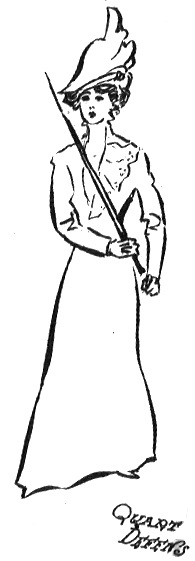
Should your unexpected attack fail to produce the expected result be sure to recover yourself quicker than the surprised enemy. Don’t, don’t, don’t stand there and let him grab your umbrella. Retire quickly into the position of defense—a back step or two will do—and thrust again. Should the men attempt to strike you with a cane or something of the sort you may be forced to parry his blow. Hold your umbrella or parasol with the point up and in such a manner that his stick will strike across it and be deflected to one side or the other without touching you.
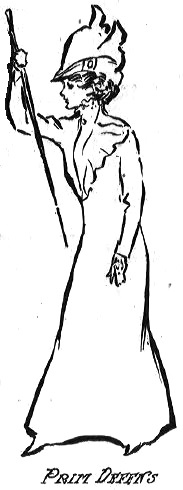 * *
* *
Three Stages in Advancing.
Your foot work is of supreme importance. It is not hard, but it cannot be managed by one who has not practiced. A girl who dances should find no difficulty. Never cross your feet if you can help it and do not lose your balance.
In advancing there are three stages:
1. The step—Your right foot is forward, your weight about equally divided. The left foot is brought forward quickly to the right. The right is advanced. In the diagram, the shaded imprint represents first positions.
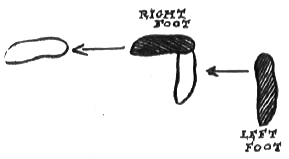
2. The Jump—In order to come into striking distance quickly spring forward with both feet at once. To get the force bend the knees somewhat more than in ordinary position.

3. The attack—Keep the left foot in position and lunge forward till the left limb is straight. Land with the right foot so far forward that the knee forms a right angle.
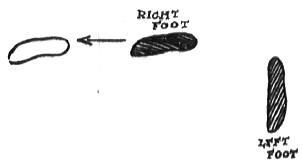
In sidestepping move so as to keep the point of your umbrella always toward your assailant. You can move to either side. Move the left foot first and follow with the right.
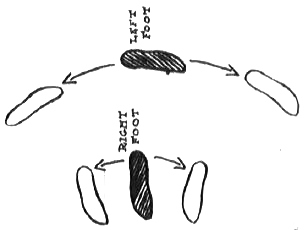
To retreat, reverse the movements of the advance. In springing backward remember your skirt—remember your skirt! In stepping backward, start with the right foot. When it is behind the left, move the left back so that the relative position is maintained with the right foot toward the enemy.
RULES FOR DEFENSE WITH UMBRELLA.
1. Lunge for his face. Grasp the parasol or umbrella firmly, with the thumb extended along the handle to guide the thrust. As you lunge you are standing with your right foot somewhat forward. The left foot remains as it is. Throw yourself forward on it, and plant the right foot as far forward as you can. This sends your umbrella point forward with great force. Your right knee should form a right angle; your left limb should be straight out behind you.
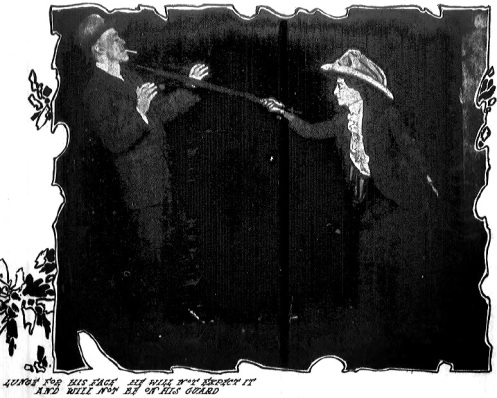
2. Do not let him grab your weapon. The instant your thrust lands or misses step back and raise the umbrella out of danger. Either jump back or step back, the right foot first. Remember your skirt and keep it clear.
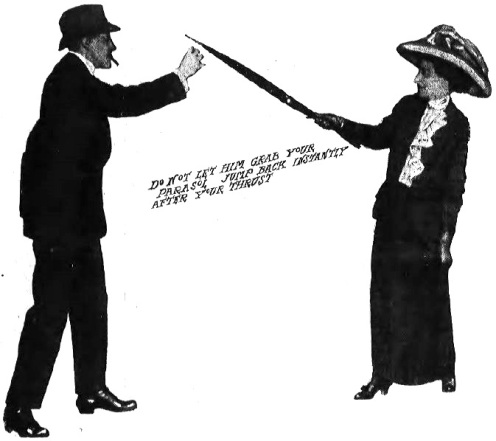
3. If he strikes with a sidewise swing of his cane at your head you can duck the blow and thrust at the same time. As he strikes step back with your left foot as far as you can without changing your right. Drop your head forward. This will bring you under his swing. At the same time direct a thrust with all the force of your arm toward the enemy’s face or unprotected neck.

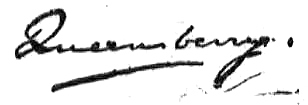
On Sunday, March 22, 1840, the following unusual notice appeared in the Times-Picayune:

Mons. Bobji–or Bobij, as he was more widely known–was an extraordinary character who had recently arrived in America from Europe. French by ancestry, Polish by birth, and a former Lieutenant Colonel in the Polish army, he had taken part in a failed revolution in his homeland, then enlisted in the Russian military, escaped again, and traveled throughout Europe, where, pursued by “evil genius,” he survived multiple assassination attempts, one of which left “a large scar from a poniard directly over [his] left eye”. Bobij finally fled to the United States, where he offered instruction in fencing, and gave public exhibitions demonstrating the use of the broadsword, smallsword, bayonet, Bowie knife, dirk, dagger, quarterstaff, lance, and most notably, “two swords, one in each hand.” Especially tantalizing was Bobij’s announcement that he was presenting a “new system of defence with the Bowie…
View original post 2,352 more words
“You need never despair of saving life till you have tried faithfully for at least an hour and a half…”
The following interesting article, which details methods for resuscitation and “the saving of life,” originally appeared in the New York Spirit of the Times, in May of 1878.
The author was the noted swordsman, soldier, and adventurer, Colonel Thomas H. Monstery, who reportedly fought more than fifty duels and served under twelve flags. Monstery also taught a system of self-defense that included punching, kicking, grappling, head-butting, and other techniques of unarmed and armed self-defense, as detailed in his martial arts treatise, recently republished as Self-Defense for Gentlemen and Ladies.
Monstery, who had trained at both the the Central Institute of Physical Culture (Kungliga Gymnastiska Centralinstitutet) in Stockholm and the Royal Military Gymnastic Institute (Kongelige Militaire Gymnastiske Institut) at Copenhagen, later settled in the United States, where he opened a number of academies that provided instruction in the arts of fencing, boxing, self-defense, and swimming.
Regarding the following life-saving techniques, Monstery stated that such instruction was neccessary, because “hardly ten men in any State of the Union know how to save the life of another without danger to their own safety.” Notably, Monstery’s techniques utilize such unusual tools as string, rubber-bands, bricks, driftwood, hot bottles, and “a glass of the best spirits procurable.”
This additional article, not included in the republication of Monstery’s martial arts treatise, gives additional insight into the life, mind, and techniques of this remarkable character.
By Colonel Thomas H. Monstery.
Graduate of the Royal Military Institute of Gymnastics and Arms
in Denmark, and Professor Ling’s Central Gymnastic Institute of
Stockholm; Professor of Arms in Sweden, Denmark, Germany, Russia;
in the Service of Spain, Central and South America, and the Mexican
Republic; formerly of Baltimore, and late Eight Years Instructor
in the San Francisco Olympic Club.
Life saving motions are taught in scientific swimming-schools by a regular drill, so as to give confidence to the swimmer and accustom him to go to work in the right way, with the least danger to himself and with the best chance of saving his comrade. They are compounded of backswimming and tread-water motions, and best performed on the back, with both feet and one hand, the other hand being used to support the drowning person. The position of the body is oblique in the water, the motion of the legs and arm the same as in tread-water, but owing to the oblique position of the body, progress is made by the motions. To become familiar with the saving motions, assume the oblique tread-water position, keeping one arm hugged close to the breast, and swim in all directions till you have mastered the secret, after which, change hands, and practice swimming with the other arm hugged to the breast. Observe that the feet move alternately, as in tread-water. Simultaneous motions, as in the common breast and back swimming, cause too much rising and falling in the water from the oblique position, to be practiced in life-saving.
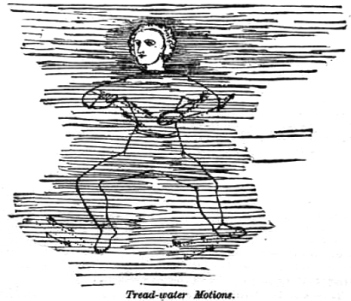
When these motions are thoroughly learned, you will come to the real practice of saving, beginning by the carrying of weights. Procure, if convenient, a straw sack, with enough weights—stones or similar articles—in the bottom, to make the lower part heaviest, and the whole sack a little heavier than the water. This “dummy” is to represent the drowning person, and you must remember that you cannot safely tow a drowning person to shore unless he or she be as quiet and unresisting as the dummy. Practice with the dummy in the same manner as without it, hugging it to the breast with the arm that was before idle, letting the lower part of the sack fall between your feet, and practicing swimming to and fro with it till you can carry it without any distress a hundred yards or so.
What can be done by a swimmer carrying a burden in this way is shown by an instance which I heard of at Copenhagen, where a certain brewer swam in this manner, carrying another man a full Danish mile, that is more than three of oar miles. It is true that this swimmer was very muscular and fleshy, and floated easily, but under any circumstances it was a tremendous feat, which in the end caused the swimmer to lose his health for life from the effects of his exertions. By no other way of swimming could he possibly have accomplished the task.
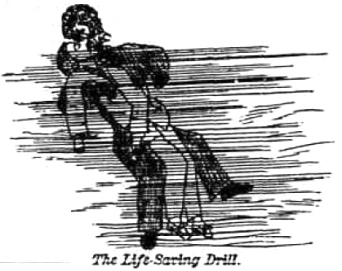
“If you can catch him by both arms, between the shoulder and elbow, from behind, you will have the best chance to escape his clutch…”
Having practiced with the dummy, the saving of life becomes comparatively easy, and only requires a little advice and a knowledge of the usual behavior of drowning persons. In saving you must be careful not to approach the drowning person in front, as he is sure to clutch at you and try to mount to the surface on your shoulders in the wild instinct of despair, being moreover in a stupefied condition. Approach him, therefore, from the rear, and if he tries to seize your limbs, keep away. If you can catch him by both arms, between the shoulder and elbow, from behind, you will have the best chance to escape his clutch. Let him sink twice, if he is strong, and do not attempt to save him till he comes up the third time, when he is nearly senseless and quits quiet. If you are caught by him, endeavor to duck his head under the water till he lets go. Try to get your knees up between him and you, and then push him away with knees and feet, and you will surely break from his hold. In fact, a desperate drowning person must be more than half drowned before it is safe to approach him. An exhausted swimmer sinking is not so dangerous, as he generally keeps his presence of mind when he feels a friendly hand seizing him, and allows himself to be supported. As soon as the person to be saved is quiet, take him round the body, under the arms, lying with his back on your breast, which will tend to restore confidence if he has any sense left. Do this in the same manner as that in which you carried the dummy. Then take him to shore, keeping his mouth above water. What to do with him when ashore will be shown next.
“As long as the limbs are flexible and the body is not cold and stiff, a prospect remains of restoring life…”
It has often happened that persons have lost their lives from having been under water less than five minutes, owing to the ignorance of the people who tried to restore consciousness by improper methods. On the other hand, instances have been known in which drowned persons have been restored to life after being under water for fifteen or twenty minutes, in a few cases even longer. The fact is that science has been unable to determine exactly at what moment life becomes entirely extinct in a body, and the process of recalling animation to an apparently lifeless body is not entirely hopeless until every method has been tried for several hoars. As long as the limbs are flexible and the body is not cold and stiff, a prospect remains of restoring life. Every person who learns to swim should therefore never be satisfied unless he knows how to save the life of a drowning person, first by bringing bim ashore, second by reviving him.
“If you have a rubber band in your pocket, pull out the tongue of the drowned person and pass the band round tongue and chin…”
As soon as the body is brought to shore it should be rubbed dry with a coarse towel and vigorous friction. Lay it on the ground immediately, while this is being done or before it, face downward, the pit of the stomach resting on a hard pillow, six or eight inches high, made up of anything you can find in a moment. A folded coat, on a stone or piece of driftwood, will answer the purpose. Press, with quick jerks, on the back of the body with the palms of the hands, forcing the stomach and diaphragm against the pillow. This discharges the water that has been swallowed almost instantly.
In the directions which follow I have detailed the method used by Dr. Silvester, of England, and published by the Royal Humane Society. It’s great merit is that it can be employed by a single person in case of no help being near. If obedient assistants are available they make the work easier.
Turn the body on its back on the same pillow, chest arched upwards. Clean out and dry the mouth with a dry handkerchief, and draw forward the tongue, which must be kept projecting beyond the lips, so that it not fall back and cover the windpipe. There are several ways to effect this. If you have a rubber band in your pocket, pull out the tongue of the drowned person and pass the band round tongue and chin. If no band is forthcoming, a string will do the business. If nothing else is at hand, close the lower jaw on the tongue, so as to keep it from falling back. The upper part of the body must be stripped of everything tight, if not already naked. Now you are ready to imitate the movements of breathing.
“This is the whole secret of artificial breathing…”
Kneel down by the head of the drowned person, and take the arms just above the elbow. Draw them up above the head, and keep them there for two seconds. Then turn them down, and press them firmly, and as hard as you can, against the sides for the same period.
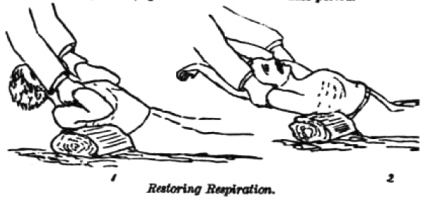
This is the whole secret of artificial breathing: The arms are to be worked up and down slowly and regularly, ending each stroke with a strong pressure on the sides. The pressure forces out the air from the lungs, while working the arms up draws it in. There are several ways of inducing this artificial breathing, such as slowly turning the body on the face, working one arm up, then over on the side again. I have chosen the method above detailed as the simplest of all, and because it requires only one person. If there are more helpers, one can take each arm and work it, while the rest irritate the nerves. All the rubbing should be done toward the heart, to stimulate the return of the blood in the veins. Hot bottles and bricks can be placed to the body to restore warmth.
All these measures, however, are useless till the breathing is restored, and the artificial respiration must therefore be continued without ceasing. Instances have been known where persons have been restored by artificial respiration after three hours work, so that you need never despair of saving life till you have tried faithfully for at least an hour and a half.
Never allow a body to be carried with the head down, or rolled on a barrel, as is the common superstition of ignorant people living by the waterside. Either practice is nearly certain to kill the patient. The most common of all superstitions is that the drowned person has swallowed a great deal of water, which must come out. This is a grave mistake. Very little water is really swallowed, and it is only the small quantity in the windpipe that must be pressed out by squeezing the body on the pillow, as described above.
“As soon as natural breathing recurs, a glass of the best spirits procurable, half water, and hot, if possible, should be given…”
The first indication of returning life is a sound between a gasp and a groan, and indescribably painful to hear. As soon as this occurs, hurry the side pressures, and work the arms more rapidly. Let the pressures be lighter but more rapid as respiration returns. The next indication of life will be a movement of the eyelids. As soon as this takes place, give a teaspoonful of some strong spirit, and continue the artificial breathing, but with slighter pressures, till natural breathing takes place. The friction of the body must be continued, after breathing returns, with more energy. As soon as natural breathing recurs, a glass of the best spirits procurable, half water, and hot, if possible, should be given, after which the patient should be wrapped in blankets, and made warm and comfortable, and allowed to sleep. The general idea of restoring drowned persons is, it will be seen, first to restore respiration, and, when that is accomplished, to bring back sensation.
I think that I can hardly do better than to close this series of articles by some general hints on the subject of accidents.
“Never allow a sea to break over you, but always dive head first through it…”
Always bathe at flood-tide any time before the full, as the tow is then toward the shore. When the tide is ebbing, the under tow eels out, and that is the time of danger for swimmers. Therefore, during ebb-tide, if you bathe at all, never venture out of your depth, or you may be swept out to sea by the undertow. Never allow a sea to break over you, but always dive head first through it. After a moment, turn up your head and you will find yourself on the other side of the wave. Avoid confusion if you chance to be struck by a breaker, and remember that it only lasts for a moment. Risk nothing for mere pleasure, and remember that even the best swimmer may be drowned by an attack of cramp while swimming. If you are subject to cramp avoid bathing out of your depth but, if you chance to be taken with it unawares, strike out the cramped limb with violence, turn your toes up to the shin, fight hard against the contraction, and above all never lose your presence of mind. Remember always that you can swim with your hands alone, your feet alone, or on your back with hardly any motion of any limb.
“The last and best rule on the water is ‘Always keep your presence of mind…'”
If you are out boating and get capsized, knocked overboard by a swinging boom, or in any manner find yourself in the water with all your clothes on, the first thing to do is to get your boots off and, inasmuch as boots are to get off, I should recommend you always to wear low shoes when out boating, in case of such accidents. If you jump overboard to save a drowning comrade kick off your shoes and throw aside all the clothes you possibly can before you leap. If there is a coil of rope lying loose, take the end with you when you leap, as it may save two lives when you reach the drowning person. Anything loose that will float may be thrown to the drowning person before you leap, as it increases the chances for both of you. Start the cry of “man overboard” at once, so that the helmsman can luff up and stop the vessel’s way as soon as possible. If a man falls off a wharf always shout before you jump, to attract help. If a man falls overboard from the bow of a paddle steamer it is useless to leap after him from thence. Better run to the stern, stripping as you go, and jump off there, shouting “Man overboard!” If you jump off forward, there are two men under the paddle wheels, and the chances are that both will be stunned and drowned. By running to the stern you have a chance to save a senseless man. Besides this, you will probably run along the veesel’s deck a little faster than the vessel and the man pass each other, and so will gain time and distance on both, coming nearer to the man who is in danger. The last and best rule on the water is “Always keep your presence of mind.”
Colonel Thomas H. Monstery‘s martial wisdom survives in his treatise on Boxing, Kicking, Grappling, and Fencing with the Cane and Quarterstaff, which was recently published by North Atlantic Books in book form for the first time. This volume contains a new, detailed biography of Monstery, and includes additional writings by the Colonel.
Additional articles about Thomas H. Monstery can be found here as well.

Sword dancer in the old city of Shanghai
During the eighteenth and early nineteenth centuries, the history of martial arts in the United States was purely western, encompassing European-style pugilism, wrestling, fencing, as well as a diverse assortment of indigenous Native martial arts.
That changed on July 2, 1830, when the New York Evening Post printed a vivid report entitled “Pugilism in China.” This article appears to be the first account published in America regarding the existence of Kung Fu, and is reprinted here:
“The art of self defence is regularly taught in China…The first lesson for a Chinese boxer consists in winding his long tail tight around his head, stripping himself to the buff, then placing his right foot foremost, and with all his might giving a heavy thrust with his right fist against a bag suspended for that purpose. He is directed to change hands and feet alternately, restraining his breath, and boxing the bag of sand right and left for hours together. This exercise the fancy call ‘throwing down walls and overturning parapets.’ In the second lesson the pugilist grasps in each hand a heavy mass of stone, and having stripped, and arranged his tail as before, he practices thrusting out at arms’ lengths these weights, right and left, till he is tired. This lesson is called ‘the golden dragon thrusting out his claws.’ Next comes ‘a crow stretching out his wings—a dragon issuing forth from his door—a drunken China-man knocking at your door—a hungry tiger seizing a lamb—a hawk clawing a sparrow—a crane and muscle reciprocally embarrassed,’ and other specimens of fanciful nomenclature, for divers feats of pugilism.”
The article in the Evening Post indicated that the original text had appeared in the Canton Register.
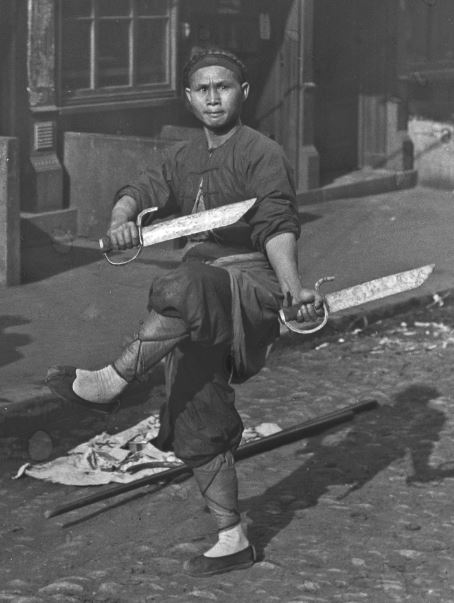
Sword dancer in San Francisco’s Chinatown, by Arthur Genthe, 1896-1906
Although it is possible that the first arrivals from China may have brought such martial practices with them to America at about this time (the 1820s and 1830s), for the next fifty years, the media remained silent as to their existence. It would be nearly 60 years–not until February 27, 1890–that the first exhibition of Kung Fu in the United States would be unveiled to the American public.
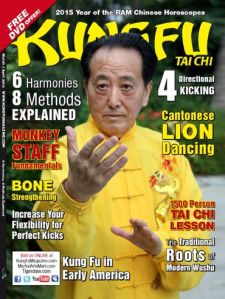 NOTE: A greatly expanded version of this article, covering other Kung Fu contests and practitioners of the same period, and accompanied by photographs, appears in the 2015 March/April issue of Kung Fu Magazine, under the title Kung Fu in Early America.
NOTE: A greatly expanded version of this article, covering other Kung Fu contests and practitioners of the same period, and accompanied by photographs, appears in the 2015 March/April issue of Kung Fu Magazine, under the title Kung Fu in Early America.
If you liked this article, you may also be interested in the following, also about the early history of Chinese martial arts in America:
The First Exhibition of Kung Fu and Chinese Martial Arts in America: Brooklyn, 1890
First Report of a Bare-Knuckle Kung Fu Contest in New York City’s Chinatown, 1891
An American reports from China on Kung Fu eye-gouging contests, 1891
Vivid Report of Chinese “Gladiators” Reaches New York in 1891
Although this article details an event held in New Orleans, it was held by the New York City-based Martinez Academy of Arms (featured on this site), and provides a nice firsthand account of a rare classical and traditional fencing event in our modern era.
Columbia Classical Fencing, LLC
Recently, I was privileged to participate in the first ever Martinez Academy of Arms Academia in New Orleans, Louisiana. This was a gathering of all the MAA schools and academies, including Palm Beach Classical Fencing, Côte du Golfe School of Fencing, Salle St. George, and Destreza Pacifica School of Arms. And it was one of the most impressive fencing scenes I have ever witnessed.
Before continuing, I should make a full disclosure: I am not officially a member of the Martinez Academy of Arms or any of its affiliated academies or schools. Moreover, I did not learn to fence under Maestro Ramon Martinez or Maestro Jeannette Acosta-Martinez, and was introduced to the maestri only a few years ago. Nonetheless, I cannot say that I am unbiased.
Since meeting them, Maestri Martinez and Acosta-Martinez have been unimaginably generous to me: teaching me whenever possible, gently correcting my faults, and encouraging me. Unfortunately, due…
View original post 738 more words
“A neater and more effective blow was never struck by the human fist…”
The following gem of an article, entitled “The Use of the Fists: How to Employ Nature’s Bony Weapons Effectively,” appeared in the June 13, 1886 issue of the Chicago Tribune, and contains a firsthand account, by a reporter, of a visit to the school of the noted duelist, swordsman, martial artist, soldier, and adventurer, Colonel Thomas H. Monstery.
Monstery, who reportedly fought more than fifty duels and served as a soldier under twelve flags, taught a system of self-defense that included punching, kicking, grappling, head-butting, and other techniques of unarmed and armed self-defense, as detailed in his martial arts treatise, recently republished as Self-Defense for Gentlemen and Ladies.
The article that follows, which contains a lengthy interview with Monstery, includes several illustrations clearly based on those published in Monstery’s treatise, however, they have also been embellished with additional detail and features to make the figures more closely resemble Monstery.
This article gives additional insight into the life, mind, and techniques of this remarkable character.
A Talk with Col. Monstery, the Veteran Soldier, Swordsman and Instructor—Popularity of the Fistic Art Increasing In Chicago—How Jem Mace Was Astonished by an Amateur He Expected to Amuse Himself With—A Sixty-Odd Year Career of Stirring Adventures.
A few days ago a gang of laborers were at work upon the foundations of a new building in the business portion of the city when one of them, a burly Celt, objected to the order given to him by the superintendent of the work. The latter, a fine-looking splendidly-proportioned man of 30 or thereabouts, insisted on the fulfillment of his instructions. He was fashionably dressed, but it was very evident that he was a man who would stand no nonsense. The laborer demurred, and the superintendent insisted. The refractory Hibernian muttered. something about “not taking no orders from no blankety-blank swell.” There was a cold, steely gleam In the eyes of the superintendent. He approached the recalcitrant knight of the hod and let out his right arm with the swift direct movement of a piston-rod. His clenched fist came into contact with a Milesian jaw, and a burly son of Erin dropped down among the surrounding bricks and mortar. A neater and more effective blow was never struck by the human fist. The discomfited laborer presently picked himself up, shook the brick dust from his hair, and went to work. The gladiator in broadcloth saw his order executed and went his way, followed by the admiring glances of the bystanders.
“Who is he?” was asked of a bystander who had witnessed the brief encounter. “He is one of the best amateur boxers and general athletes in the West,” was the answer. “His name is Miles G. Nixon, and he is a well-known North Side resident.”
“But where did he learn his science?”
“His eyes are as keen as a hawk’s, his arms are like iron, and he is as active as an acrobat…”
 “Come with me and I will show you,” answered the bystander. And forthwith THE TRIBUNE reporter was led to a building on Randolph street up two narrow flights of stairs and into a spacious room that looked like a small arsenal as much as anything. The walls were invisible by reason of the swords of every variety, the gloves of all sorts, the paraphernalia for every kind of athletic pastime and exercise which depended thereon. Two young men occupied the centre of the apartment. Their heads and bodies were protected by masks and armor so effectually that they resembled Paul Boynton full aquatic regalia. They were going through one broadsword exercise, and were at it hammer and tongs, while a third person stood by, sword in hand, giving points and illustrating with precept and practice. At the entrance of visitors the combatants ceased their cutting and slashing, while the instructor came forward, and the reporter was introduced to Col. Thomas H. Monstery, a man who ties been concerned as principal or second in over forty affairs of honor, who fought valiantly in the Mexican War and in the recent “unpleasantness” and whose anatomy is a perfect war-map of scars and wounds. The Colonel is nearly 65 years old. He is a trifle under six feet in height and his figure is as upright as a plumb-line. His light-brown hair is brushed straight back from his forehead, his mustache and goatee are carefully wrought to a point at each extremity and he is the picture of an old soldier. His eyes are as keen as a hawk’s, his arms are like iron, and he is as active as an acrobat. Such is Col. Monstery, master of the art of fence and expert at athletes in general at your service. He smiled a bland and complacent smile when the episode in fisticuffs related above was told to him. “Aha! I should like to have been there,” he exclaimed. “I don’t blame the poor fellow for dropping all in a heap. That blow is one that there is no standing against; that is the Monstery blow.”
“Come with me and I will show you,” answered the bystander. And forthwith THE TRIBUNE reporter was led to a building on Randolph street up two narrow flights of stairs and into a spacious room that looked like a small arsenal as much as anything. The walls were invisible by reason of the swords of every variety, the gloves of all sorts, the paraphernalia for every kind of athletic pastime and exercise which depended thereon. Two young men occupied the centre of the apartment. Their heads and bodies were protected by masks and armor so effectually that they resembled Paul Boynton full aquatic regalia. They were going through one broadsword exercise, and were at it hammer and tongs, while a third person stood by, sword in hand, giving points and illustrating with precept and practice. At the entrance of visitors the combatants ceased their cutting and slashing, while the instructor came forward, and the reporter was introduced to Col. Thomas H. Monstery, a man who ties been concerned as principal or second in over forty affairs of honor, who fought valiantly in the Mexican War and in the recent “unpleasantness” and whose anatomy is a perfect war-map of scars and wounds. The Colonel is nearly 65 years old. He is a trifle under six feet in height and his figure is as upright as a plumb-line. His light-brown hair is brushed straight back from his forehead, his mustache and goatee are carefully wrought to a point at each extremity and he is the picture of an old soldier. His eyes are as keen as a hawk’s, his arms are like iron, and he is as active as an acrobat. Such is Col. Monstery, master of the art of fence and expert at athletes in general at your service. He smiled a bland and complacent smile when the episode in fisticuffs related above was told to him. “Aha! I should like to have been there,” he exclaimed. “I don’t blame the poor fellow for dropping all in a heap. That blow is one that there is no standing against; that is the Monstery blow.”
“Excuse my ignorance, Colonel, but what is the Monstery blow?”
“If I deliver a thrust with the ‘line of power’ behind it, the bones and muscles all backing each other with cumulative force, the foil would go right through you…”
“Well, you must know that I am the originator of a system of scientific boxing. I introduced ten years or more ago the method of evasion as a means of defense preferable to parrying; ‘ducking’ is the current term for it. The offensive tactics are the more important however; the blow is the great thing in boxing. Success all lies in knowing how to hit—to establish a line of power from the shoulder to the knuckles of the second, third and fore fingers. The principle is the same in fencing. Let me take a foil and deliver a thrust glancing downward and the point will only scratch you, whereas if I deliver a thrust with the ‘line of power’ behind it, the bones and muscles all backing each other with cumulative force, the foil would go right through you. I discovered the scientific blow that Sullivan uses—his ‘knock-out’ blow. It remained for a man thoroughly acquainted with the art of fencing to discover this blow, which is produced exactly like a thrust in tierce, see? A blow so dealt by a powerful man will stun an ox, and a scientific lightweight or gentleman amateur can by means of it hold his own against any slugger in the ring who is unfamiliar with the principle. A man who is an accomplished fencer is invariably a good boxer; not because sword practice develops a quick eye and general activity, but because his cuts and thrusts when used with the fist as the weapon are the most powerful and effective blows that can be used on an opponent.”
“Do you find that boxing is a popular study with young men at present?”
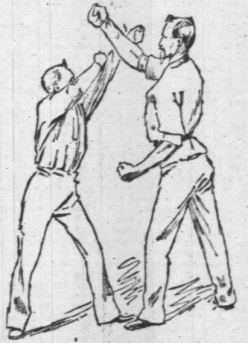 “Yes, the cultivation of the noble art is widely in favor and increasing in popularity. When I first taught in New York I found that the young men there thought boxing rather a degrading pastime; but I had not been long in Gotham when I had some of the leading younger citizens among my pupils. I taught Col. Jim Fisk boxing and fencing up to the day of his death. Fred May, who challenged James Gordon Bennett, you remember, took boxing lessons from me and he is an accomplished athlete. You know Francis Wilson the comedian, of course? Well, Wilson is not only the champion amateur swordsman of the United States, but he is also an artistic handler of his fists. Among other pupils I had in New York were Frederick Sharon, son of the Senator, James Gordon Bennett, Junius Brutus Booth, the actor who died recently. George Seligman, the bankers son, and a host of others whom I could name.”
“Yes, the cultivation of the noble art is widely in favor and increasing in popularity. When I first taught in New York I found that the young men there thought boxing rather a degrading pastime; but I had not been long in Gotham when I had some of the leading younger citizens among my pupils. I taught Col. Jim Fisk boxing and fencing up to the day of his death. Fred May, who challenged James Gordon Bennett, you remember, took boxing lessons from me and he is an accomplished athlete. You know Francis Wilson the comedian, of course? Well, Wilson is not only the champion amateur swordsman of the United States, but he is also an artistic handler of his fists. Among other pupils I had in New York were Frederick Sharon, son of the Senator, James Gordon Bennett, Junius Brutus Booth, the actor who died recently. George Seligman, the bankers son, and a host of others whom I could name.”
“How do Chicago amateurs rank in numbers and proficiency?”
“I find that there is a very general desire to learn the science of boxing. It seems to be more popular than fencing, probably because in this country it comes into more practical use. The fists are more favored weapons than rapiers or small swords. I have a number of well-known young men who come to me for lessons. Among them are Messrs. Miles G. Nixon, Al Meeker, Le Grand Smith, F. A. Pettibone, Charles Stephenson, and a score of others.”
“It was a victory of genuine science over what is known as ‘science’ in the ring…”
“None of your gentlemen amateurs could stand up against a professional pugilist, I presume.”
“Now, that is where you are mistaken.” responded the Colonel. I will give you an illustration. You have heard of the Olympic Club of San Francisco, one of the finest organizations devoted to athletic sports that ever existed in America? Of course you have. Well, in 1860 I was the instructor of that club and I introduced my system of boxing. We had young men there in that club, lithe, sinewy active fellows who used to make such a showing against the brawn and brute strength of professional pugilists that the Olympic Club of ‘Frisco became famous the country over. I had a pupil there, a young man by the name of Bennett, a fellow who compounded drugs at a corner pharmacy all day and devoted his nights to physical culture. He was an enthusiast and afterward died from the effects of overexertion. When Jem Mace, at the height of his fame, visited ‘Frisco young Bennett met him in the ring. Outsiders laughed knowingly at he thought of the way Mace was going to “do up” the audacious amateur. Mace himself seemed to think that he was going to have things all his own way. His first surprise was when Bennett parried all his best blows, and he was still more astonished when he found the druggist getting in hits that seemed of tremendous force for a middle-weight They fought six rounds and at the end of the sixth, Mace wished he had never tackled the amateur. It was a victory of genuine science over what is known as “science” in the ring. The meeting was private, but Bennett’s victory is a matter of record in spite of Mace’s efforts to hush the matter up.”
“While he may have twice the muscular strength of a scientific boxer, he will be helpless when his force encounters superior skill…”
“I can tell you, there is no such boxer as the gentleman amateur when he is properly instructed and has a fairly powerful physique as a foundation for his skill. Take an ordinary workingman, and while he may have twice the muscular strength of a scientific boxer, he will be helpless when his force encounters superior skill. This Mr. Bennett to whom I refer was by no means the best man in the Olympic Club. Probably the champion of the organization was William O’Reilly, who was one of the most artistic boxers I ever saw. When George Rooke was at his best, O’Reilly met and vanquished him. I also taught young Robinson, who held his own so well against Slade, the Maori. Jem Mace used to claim that in this encounter, O’Reilly’s success was owing to the Maori purposely not having done his best, but that is a rather gauzy subterfuge. Tommy Chandler, the celebrated lightweight, was a pupil of mine, and he uses my mode of hitting with telling effect.”
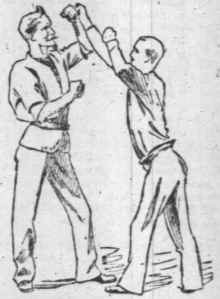 Col. Monstery has had a most interesting career made up of exciting experiences. He prides himself upon his finesse as a swordsman rather than on his skill with what pugilists would call his “dukes.” He has taught fencing to many stage celebrities, among the number Ada Isaacs Menken, Lola Montez, Dolly Davenport, Maud Forrester. Helen Temple, Adele Belgarde, Edwin Forrest, John McCullough, Frank Mayo, Lawrence Barrett, Daniel Bandmann, Charles R. Thorne Jr., Junius Brutus Booth the younger, and many lesser luminaries. Francis Wilson studied fencing, as well as boxing, with the Colonel, and the popular comedian succeeded in capturing the gold medal as amateur champion at the competitive games of the New York Athletic CIub in 1877.
Col. Monstery has had a most interesting career made up of exciting experiences. He prides himself upon his finesse as a swordsman rather than on his skill with what pugilists would call his “dukes.” He has taught fencing to many stage celebrities, among the number Ada Isaacs Menken, Lola Montez, Dolly Davenport, Maud Forrester. Helen Temple, Adele Belgarde, Edwin Forrest, John McCullough, Frank Mayo, Lawrence Barrett, Daniel Bandmann, Charles R. Thorne Jr., Junius Brutus Booth the younger, and many lesser luminaries. Francis Wilson studied fencing, as well as boxing, with the Colonel, and the popular comedian succeeded in capturing the gold medal as amateur champion at the competitive games of the New York Athletic CIub in 1877.
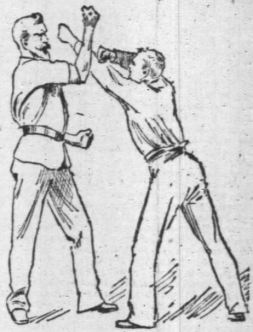 Baltimore was the Colonel’s birthplace, and his parents were Scandinavians. While he was in his early teens his father removed to Copenhagen and the lad entered the Naval Academy at the Danish Capital. Here he distinguished himself by capturing nearly all the prizes offered for athletic proficiency and he proved a terror to all who ventured to cross swords with him. His prowess received a setback, however, when in a sham fight indulged in by the cadets an explosion seriously injured his eyes. Medical skill and judicious care soon repaired the damage wrought and he was enabled to pursue his studies and exercise. After his graduation an encounter with swords, resulting in the serious wounding of his antagonist, caused young Monstery to flee from Denmark. He visited Russia, Germany, France, and England and afterward journeyed through Spain, Italy, and Holland. Everywhere his capabilities as a swordsman were of service, as the duel had not then—in 1843—fallen into disuse and disrepute. In 1845 he came to America and visited Washington, hoping by means of letters of recommendation and introduction to obtain a commission in the army, then warring In Mexico. As he was not a West Point graduate, the commission was refused. In 1849 the gold fever attracted him to California, whence he Journeyed to New Orleans, and afterward to Cuba. From there be found his way to Spain where he entered the Spanish service and was shortly afterward sent to Cuba to instruct the Spanish forces there garrisoned. At Havana, Col. Monstery met a Spaniard named Galletti, who bore the reputation of being the most skillful swordsman on the island. Just before the meeting which was arranged between the two Monstery was taken ill. A physician was called in to bleed him who succeeded in inflicting serious injury to the Colonel’s sword-arm. This physician afterward acknowledged that he was in the employ of Galletti. Subsequently the Colonel passed a number of years in the numerous Republics of Central America acting as drill-master and instructor in fencing and bayonet exercise. Here his adventures were romantic and exciting. The hero of all these escapades is a wonderfully preserved man and withal molest and unpretentious.
Baltimore was the Colonel’s birthplace, and his parents were Scandinavians. While he was in his early teens his father removed to Copenhagen and the lad entered the Naval Academy at the Danish Capital. Here he distinguished himself by capturing nearly all the prizes offered for athletic proficiency and he proved a terror to all who ventured to cross swords with him. His prowess received a setback, however, when in a sham fight indulged in by the cadets an explosion seriously injured his eyes. Medical skill and judicious care soon repaired the damage wrought and he was enabled to pursue his studies and exercise. After his graduation an encounter with swords, resulting in the serious wounding of his antagonist, caused young Monstery to flee from Denmark. He visited Russia, Germany, France, and England and afterward journeyed through Spain, Italy, and Holland. Everywhere his capabilities as a swordsman were of service, as the duel had not then—in 1843—fallen into disuse and disrepute. In 1845 he came to America and visited Washington, hoping by means of letters of recommendation and introduction to obtain a commission in the army, then warring In Mexico. As he was not a West Point graduate, the commission was refused. In 1849 the gold fever attracted him to California, whence he Journeyed to New Orleans, and afterward to Cuba. From there be found his way to Spain where he entered the Spanish service and was shortly afterward sent to Cuba to instruct the Spanish forces there garrisoned. At Havana, Col. Monstery met a Spaniard named Galletti, who bore the reputation of being the most skillful swordsman on the island. Just before the meeting which was arranged between the two Monstery was taken ill. A physician was called in to bleed him who succeeded in inflicting serious injury to the Colonel’s sword-arm. This physician afterward acknowledged that he was in the employ of Galletti. Subsequently the Colonel passed a number of years in the numerous Republics of Central America acting as drill-master and instructor in fencing and bayonet exercise. Here his adventures were romantic and exciting. The hero of all these escapades is a wonderfully preserved man and withal molest and unpretentious.
Colonel Thomas H. Monstery‘s martial wisdom survives in his treatise on Boxing, Kickling, Grappling, and Fencing with the Cane and Quarterstaff, which was recently published by North Atlantic Books in book form for the first time. This volume contains a new, detailed biography of Monstery, and includes additional writings by the Colonel.
Additional articles about Thomas H. Monstery can be found here as well.
A new article about one of the most controversial martial arts contests of the nineteenth century, held right here in New York City in 1876…a challenge that included the rapier, foil, saber, knife, and bayonet.
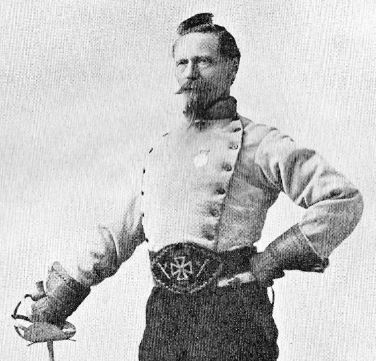 Above: Colonel Thomas Hoyer Monstery.
Above: Colonel Thomas Hoyer Monstery.
In April of 1876, New York City played host to one of the most public and controversial American fencing contests of the nineteenth century. The disagreements over judging decisions and methods of scoring were so great that “inflamed” arguments erupted between the referee and the combatants’ seconds. At times, angry audience members rushed the stage and had to be removed from the premises by police. Before the day was over, one of the combatants walked off the stage in the middle of the contest, and the entire event broke up in disorder. Eventually, the two contestants would come to personal blows. In the weeks following, conflicting accounts of the contest appeared in various New York City newspapers, and witnesses from the day published impassioned letters about what they saw, attempting to set the record straight.
Now, even more than 130 years later, it…
View original post 6,038 more words
A nice interview with Maestro Jeannette Acosta-Martinez, a New York City-based traditional fencing master:
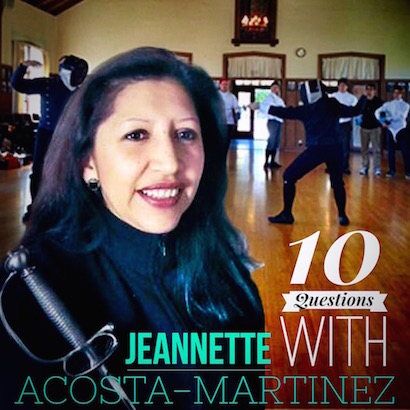 Maestro Jeannette Acosta-Martínez is a traditional master of arms, teaching classical and historical fencing. Maestro Acosta-Martínez is on the Board of Directors of the Association for Historical Fencing, was one of the original founding members of the International Masters at Arms Federation and is married to fencing master Ramón Martínez. In 2009 she created a three-volume instructional DVD on the French school of small-sword, L’École Française: A Practical and Combative Guide to the French Small-sword (Palpable Hit Productions). For more information on the Martinez Academy, please visit their website by clicking on the above image.
Maestro Jeannette Acosta-Martínez is a traditional master of arms, teaching classical and historical fencing. Maestro Acosta-Martínez is on the Board of Directors of the Association for Historical Fencing, was one of the original founding members of the International Masters at Arms Federation and is married to fencing master Ramón Martínez. In 2009 she created a three-volume instructional DVD on the French school of small-sword, L’École Française: A Practical and Combative Guide to the French Small-sword (Palpable Hit Productions). For more information on the Martinez Academy, please visit their website by clicking on the above image.
10 Questions
How did you get your start in Fencing (& how did you gravitate to the small-sword in particular)?
I moved to New York City to apprentice as an antique restorer in the late seventies. As part of my training I often went to auctions to learn to evaluate the authenticity of antique…
View original post 2,281 more words
An excellent article on cane defense in New York City, as used by James I. Pearson…
HEMA MISFITS (I don't do longsword)
As I indicated in my latest article on Irish stick fighting, outide of the traditionnal styles there exists perhaps only two documentary sources which would allow us to reconstruct a workable style of bataireacht. Both of them present characteristics which are presented in other sources as well as in the traditions. But there are also styles of stick fighting from other countries which present similar elements. This new source which I am presenting today is perhaps one of them. The Pearson style of walking stick as a weapon, or “stick control” first became known to us through a 1924 short story called “Nightmare town” by Dashiel Hammet.
Hemmet portraiying The Thin Man, one of the characters he created
When this excerpt came to the attention of the HEMA community, it was instantly compared to Irish stick, mostly for its grip. Had Hammet learned boiscin somehow or observed it?
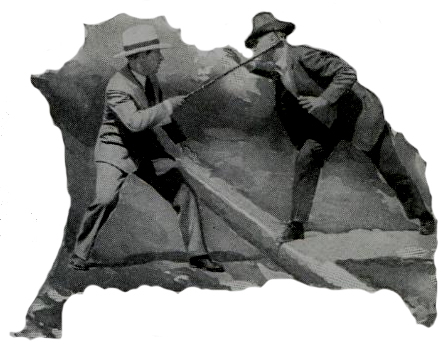 Credit…
Credit…
View original post 1,546 more words
 Above: Colonel Thomas Hoyer Monstery.
Above: Colonel Thomas Hoyer Monstery.
“A Knightly Tournament”
In early March, 1876, a “Grand” tournament of arms was announced, to be held at the Lyceum Theater in New York City, that would involve “all kinds of weapons that are used in fencing.” The event was organized and directed by Colonel Thomas H. Monstery, a noted New York fencing master and teacher of pugilism, who had reportedly participated in more than fifty duels, and fought under twelve flags on three separate continents. By all accounts, this Assault-of-Arms would be the largest, the most interesting, and the most ethnically diverse ever held in the city. It was noted that the contestants would include Danes, Germans, Spaniards, Frenchmen, Englishmen, and Americans, and that the tournament would embrace the following weapons:
Foil
Saber
Broadsword
Small-sword
Rapier
“Bowie knife”
“Spanish knife”
Cane
Sword-cane
Lance
Bayonet
“English single stick”
“German schlager”
“Sabre against bayonet”
“Knife against sabre”
“French…
View original post 2,820 more words
“It has struck me that a few words on the use of this two-handed staff may not be uninteresting at the present day…” –Thomas H. Monstery, 1878
New York City is typically not the first place that comes to mind when one mentions the word “quarterstaff.” For the average individual, unfamiliar with the history of western martial arts, the term is far more likely to conjure up images from “Robin Hood,” or of the medieval European peasantry. Yet, during the late nineteenth century, it was a Manhattan-based fencing master, Colonel Thomas Hoyer Monstery, who produced one of the few treatises on self-defense technique with the quarterstaff—the first such treatise to be published during the nineteenth century, and the only one to be published in America prior to the twentieth century. (1)
Before proceeding to Monstery’s treatise, however, it is worth taking a short look at the history of this weapon in Britain, Germany, and Scandinavia, and charting its use through the last few centuries—especially focusing on the period between 1740 and 1860, about which very little has been written during the modern era.
HISTORICAL BACKGROUND
The staff is an ancient weapon, perhaps nearly as old as civilization itself. During the late Middle Ages, treatises on fencing and armed combat often included sections on staff weapons. Later, during the sixteenth and seventeenth centuries, European authors (primarily from Britain and Germany) such as Andre Paurñfeyndt, Paulus Hector Mair, Antonius Rast, Joachim Meyer, George Silver, and Joseph Swetnam wrote detailed fencing treatises that included sections on long, two-handed staffs. Writing in 1615, British author Joseph Swetnam treated of a staff around seven and eight feet in length, which he referred to as the “quarterstaff.”
It was soon after this time that the weapon likely made its first arrival on American shores. Around the year 1680—after the British took possession of New York City from the Dutch—the City Council of New York ordered that constables and deputies be required to carry “a Halbert, halfe pike or Good Quarter staffe” while on duty. (2)
BRITAIN IN THE EIGHTEENTH CENTURY
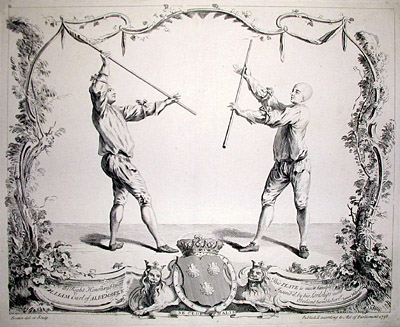
Plate from James Miller’s “Treatise on backsword, sword, buckler, sword and dagger, sword and great gauntlet, falchon, quarterstaff,” 1735
During the first half of the eighteenth century, the weapon was still commonly used throughout Great Britain, as evinced by the treatises of Sir William Hope, Zachary Wylde, Donald McBane, and James Miller. McBane, writing in 1728, noted its popularity among his fellow Scots and Britons:
“A Quarter-Staff is a weapon that has been made much use of, and is now much in request, for whoever is Master of the Staff, may defend himself against any one Man, with Back or small sword, as has often been Experienced, it is generally seven Foot long, and of Ash, if it can be had.” (3)
After the publication of James Miller’s book in 1735, no quarterstaff treatises (that we yet know of) seem to have been written until 1791, when Scottish fencing instructor Archibald MacGregor published his “Lecture of the Art of Defence,” which offers further insight into the use of the weapon:
“He may grip it by the middle and ward off a blow with either end of it; and thrust or cut which he pleases… There is a method also, of winding it like the figure eight, by catching it by the middle, and changing it from hand to hand, as you see me do. But indeed there is such a variety in it, that it would take up too much of your time to relate. It has often been known that people, who were dextrous at handling it, have forced their way through a croud, defending themselves, and knocking down numbers as they passed.”
MacGregor’s book is also notable in that it discusses how to apply quarterstaff technique to the bayonet. About this same time, at the end of the eighteenth century, the use of the quarterstaff in Britain seems to have been in general decline, as the Reverend John Wesley noted that “the noble game of quarter staff, likewise, is now exercised by very few.” (4)
However, a number of firsthand accounts indicate that British civilian and military men continued to practice, contest with, and provide instruction in the weapon. Examples of such individuals include Thomas Barret (an English instructor and prize fighter active in the 1750s); Sir Jonah Barrington (a member of the Irish Protestant Ascendancy who learned quarterstaff technique from his grandfather during the 1760s, and lived to pen his memoirs in 1827); the “famous quarter-staff master” Henkley (who gave private lessons to Lieutenant-General Henry Herbert, the 10th Earl of Pembroke during the 1780s); Christoper Towles (who instructed civilians in Coventry during the 1780s); James of Sandhurst; and soldier Harry Smith. (5, 6, 7, 8, 9) This last mentioned person (known by his nickname “the Squire”) was a native of Sussex, and the subject of an anecdote worth reprinting:
“[Harry Smith] was a complete sportsman of the Old School—skillful in the use of the cross and long bows, and at all athletic exercises—an adept at the single stick and quarter-staff, which last he would, till lately, turn with astonishing celerity. A well-known fact of his prowess in the last named exercise we subjoin: In 1779, a Sergeant of Elliott’s Light Horse being then at Chichester, and who was reputed one of the best swordsmen of the day, challenged his sword against the Squire’s staff, to draw the first blood; many are living who saw the encounter; when, at the expiration of four minutes, ‘the Squire’ gave his adversary the end of his staff in his forehead, which laid him flat on his back, and gained the victory. The staff, which is seven-feet ten-inches in length, is now preserved, and has thirteen cuts of the sword in it.” (10)
Harry Smith passed away in Chichester, in 1822, at the age of 84.
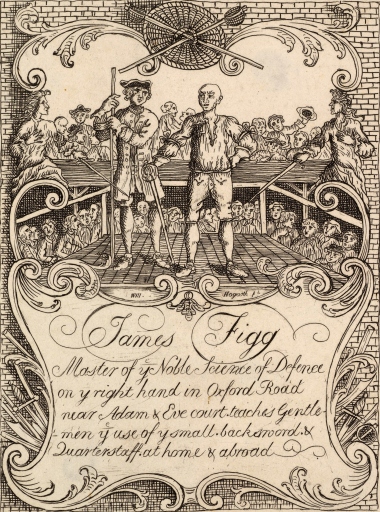
18th century trade card purporting to show James Figg offering instruction in the use of the quarterstaff. The authorship of this etching is uncertain and has been attributed to both William Hogarth and Joseph Sympson. Source: MET Museum, New York City.
THE NINETEENTH CENTURY
During the early nineteenth century, the quarterstaff was, according to one contemporary, yet “still seen in the hands of constables in some remote districts” of England, and still figured in “rustic” contests among the rural British. (11) In 1805, Cobbet’s Weekly Register extolled the virtues of “not only boxing, but wrestling, quarterstaff, singlestick” and “every exercise of the common people, that supposes the risk of life or limb, and, of course, tends to prepare them for deeds of bravery of a higher order.” (12) Several references by military men also attest to continued knowledge of quarterstaff technique. For instance, Lieutenant John Russell (Lieutenant and Adjutant of the Nottingham Staff), in his 1806 Series of Military Experiments of Attack and Defence, noted that
“Experience has proved that notwithstanding its weight, the modes of attack and defence with the bayonet may be reduced to a system similar to those of the broadsword and quarter staff; and that great advantage might be gained, in single contest, by a person previously instructed in such exercise.” (13)
Likewise, English naval officer and veteran Major John Cartwright (for seventeen years major of the Nottinghamshire Militia), writing in 1821, explained,
“Opposed to the horseman, the spearman’s point will be in the nose of the horse before the rider’s sabre can reach him; besides which, he, with his spear, will have against the sabre all the guards of the quarter staff, for defending every part of his person, and with his hands defended, which is not the case of him who handles the quarter staff, the long pike, or the musket.” (14)
Despite such continued knowledge of English staff technique, there can be no doubt that, during this period, people like Major Cartwright were in short supply. The following letter, published in the March 9th, 1828 issue of Bell’s Life in London and Sporting Chronicle, gives an idea of the state of English quarterstaff practice at that time:
To the Editor of Bell’s Life in London.
SIR— I would beg through the medium of your useful and entertaining Paper, which has so large a circulation in the sporting world, to express a wish I have long indulged, to witness the revival of the ancient, noble, and manly exercise of Quarter Staff, so successfully practiced by our hardy ancestors, and which is now nearly lost, being known only to a few individuals. Should I succeed in establishing a Society for its practice, I shall most cheerfully subscribe my might to its support, and contribute any assistance in my power to its formation; and beg to subscribe myself, Sir, yours, &c.
A TRUE-BORN ENGLISHMAN.
Although the author of this letter is unknown, it would seem that, after an interlude of several years, the writer got his wish. In 1835, Lieutenant Colonel Baron De Berenger noted that quarterstaff instruction was being offered at the British National Arena in Chelsea:
A fuller version of the above passage explains,
“Fencing, both with the Small and Broad Sword, and Self-protection with the Stick or Quarter-staff, are also taught, being branches of instruction too important to be overlooked. In the two preceding classes, the judicious application of even inferior power is demonstrated as means, where necessary, to overcome brutal and superior strength, and ferocious attacks. A Fencing Saloon, adjoining the Gymnasium, is devoted to such ends.”
These techniques, according to the Colonel, were “at present either taught by skillful professors, or practised under the guidance of experienced persons.” (15) At about the same time, the English jurist and legal reformer Jeremy Bentham wrote his “Constitutional Code,” in which he included a section on “Defensive Force,” that had been read and approved by three colonels in the British army. Here it was noted that, for the “active occupation” of the men, instruments should be provided so that “the exercise of fencing, broadsword, quarter-staff…and other pastimes partaking of, or approaching to, the nature of military exercises, may be practised.”(16)
Beginning in the early 1850s, the quarterstaff became featured in various Grand Assaults-of-Arms and military tournaments throughout Great Britain (see advertisement below).
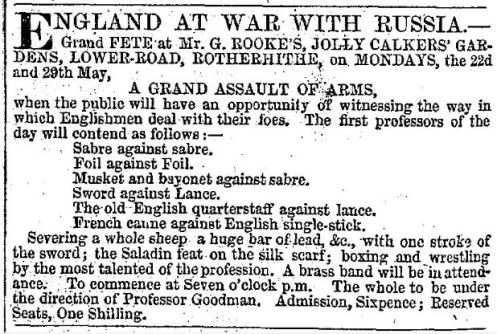
1854 announcement for a Grand Assault of Arms involving the “old English quarterstaff” under the direction of a “Professor Goodman,” published in the Era, on May 21.
Later, in 1862, Robert Kemp Philp stated that, “the inhabitants of some of the northwestern counties of England are still remarkably expert at the quarter-staff, and take great pleasure in the play of it.” And that same year, Professor John C. Gregory, an instructor at the Leeds Gymnastic Club, began holding a number of Grand Assaults-of-Arms throughout Britain (at venues such as Victoria Hall in Leeds, and the Crystal Palace in London), at which figured “rustic sports,” including contests and demonstrations of the “Old English Quarterstaff” (see image below). Some of these contests, it was noted, were held before the Queen of England.
In 1865, Major-General Sir Robert Napier wrote a letter to the Duke of Cambridge, noting that, “our [military] men…furnish the best boxers, wrestlers, and quarter-staff players in the world.” (17) During the mid-1860s, the weapon experienced a surge in popularity, and was featured in numerous Grand Assaults and military tournaments—a trend that would last until the turn of the century. (18) During this same period of popularity, multiple authors were in agreement that the quarterstaff traditions were essentially being rescued from the brink of extinction–verifying the sentiment expressed in the 1828 Bell’s Life letter. For instance, in his 1883 text, Thomas McCarthy, after writing of his own “sixteen years’ experience” with the quarterstaff, lamented that the weapon had “become almost obsolete.” And in its March 5th, 1897 issue, the Navy & Army Illustrated magazine noted that “it is much to be regretted that [the quarterstaff] should have been allowed to drop into almost entire disuse.”
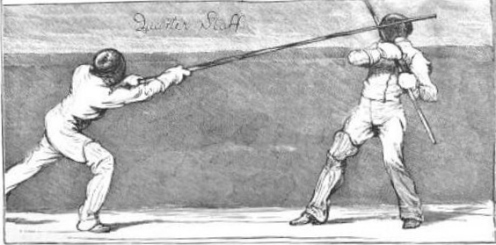
Above: A quarterstaff assault at the London Athletic Club, 1874 (from the Graphic, Vol. 10). During the 1880s and 1890s, British treatises on staff technique would be published by practitioners Thomas McCarthy, R.G. Allanson-Winn, and C. Phillips-Wolley.
LATE GERMANIC AND SCANDINAVIAN TRADITIONS
The Germanic equivalent of the quarterstaff (the Lange Stange or Halbe Stange), figured prominently in a number of Renaissance-era treatises. Later, during the eighteenth century, German quarterstaff fencers were pictured in an engraving of a late Fechtschule (fencing school) that notably depicts the use of numerous “antiquated” weapons, including the quarterstaff:
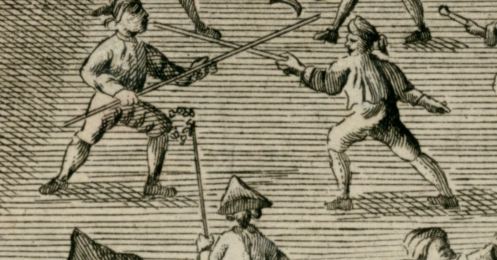
This early 18th-century copperplate depicts a late Fechtschule of the Marxbrüder and Federfechter. Source: Christoph Amberger’s site; original at https://fencingclassics.wordpress.com/2010/01/22/fechtschule-germany-18th-ct/
According to the writings of noted duelist and fencing master, Colonel Thomas H. Monstery, a tradition of quarterstaff fencing survived into the nineteenth century in his native Denmark, as well as in neighboring regions of northern Germany, where it was taught to members of the peasant militia, primarily for use in riot control. Monstery states that the staff exercise was still being taught in those areas, or were when he was a “youth.” Given Monstery’s date of birth, this would have been during the 1830s or early 1840s.
According to Monstery, a line of men, so armed “with big staves,” could clear a path through any mob, provided that the latter did not have firearms. (19)
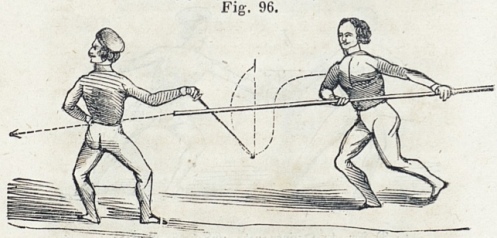
Above: Defense against staff weapons in the system of Pehr Henrik Ling (founder of the Central Institute of Physical Culture in Stockholm), illustrated and published in the 1850s by a disciple of Ling’s system. Monstery trained at the Central Institute, where, according to his biography, he was certified as a Master of Arms. Image from the author’s collection.
It is, perhaps, here worth noting as an aside that staff weapons, generally speaking, were still used by various European militaries during this period. Likewise, weapons such as the quarterstaff, the spear (used by militias), and the pike (still utilized in naval boarding actions) were part of the curricula at certain Germanic and Scandinavian military academies. The special Austrian Military Teachers’ School at Wiener Neustadt, for instance, one of the Imperial Institutions for Military Education, maintained a curriculum that included “Staff, Rapier, Sword and Bayonet Fencing.” This school was charged with the task of training and providing “instructors in gymnastics and fencing for all the military schools and for the troops.” (20) Likewise, the Central Institute of Physical Culture (Kungliga Gymnastiska Centralinstitutet) in Stockholm, founded by the celebrated Dr. Pehr Henrik Ling (himself a fencing master), offered instruction in the use of the pike and spear. (21) The Royal Military Gymnastic Institute (Kongelige Militaire Gymnastiske Institut) at Copenhagen, directed by Franz Nachtegall, also included the quarterstaff as part of its fencing curriculum.

Ling’s Central Institute in Stockholm, where Monstery trained. Source: http://www.stockholmskallan.se
MONSTERY’S QUARTERSTAFF TREATISE
It was at this last-mentioned institution, the Royal Military Gymnastic Institute at Copenhagen, where Col. Monstery learned to handle the “sword, musket and bayonet, rapier, cudgel and quarterstaff” during the 1840s. (22) Monstery also continued his studies at Ling’s Central Institute of Physical Culture at Stockholm, which (as previously noted) included the use of other staff weapons in its curriculum.
After traveling the world, and taking part in numerous duels, battles, and revolutions, Monstery immigrated to America, where he opened several fencing academies, and continued to teach and demonstrate older methods of fence throughout the United States, as can be seen in many accounts of his fencing events. (23) In a well-publicized Grand Assault-of-Arms held in New York City in 1876, at the Lyceum Theatre on Fourteenth Street, Monstery included contests and demonstrations of the quarterstaff, as well as other older weapons such as the rapier and smallsword. According to one of the many newspaper announcements for this event,
“The weapons used on that occasion will include foil, broadsword, rapier, bayonet, lance and Bowie-knife, the English single stick and the double quarter staff, which was formerly the great weapon in use among the athletic peasants of the west of England.” (24)
In 1877 and 1878, Monstery published his treatise on the art and science of self-defense, which, after covering boxing, kicking, grappling, and cane defense, included two chapters on the use of the quarterstaff. In his first such chapter, Monstery notes that, at the time of writing, the two-handed staff was still being carried by the inhabitants of the mountainous regions in Europe, and
“as Americans are always traveling in these countries nowadays, and always liable to get into trouble with the people, it may be useful to know how to handle a long staff as well as a short one.”
Monstery thus declares,
“It has struck me that a few words on the use of this two-handed staff may not be uninteresting at the present day…”
In the pages of his treatise, Monstery describes his own method as “a little different” than the old British style. However, he presents his illustrated figures in medieval costume, in acknowledgment of the fact that “the scientific use of the staff dates from those times.”
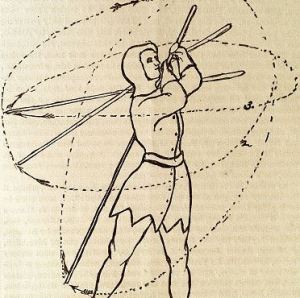
Above: One of several illustrations from the quarterstaff section of Monstery’s treatise, showing an exercise to give “ease and suppleness.” Photograph of original from the author’s collection.
In his lessons, Monstery instructs the reader to use a staff as high as one’s head. His technique includes a variety of guards, parries, “blows,” feints, and includes both “cutting” attacks as well as thrusts.
There is also a distinctive pedagogic quality to Monstery’s lessons that is missing from other quarterstaff treatises. For instance, Monstery includes footwork drills in his chapter on the staff, as well as exercises that give the user of the quarter-staff “the same ease and suppleness which the moulinets give with the single-handed cane or single stick.” (25)
All of its uniqueness aside, Monstery’s work is special in that it is the first quarterstaff treatise published during the nineteenth century, and the only such treatise published in America prior to the twentieth century. (26)
POSTSCRIPT
After his Grand Assault-of-Arms at the Lyceum Theatre, there is no further record of Monstery publicly exhibiting or demonstrating the use of the staff, and the old fencing master eventually passed away in 1901. However, in 1875, Monstery had posted the following advertisement in the New York Herald:
“WANTED—A MASTER OF THE ART OF FENCING, or one who is desirous of learning the profession, to become an assistant at Colonel MONSTERY’S Fencing and Boxing Academy, 619 6th av.” (27)
The next year, in 1876, the Army and Navy Journal noted that Monstery had acquired an assistant, one Captain James McGregor of London. (28) McGregor would go on to issue and accept a number of challenges in New York State, at least two of which included the quarterstaff. Notably, McGregor had taken part in Monstery’s Grand Assault at the Lyceum, in which quarterstaff fencing had been exhibited. More than two decades later, as reported by the Buffalo Courier-Record, McGregor would accept a challenge from the famed champion Duncan Ross. McGregor stipulated that it be a contest of “mixed weapons,” which would include “quarterstaff.” (29)
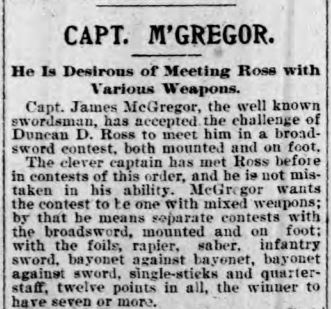
Above: Monstery’s former assistant, Captain James McGregor, accepts Ross’s challenge in the Buffalo Courier-Record, 1897.
In 1899, McGregor issued another challenge to Maestro Generoso Pavese, who had claimed the title of champion, and who had defeated a number of fencers in several widely-publicized contests. Again, McGregor’s challenge included the quarterstaff:
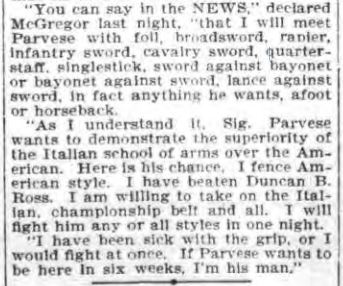
Above: Another challenge from McGregor, to Pavese, published in the Buffalo Evening News, March 5, 1899.
McGregor’s comment (seen in the image above) that he fenced “American style” is an interesting one, given his British origins. Whether McGregor was using Monstery’s quarterstaff technique in these contests, or a system that he learned in his own country, is a matter of speculation. Whatever the case, the report is evidence that as late as 1899, quarterstaff fencing was still alive and well in New York State.
Colonel Thomas H. Monstery‘s martial wisdom survives in his treatise on Boxing, Kicking, Grappling, and Fencing with the Cane and Quarterstaff, which was recently published by North Atlantic Books in book form for the first time. This volume contains a new, detailed biography of Monstery, and includes additional writings by the Colonel.
Additional articles about Thomas H. Monstery can be found here as well.
NOTES:
- Thomas Hoyer Monstery, Self-Defense for Gentlemen and Ladies (Berkeley: North Atlantic Books, 2015).
- Minutes of the Common Council of the City of New York, 1675-1776 (New York: Dodd, Mead and Company, 1905), Vol. 1, 94.
- Donald McBane, The Expert Sword-Man’s Companion, Or the True Art of Self-Defence. With An Account of the Author’s Life, and his Transactions during the Wars with France. To which is Annexed, The Art of Gunnerie (Glasgow: Printed by James Duncan, and are to be sold at his Shop in the Salt-Market, 1728), 66-67.
- Rev. John Wesley, Sermons on Several Occasions (New York: Carlton & Phillips, 1855), Vol. II, 271.
- John Harland, Collectanea Relating to Manchester and Its Neighborhood, at Various Periods (Printed for the Chetham Society, 1847), Vol. II, 91-92. Following is the account of Barret: “When I was a boy about eight years old, a noted prize fighter came to Manchester, by name Thomas Barret, an old man, with his face cut and scarred all over, so that for the most part he went by the name of ‘Old Chopping-block.’ He taught the science of defence (or what I should think was sometimes offence), in a large room at the Old Boar’s Head, Hyde’s Cross. While in town he articled with a stranger to show their feats of arms in public, in a yard near Salford Chapel; at which place I attended to see the exhibition, which was performed upon a stage in manner following: First, the champions entered the lists in their shirts, and bare-headed, with each a quarter-staff, about two yards long and as thick as the handle of a pikel. These they brandished and whirled about with surprising dexterity; not forgetting every now and then to reach each other a lusty souse upon the sides, shoulders, or head, which was no ways displeasing to the spectators…In some while after Thomas Barret went to Ireland, and there followed the same business, and in a combat received a cut in his belly, which let his bowels out and ended his days.”
- Sir Jonah Barrington, Personal Sketches of His Own Times (London: George Routledge and Sons, 1869), 33. Barrington, a member of the Irish Protestant Ascendancy, recounted in 1827 that his grandfather “had taught me the broadsword exercise with his cane, how to snap a pistol, and shoot with the bow and arrow; and had bespoken a little quarter-staff to perfect me in that favourite exercise of his youth, by which he had been enabled to knock a gentleman’s brains out for a wager, on the ridge of Maryborough, in company with the grandfather of the present Judge Arthur Moore, of the Common Pleas of Ireland. It is a whimsical gratification to me to think that I do not at this moment forget much of the said instruction which I received either from Michael Lodge the Matross, or from Colonel Jonah Barrington—though after a lapse of nearly sixty years!”
- Henry Angelo, The Reminiscences of Henry Angelo, with Memoirs of his Late Father and Friends, Including Numerous Original Anecdotes and Curious Traits of the Most Celebrated Characters that Have Flourished During the Last Eighty Years (London: Henry Colburn and Richard Bentley, 1830), Vol. II., 426-427. According to Angelo, “this Robin Hood…had often given his lordship a good thrashing.”
- In 1788, Christopher Towles, of High Street, in Coventry, offered instruction in skills “of the greatest use in the Army and Navy,” such as “the Single-Stick, Quarter-Staff, Broad-Sword, Small-Sword, Wrestling, Boxing…” Advertisement (originally from 1788) reprinted in the Northampton Mercury, Oct. 22, 1842.
- Peter Hampson Ditchfield, Old English Sports, Pastimes and Customs (Methuen & Co., 1891), 38, 54. Ditchfield recounts, “The game of quarter-staff is an old pastime which was a great favourite among the rustics of Berkshire. The quarter-staff is a tough piece of wood about eight feet long, which the player grasped in the middle with one hand, while with the other he kept a loose hold midway between the middle and one end…An old parishioner of mine, James of Sandhurst, was once the hero of quarter-staff in the early part of the [nineteenth] century.”
- The Gentleman’s Magazine (Westminster: John Nichols and Son, 1822), 286.
- Cambrian and Caledonia Quarterly Magazine and Celtic Repertory, Volume 5 (London: H. Hughes, 1833), 61. See also Ditchfield, 38, 54.
- Cobbett’s Weekly Register, August 10, 1805.
- Lt. John Russel, A Series of Military Experiments in Attack and Defence, Made in Hyde Park in 1802, Under the Sanction of His Royal Highness the Commander in Chief (London: T. Egerton, 1806), 210.
- Nestor Lonchophoros [Major John Cartwright], Military hints to the Greeks (London: Richard and Arthur Taylor, 1821), 5.
- Lt. Col. Baron De Berenger, Helps and Hints how to Protect Life and Property (London: T. Hurst, 1835), 255.
- John Bowring, The Works of Jeremy Bentham (Edinburgh: William Tait, 1843), Vol. IX, 342.
- Colonel Willoughby Verner, The Military Life of H.R.H. George, Duke of Cambridge (London: John Murray, 1905), Vol I, 332.
- The resurgence in the 1860s can be documented by a number of accounts in the British media; see, for instance, Leeds Mercury, January 11, 1866; London City Press, March 31, 1866; Sporting Life, March 31, 1866; Brighton Gazette, Dec. 20, 1866; Chelmsford Chronicle, April 12, 1867; Aldershot Military Gazette, June 13, 1868; for the 1870s onward, see Tony Wolf, “‘A Grand Assault-at-Arms’: Tournaments and Combative Exhibitions in Victorian England” in The Journal of Manly Arts (August, 2001).
- Monstery, Self-Defense for Gentlemen and Ladies, 165.
- Report of the Commissioners Appointed to Consider the Best Mode of Re-organizing the System for Training Officers for the Scientific Corps (London: Eyre and Spottiswoode, 1857), 215.
- Monstery, Self-Defense for Gentlemen and Ladies, 4.
- Ibid.
- Ibid, 28-31.
- Ben Miller, A Grand Assault-of-Arms in Old New York, Directed by Colonel Monstery, 2015.
- Monstery, Self-Defense for Gentlemen and Ladies, 163-174.
- Although the Chicago-based instructor Giuseppe Riboni published a book in 1862 entitled “Broadsword and Quarter-staff,” the weapon referred to as the “quarter-staff” therein is actually the Italian bastone a dui mani. See Giuseppe Riboni, Broadsword and quarter-staff without a master: broadsword fencing and stick or quarter-staff play, after the latest European practice adopted in the military schools of France and Italy, and the United States (Chicago: E. B. Myers: 1862).
- New York Herald, July 22, 1875.
- Army and Navy Journal, April 22, 1876.
- Buffalo Courier-Record, October 15, 1897.
Text of this article © 2015 by Ben Miller.
“In the encounter with Monstery, at the end of a four hours’ bout neither of the parties had gained a point, and the combat was declared a draw.”
By Ben Miller
During the late nineteenth century, the field of women’s self-defense would be greatly advanced by two very special individuals—a fencing master and duelist, Colonel Thomas Hoyer Monstery, and his precocious student, Ella Hattan (popularly known as “Jaguarina”), who would go on to become regarded by many as one of the greatest swordswomen of the nineteenth century, and possibly of all time.
COLONEL THOMAS MONSTERY
“It is a great mistake to suppose that women cannot learn fencing as quickly as men…”
In 1870, one of America’s most distinguished martial arts masters opened a “School of Arms” in New York City. He was a fencing master, boxer, marksman, sailor, adventurer, street fighter, soldier of fortune, and world traveler. He was Colonel Thomas Hoyer Monstery.
When it came to combat, Monstery had an impressive resume. He had fought under twelve flags in numerous wars and revolutions, had survived participation in more than fifty duels with the sword, knife, and pistol, and had twenty-two scars on his body to prove it. In addition to being a “master of all arms” (which included the rapier, dagger, broadsword, Bowie knife, lance, bayonet, and quarterstaff, among others), Monstery was also a “professor of sparring,” and taught a special system of bare-knuckle self-defense that integrated punching, grappling, and kicking techniques, designed to be effective against a wide range of fighting styles.
One of Monstery’s most unusual traits, however, was that he encouraged women to take up fencing with a variety of weapons, as well as boxing, long before it was both popular and fashionable for them to do so. As early as the 1850s, Monstery was teaching fencing to the famous actress Lola Montez, and later, during the 1860s, to the equally famous Ada Isaacs Menken. In 1874, in New York City, his fencing advertisements offered “Private Instruction to Ladies and Misses” in both fencing and calisthenics. In an 1888 interview, Monstery expounded,
“It is a great mistake to suppose that women cannot learn fencing as quickly as men…the fact is the women are much the quicker pupils. They are more flexible of body; their limbs are more supple and elastic—that’s one advantage. Their mental brightness enables them to pick up the strategy of the art quicker—that’s a second advantage. And, thirdly, they have more nerve—it’s a fact; I don’t know why, but it’s a fact.”
Monstery claimed that he taught his female pupils no differently than he did men. This was a great point of distinction; typically, the scarce fencing instruction available to women during this period was limited to the use of the foil, an academic training tool. Monstery, however, did not limit his instruction to the art of the sword; in 1888, he was teaching “two classes of lady-boxers”; in New York City, he also held several ladies’ classes in stick self-defense. Evidence also suggests that to select female students, he also provided instruction in the rapier, dagger, knife, and bayonet. Additionally, Monstery included a special drill in his curriculum intended to prepare his female pupils for potential street encounters, teaching them to deliver a “bayonet thrust” with their parasols, which, he said, “would break a rib, or a one-handed thrust, that would put out an eye.” In his martial arts treatise, Self-Defense for Gentlemen and Ladies, Monstery noted:
“An umbrella is a fearful weapon if used with both hands like a bayonet. It will parry the blows of a big bully, and you can return him a stab in the face or breast or stomach that will settle him. A lady can defend herself from outrage with her parasol in the same way…I remember a certain girl who killed a ruffian who assaulted her by a stab with the point of her parasol.” (Chapter 11)
Monstery also insisted that his female students eschew the wearing of fashionable (but restrictive) corsets, and “any other of those modern inventions…wherewith the female human form divine is disguised as a human monstrosity.” Corsets, the habitual use of which would later be linked to health problems, were condemned by Monstery in favor of comfortable garments “loose enough to allow free-play to every muscle and sinew.”
Perhaps due to this progressive attitude, Monstery was able to attract a remarkable number of high-profile female students, securing the tuition of many notable actresses, including Mildred Holland—who, according to one account, became “one of the most expert fencers in America.”
ELLA HATTAN, a.k.a. “JAGUARINA”
“Strong and supple as steel, she presented an extraordinary picture … the heavy blades cut through the air like flashes of lightning, and steel rang on steel in a series of movements so rapid in execution as to defy being followed by the eye.”
Monstery’s greatest student, however, was a young female prodigy named Ella Hattan, who would popularly become known by her nom de guerre, “Jaguarina.” Under Monstery’s tutelage, Hattan would go on to become recognized as one of the greatest swordswomen of the nineteenth century, and perhaps of all time.
According to United States census records, Ella Hattan was born in 1859 in Zanesville, Ohio, to a Spanish American mother named Maria, and an Anglo-American father. The latter, William Hattan, would go on to be killed in the Civil War when Ella was still a child.
Although it is not certain how she and Monstery first met, when Hattan was still in her teens, she began performing with a Cleveland theatrical troupe (John Ellsler’s stock company) that eventually made its way to New York, and it seems likely that this was the circumstance by which she first came into contact with the Colonel. According to most accounts, when Hattan was eighteen years old (around the year 1877), she became a pupil of Monstery at his New York school of arms. Some later sources declare¸ contrarily, that Hattan began training with Monstery at age twenty in Chicago (see, for instance, Macon Telegraph, May 27, 1906). However, given Hattan’s year of birth, whether she began training at age eighteen or twenty, or even twenty-three, Monstery would still have been living and teaching at his academy in New York City (the Colonel not having departed for Chicago until 1883). According to the Chicago Tribune,
“When but 18 years of age she became a pupil of Col. Monstery in New York, but three years later left there, and has since traveled through countries where the sword is still a principal weapon of offense and defense.” (Chicago Daily Tribune, Apr. 19, 1885)
The New York Times reported,
“The Colonel declared he would make the little girl the greatest woman fencer of her time, and from him she learned all she knew of the art.”
Actually, Hattan had begun training at eight years of age, having first learned to fence with the foil and knife from her mother. Still, it was from Monstery that Hattan acquired proficiency with the saber and broadsword—the weapons she would use to win the vast majority of her contests. Regarding her training, Hattan recalled that Monstery “knew her ability, but was determined that she should learn confidence by experience and hard knocks.” Hattan further recounted,
“I fenced three hours a day with foil and sabre for three years before I was considered really qualified as a fencer… The road to success as a sabre fencer is paved by aching muscles and bruises from cuts from a sword.”
Hattan also stated that for several years she received “a thorough military training in the use of the foil, rapier, knife, sabre and bayonet and in horsemanship.” Although she did not specify the teacher from whom she learned these weapons, considering that Hattan was known to fence several unusual weapons that Monstery was also known to have taught or exhibited (such as the dagger and the Bowie knife), it seems likely that Hattan learned the use of these weapons from the Colonel as well.
According to Hattan’s own account, Monstery was so rigorous in his instruction, and withholding of praise, that when she finally began contesting with other experienced swordsmen she was shocked to discover that she could beat them all.
“Let it be clearly understood that no man need hesitate to challenge me because I am a woman…”
After training for three years under Monstery, Hattan left to travel the world, and became a sensation with the foil, saber, broadsword, singlestick, rapier, dagger, bayonet, lance, Spanish knife, and Bowie knife, defeating fencing heavyweights such as Sergeant Owen Davis of the U.S. Cavalry, the famed knife duelist Charles Engelbrecht of the Danish Royal Guard, and the fencing master E. N. Jennings of the Royal Irish Hussars. One of her challenges, posted in the Los Angeles Herald, stated:
“Let it be clearly understood that no man need hesitate to challenge me because I am a woman, or think he will be called on to show me any consideration for that reason. I grant no favors and I certainly ask none. It is said that this is the day of the ‘new woman.’ If it be so, I hope someone who desires to sustain the reputation of his sex will challenge me before I get to be an old woman and give the ‘new woman’ another chance to prove she is the superior of man.”
The following 1886 account of Hattan’s combat versus Captain Jennings gives an idea of her prowess with the sword:
“Lithe as the animal she takes her cognomen from, and strong and supple as steel, she presented an extraordinary picture as she awaited the onset. When the signal was given the heavy blades cut through the air like flashes of lightning, and steel rang on steel in a series of movements so rapid in execution as to defy being followed by the eye. Backward and forward in single steps the combatants retreated and advanced, until finally the Captain’s arm bent slightly, and the next moment a sounding thwack on his breastplate betokened a point for Jaguarina… The doughty Captain perspired freely, and the gallantry he intended to show the lady had to be thrown away. When he became warmed up the struggle was most exciting, and the scores alternated until the close, when Jaguarina had counted 12 times and he 11.”
Another exciting account of Hattan’s fencing, this time in a contest against the German master-at-arms, Captain Conrad Wiedemann, appeared in the October 29, 1888 issue of the San Diego Union:
“In the twelfth attack Jaguarina dashed to Wiedemann’s corner, there was a crash of arms, a prolonged ring of steel, a blade was seen to flash through the air, and Jaguarina threw the fragments of a broken sword from her to the ground. In an instant another sword was put into her hand, and again she dashed towards her opponent and slashed right and left, and a moment later the referee announced a point for Jaguarina…the score this time stood five to five. Jaguarina’s friends urged her to be cautious, but she, heeding nothing, rushed at her opponent and cut right and left, Weidemann parrying with all his might and skill. Recovering himself from the first shock, he aimed a cut at Jaguarina in high carte which was met by a strong parry which threw his sword arm out of line, and before he could return his weapon to protect himself, the sound of Jaguarina’s blade was heard on his cuirasse from a vigorous and unmistakable cut in carte, ending the contest with a score of six to five in favor of Jaguarina. The victor at once doffed her helmet and cuirasse and received round after round of applause from those present, many of her more enthusiastic friends throwing their caps high in the air…”
By 1897, Hattan had defeated sixty men in contests on foot as well as on horseback, and was declared “the only woman in the world who has…been able to wrest championship honors from men of the greatest skill in the use of all chivalric weapons.” For the past twelve years, asserted the Boston Daily Globe, she had “met all comers in mounted contests, and has never been defeated in a battle for general points.” Of these opponents, twenty-seven were said to have been masters-at-arms—a statistic verified by at least one major newspaper. Although there were some who might take issue with Hattan’s “undefeated” status (such as one Captain Xavier Orlofsky, who technically defeated her in a controversial New York contest in which he was accused of “deliberately committing” four fouls), the fact is, that even with such exceptions taken into account, Hattan’s fencing record was extraordinary.
“As soon as she comprehended what his words meant, bang, biff! she landed right and left, and he fell to the ground…”
Hattan could also defend herself well with her bare hands, and there is every evidence that she benefited from Monstery’s system of bare-knuckle self-defense. Once, after being cornered by a rude, presumptuous man, her fists went into action:
“As soon as she comprehended what his words meant, bang, biff! she landed right and left, and he fell to the ground. ‘Get up, you coward,’ she commanded, and he, overcome by the ringing tones, very foolishly crawled to his knees. Biff! Bang! Right and left landed again, and down he went, and this time he refused to get up and sprawled on the ground, calling for help. It was several days before he was presentable, while Jaguarina laughingly showed her friends in this city the next day that she knocked the fellow down twice without even taking the skin from her rosy little knuckles.” (Los Angeles Herald)
Despite such accounts, more than one reporter who met her, expecting to meet a “fierce faced Amazon,” was shocked to find that Hattan exuded grace, refinement, and, as one put it, “perfect self-control and sweetness.” As Hattan herself explained,
“I’m a firm believer in the philosophy that women were meant to be just as robust and hardy as men—and they can be without losing any of their womanliness. In fact, physical culture gives grace, beauty, self-reliance—while taking nothing but aches and dyspepsia.”
Hattan also began training for bullfights in Los Angeles—-but in the end, her humanistic side got the better of her. During her first day of training, after dexterously evading numerous “lighting-like” charges of the bull, Hattan leapt out of the ring and refused to hurt the creature, insisting “I couldn’t kill him…why should I? He has as much right to live as I have. Please see that he has plenty of good hay and water.”
REUNIONS WITH COLONEL MONSTERY
“My advice to people who wish to learn to fence is to go to a good master.” – Ella Hattan, “Jaguarina,” 1903.
In 1884, after Monstery had moved his School of Arms to Chicago, Hattan reunited with her old mentor for a lively public fencing contest. In the resulting encounter between the two, one master and the other student, it was recorded that
“In the encounter with Monstery, at the end of a four hours’ bout neither of the parties had gained a point, and the combat was declared a draw.”
Hattan would continue to reunite with Monstery throughout the years. More than a decade later, in 1895, during her proposed contest with Jean Gordon (a Scottish swordswoman), it was noted that “Colonel Monstery and others will act as judges.” (Daily Inter Ocean, July 14, 1895)
The next year, in Milwaukee, prior to one of Jaguarina’s mounted sword contests, it was noted that
“The mounted combat will not be called until 9 o’clock. At 8:30 o’clock Jaguarina will fence with foils with Col. Thomas H. Monstery of Chicago, the chamption master-at-arms of the world, who lately defeated Pini, the champion of Europe.” (Milwaukee Sentinel, Apr. 17, 1896)
Whether this fencing bout between Monstery and Hattan was to be a warm-up for her mounted combat, or was an actual fencing exhibition, is unclear. It is, however, additional evidence of a long-lasting, nearly two decades-long relationship between the old master and his precocious student. For although Hattan gave credit to various other fencing teachers (such as an “old actor,” and a Mexican cavalry officer), it is telling that in all of her interviews, Monstery is the only instructor Hattan ever mentioned by name—and repeatedly. In 1898, she stated simply that “Colonel Monstery of Chicago, a famous old Danish swordsman who had fought in the Mexican war, was my teacher. He is now living, and though advanced in [years] is healthy and alert.” Later, in a 1903 interview (given after Monstery was deceased), Hattan’s advice on how to attain proficiency in fencing can be seen as a partial tribute to the Colonel: “My advice to people who wish to learn to fence is to go to a good master.”
MONSTERY AND HATTAN’S LEGACY
Several of Monstery’s female students would go on to become prominent fencing and self-defense instructors in their own right—including Ella Hattan, who led classes comprised of “beautiful southern women, daughters of old confederate officers.” Hattan would become a widely-regarded authority on physical culture, especially as it pertained to women. A reporter visiting Hattan’s Los Angeles school in November, 1890 noted:
“Swords in racks and arranged in trophy groupings, armor and fencing paraphernalia of all descriptions, composed the ornamentation and utility of this quaint apartment, which comes nearer the realization of a hall of the mediaeval period than anything else existing in this part of the world….Jaguarina is the personification of health and grace, and possesses much magnetic force as well. She is capable of illustrating every individual movement that she teaches, and to give an intelligent and satisfactory reason for the especial object thereof.”
Monstery must have been proud of his former pupil, for his official biography, published in Chicago of Today (1891), stated:
“The Colonel has had among his gentlemen and lady pupils the champions of America, both in fencing and boxing, among whom were…Miss Jaguarina.”
During the late 1890s, a flurry of American newspaper articles announced fencing as the new “fashionable” activity for women, and the number of female fencers literally exploded. Even Monstery’s professional rivals, who had formerly taught few women, began holding numerous self-defense classes specifically catering to “ladies.” Monstery, however, proudly claimed to be the first master of the period to hold public exhibitions featuring groups of female fencers.
One can only wonder if Monstery’s faith in, and encouragement of, the female martial artist was instrumental in fostering a trend which would continue into the twentieth century.
FURTHER READING
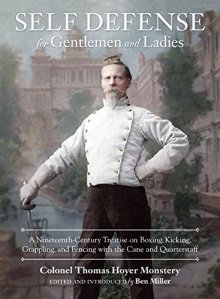 Although he passed away in 1901, Colonel Monstery‘s martial wisdom survives in Self-Defense for Gentlemen and Ladies: A Nineteenth Century Treatise on Boxing, Kicking, Grappling, and Fencing with the Cane and Quarterstaff, which was recently published by North Atlantic Books in book form for the first time. This volume contains a new, detailed biography of Monstery, and includes additional writings by the Colonel.
Although he passed away in 1901, Colonel Monstery‘s martial wisdom survives in Self-Defense for Gentlemen and Ladies: A Nineteenth Century Treatise on Boxing, Kicking, Grappling, and Fencing with the Cane and Quarterstaff, which was recently published by North Atlantic Books in book form for the first time. This volume contains a new, detailed biography of Monstery, and includes additional writings by the Colonel.
NOTE: The sources for the quotations in this article (appearing without citations) can be found in the Introduction to Self-Defense for Gentlemen and Ladies.
This article © 2015 by Ben Miller.
Additional articles about Colonel Monstery:
A Grand Assault-of-Arms in Old New York, directed by Col. Thomas Monstery
Colonel Thomas H. Monstery and the Use of the Quarterstaff
The Victorian Gentleman’s Self-Defense Toolkit
A Bare-Knuckle Fight at Colonel Monstery’s
Only one year after the first exhibition of Kung Fu in America, on January 18, 1891, the following headline graced the columns of the New York World:
This brutal contest took place in a Chinese grocery at 23 Pell Street, and was fought between laundrymen Wong Hoy and Lee Yen, for a purse of twenty dollars. By all accounts, it was a case of David versus Goliath. Yen was described as a six-foot-two “giant” weighing 225 pounds, and one who had accomplished many “wonderful feats of strength.” Hoy, on the other hand, was five-foot-three, exhibited a “consumptive look,” and weighed 120 pounds. However, it was noted that Hoy had “a record of many victories in Philadelphia and Boston.” Regarding the conditions, it was noted:
“Chinese rules were to govern….there is no ring marked off at all. Combatants may kick, punch, claw, bite, wrestle, jump upon each other or dig each other’s eyes out. Weapons alone are barred.”
The World elaborated,
“The gentlemanly knockdowns, clinches, dodging and racing around the ring to avoid punishment which constitute a fight under Marquis of Queensberry rules are looked upon with disdain by these Orientals. There could be a mill in Chinatown seven nights of the week and no opportunity would ever be offered for disputes among the backers. ‘Everything goes,’ and there can be no foul. The battle is not won until one of the bruisers is a temporary corpse. Until knocked insensible he is not allowed to throw up the sponge.”
Just before 8:30 PM, the grocery began to fill with Chinese sporting types, most of whom placed their bets on the larger fighter. The two combatants stepped forward, attended by their seconds, and then began, according to the World, “the first prize fight in the history of Mott street.”
“Lee opened with a tremendous kick…Without a moment’s delay Wong dodged behind the giant and administered a terrible kick in the small of the back. Then he buried his sharp claws into Lee’s face, and rained kick after kick upon his body in rapid succession. Before the big fellow knew what had hit him Wong released his hold, dived under [Lee’s] legs and beautifully threw him. The bulky mass…dropped like a log, head first.”
A “jumping match” then ensued, with Wong Hoy on top. After jumping on Lee Yen three times, Hoy “dug his long finger-nails into Lee’s face and opened pores of his skin in many places, causing the beautiful crimson to flow. A few more kicks and a jump or two for good measure and Lee’s senses had flown.” It was noted,
“There could only be one decision, and when the referee recovered his breath he ordered stakes turned over to the victor. …. Everybody except Wong had bet the wrong way and that individual had everybody’s money. With the same saucey smile the Hartford prodigy asked pleasantly whether there happened to be any one in the crowd who thought he knew how to carry himself scientifically. None volunteered.”
Hoy was thus celebrated throughout New York’s Chinatown.
American newspapers reacted with universal horror toward these contests. In his account of the Pell Street contest, a disturbed reporter from the Rome Daily Sentinel pontificated,
“Such is Chinese pugilism, and its essential features, if adopted in the American prize ring, would doubtless relieve the community of its pugilists. What feather, middle or heavy weight could stand such tactics as those allowed in the case of Wong Hoy and Lee Yen?”
NOTE: A greatly expanded version of this article, covering other Kung Fu contests and practitioners of the same period, appears in the 2015 March/April issue of Kung Fu Magazine, under the title Kung Fu in Early America.
 Notice that the following book, Self-Defense for Gentlemen and Ladies: A Nineteenth-Century Treatise on Boxing, Kicking, Grappling, and Fencing with the Cane and Quarterstaff, will soon be released, in April, 2015. This treatise, originally published in New York City during the 1870s as a series of illustrated articles, has been collected and compiled for the first time, and has been supplemented with numerous antique illustrations and a glossary of technical terms.
Notice that the following book, Self-Defense for Gentlemen and Ladies: A Nineteenth-Century Treatise on Boxing, Kicking, Grappling, and Fencing with the Cane and Quarterstaff, will soon be released, in April, 2015. This treatise, originally published in New York City during the 1870s as a series of illustrated articles, has been collected and compiled for the first time, and has been supplemented with numerous antique illustrations and a glossary of technical terms.
The author, Colonel Thomas Hoyer Monstery, was an important figure in New York City martial arts history. He fought under twelve flags, participated in more than fifty duels with the sword, knife, and pistol, and taught a variety of systems and techniques at his New York City academy—including fencing with the foil, rapier, saber, broadsword, dagger, knife, cane, quarterstaff, lance, bayonet, and others. Moreover, his system of unarmed self-defense comprised bare-knuckle boxing, grappling, kicking, and head-butting, and was designed to defend against a wide variety of fighting styles (some used locally in New York), including French Savate, British “purring” (shin-kicking), African American head-butting, Danish head-butting, American rough-and-tumble fighting, Welsh jump-kicking, and more. Following is a video trailer for Monstery’s book:
“China is the last place in the world in which you’d expect to find gladiators, and yet we have them here and very clever ones, too…”
Continued from PART I, which recounted the martial experiences of Dr. Edward Bedloe in China.
THE GLADIATORS OF CHINA
[Special Correspondence of THE ITEM].
NEW YORK, Oct. 23, 1891.
Some time ago I furnished my readers with an account of the manner the Chinese fight by poking their rigid fingers into each other’s eyes and faces. It was sent me by my old friend, Dr. Bedloe, U.S. Consul at Amoy. Last week I received from him the following account of the style of combats now prevalent among Chinese gladiators. I wonder if the Romans took this style of combat from the Chinese:
“China is the last place in the world in which you’d expect to find gladiators, and yet we have them here and very clever ones, too. They form a separate profession, or guild, to themselves. They are included under the head of actors by the Celestial lawmakers, but look down upon the average Thespian as a Pariah of the poorest type. The tricks of the trade are taught by father and son, and it is impossible to attain a high proficiency unless one has been practiced and trained, from infancy up.
“Their performance is two hours long and consists of all sorts of feats of arms with swords, daggers, war-axes, shields, spears and tridents…”
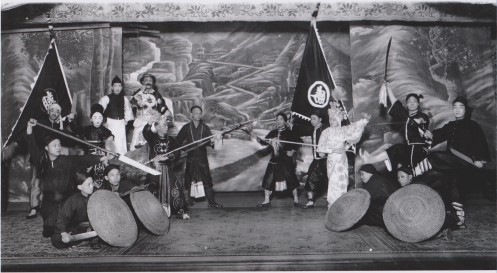
Cantonese Opera Performers in San Francisco, circa 1900, exhibiting some of the same type of weapons as in Bedloe’s account. Source: http://chinesemartialstudies.com/
Their performance is two hours long and consists of all sorts of feats of arms with swords, daggers, war-axes, shields, spears and tridents. The weapons have no edges or points, of course, as in the heat of action the gladiators at times, inflict pretty heavy blows. In some cases the spears and tridents have the points topped with leather covers that resemble miniature boxing gloves. The swords are lighter and shorter than ours, weighing scarcely more than dueling rapiers. They have no guards to the hilt. The spear and tridents have thin bamboo handles, the lightest and strongest wood there is. The shields are made of rattan and bamboo; they weigh but little, but will successfully resist a heavy spear thrust or a powerful sword blow. Much of the fighting is like Italian fencing or the Zouave sword against bayonet drill. But even these are thrown so many barbarian tricks and muscular feats that the resemblance is very slight. The most interesting to me was trident against sword and shield. The contestants were undersized men, but so sinewy and fine, from years of professional work, that they seemed a mass of muscles. Their costume was a single garment that would have passed muster as bathing trunks.
“The ‘tridenter’ was as agile as a cat and ran around his adversary never stopping…”
When ‘time’ was called they approached within ten feet of each other, saluted, and entered into action. Each touch, by trident on the one side, or sword on the other, counts a point. A round lasts ten minutes, when a well-earned recess is taken for three or four minutes, until the fighters have cooled off sufficiently. The ‘tridenter’ was as agile as a cat and ran around his adversary never stopping. He would feint and thrust rapidly, now at the head, then chest, now the loins and then the shins. Usually the swordsman would stop the blow with his shield held obliquely so as to make the trident glance off and let its holder be carried forward by the impetus of the blow. When he succeeded in this, and it was very rare, he would get in a rousing blow with the flat of his sword. In some cases he would spring sideways, and parry the trident with his sword and with a circular sweep of the wrist of a return lunge endeavor to strike his antagonist. To my eyes the honors were about even, but some Chinese friends said that the tridenter had won and in real battle would have killed the swordsman.
“The fencing was extraordinary…”
Quick, novel and exciting was the two-sword contest. To each gladiator was given a sword in a scabbard. They saluted, drew swords and dropped the sheaths. To my surprise the sword was double, the same as if a hilt were split in half, and to each half a blade affixed. The weapons were double-edged though of course dull and pointless. The fencing was extraordinary. It had in it some of the features of our sabre practice, but was as quick and nervous as a French foil assault. The men were here, there, and everywhere, the four muscular arms and the four steels seemed whirling in every direction. Now and then a storm of applause would follow the heavy ‘thwack’ given by the flat of the sword, when one of the men got an opening, but the work was too rapid for my barbarian eye to appreciate its artistic value. But it was wonderful as a mere matter of acrobatics.
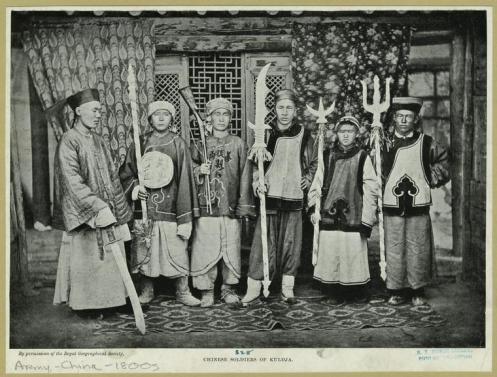
“Chinese soldiers of Kuldja.” (1902). Royal Geographical Society. Source: http://chinesemartialstudies.com/
These martial feats, I am told, are very common in the interior of China, where there are regiments today armed as in the dead years of Timour the Tartar, to whom the revolver, riddle and cannon are unknown. In the coast provinces the armies are European in equipment and drill, and have been for fifty years. The gladiator in these districts is no longer a soldier, as in Ho Nan and Sze-Chuen, but a juggler and a strolling player.”
It seems that the love of physical prowess is universal.
MACON (McCormick.)
– Reported in the New Orleans Item, October 27, 1891.
***
NOTE: For further reading on Kung Fu in nineteenth century America, see The First Exhibition of Kung Fu and Chinese Martial Arts in America: Brooklyn, 1890.
Also, the images of combatants in this article come from the Kung Fu Tea blog, which we highly recommend.
“It is one of the most effective choking holds known…”
The following short treatise on the Cornish style of wrestling appeared in the Evening Star on June 27, 1903, and was penned by Professor Anthony Barker, President of the Physical Culture Association of America, located at 110 S West 42nd Street, and later at 1164 Broadway, New York City. 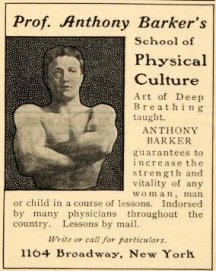 Barker seems to have been running a booming mail-order business in physical culture literature and broadsides, as can be seen in his numerous period advertisements. He also wrote a number of articles on old, rural styles of wrestling.
Barker seems to have been running a booming mail-order business in physical culture literature and broadsides, as can be seen in his numerous period advertisements. He also wrote a number of articles on old, rural styles of wrestling.
Barker commented briefly on the tradition of Cornish grappling in America for the magazine Health, in which he noted,
As has been stated in both Graeco-Roman and catch-as-catch-can wrestling, a clever wrestler can very rarely be thrown directly from his feet, to his back on the mat. It is first necessary to “get behind” or above him. There is still one method of doing this while the men are still on their feet, which we have not yet described, and this is by means of “clicks” or trips. The word “click” is an old English wrestling slang or technical word, sometimes spelled “cleek.” You will hear it used by the old Cumberland and Cornish wrestlers, many of whom have come to this country to work in mines. The copper country of Michigan and some of the mining regions of Pennsylvania are still great places for wrestling, the sport being fostered by a love for it which is generations old in these Cumberland, Westmoreland and Cornwall men. At their matches, many of the old and quaint wrestling expressions are still heard. For instance, the referee is called “stickler,” and when, in his movements, he obstructs the view of the spectators, they shout out, “Move around, stickler.” As the spectators are all around and he is in somebody’s view all the time, the poor “stickler” is kept on the move continually.
Following is Barker’s short treatise detailing the techniques of Cornish wrestling, reprinted in full:
“In nearly every man’s life, whether he will or no, a time generally comes when he is dragged into a rough-and-tumble fight. Then, if he knows something of Cornish wrestling, he will be able to take care of himself admirably…”
Evening Star, June 27, 1903.
Written by Prof. Anthony Barker.
One of the best ways for a man to fit himself for self-defense through physical culture is to take up the style of wrestling least known in America: the Cornish. In nearly every man’s life, whether he will or no, a time generally comes when he is dragged into a rough-and-tumble fight. Then, if he knows something of Cornish wrestling, he will be able to take care of himself admirably.
The distinctive feature of Cornish wrestling is the canvas jacket which each wrestler wears and on which the different holds must first be secured. For this reason a man learns how he could grab the coat of a man who might attack him on the street or elsewhere and use this apparel of dress to the discomfiture and defeat of its owner. The man who delights in rough-and-tumble exercise, and he is numerous, will find Cornish wrestling just about the acme of his favorite kind of sport. He will also discover that, for all its apparent go-as-you-please methods, it is not lacking in scientific qualities, and that he will get plenty of healthful excitement from the most picturesque of all styles of wrestling.
The coat used for Cornish wrestling can be easily made at home. It is of stout canvas, with no collar, loose, elbow sleeves, and a tail coming well down over the hips. It is built so that it will lack about eight inches of meeting over the chest. The fronts are joined by three pieces of stout rope hooked over buttons, securely sewed, so that hard pulling will not loosen them. The topmost rope is across the nipples, and the space between each rope is eight inches. The sleeves are loose, so that a wrestler can get a hand up and through them for certain holds. The jacket is skimpy in front to prevent holds, the ropes, which fasten the coat on, reducing the chances of holds to a minimum. The tail is long, so that the wrestler can make the coat fit snugly and still further reduce his opponent’s opportunities for a hold by gathering up back of him as much of the tail and coat as he can.
“The miners of Cornwall, among whom it originated, formerly wore heavy-soled and spiked shoes, with which they endeavored to cripple one another, and they had no qualms about choking…”
Holds on the Jacket.
All holds with the hands are gained on the jacket, which, therefore, plays the major part in this sort of wrestling. Leg wrestling is fair, however, tripping being scientifically employed. The celebrated grapevine, known to every American schoolboy, is found in its perfection in Cornish. Cornish has not become well known in America, owing to the fact that at one time it abounded in cruelties. The miners of Cornwall, among whom it originated, formerly wore heavy-soled and spiked shoes, with which they endeavored to cripple one another, and they had no qualms about choking. Nowadays, however, even Cornishmen refrain from all brutality, and their favorite sport is no longer considered inhuman. In the coal mining regions of Pennsylvania and in the copper fields of Michigan, where many Cornishmen are settled, this wrestling is the favorite pastime, and every holiday brings numerous bouts.
The cross collar hold, described below, is generally barred in present day bouts, but it is given with the idea that some knowledge of it may come in useful at some time or other for purposes of self-defense against a ruffian. It is one of the most effective choking holds known. As in all forms of wrestling, many of the hundred or more holds possible in Cornish can be studied out and gained after a little practice with the three described.
Sparring for a Hold.
Roll up the sleeves as much as possible. Gather all the slack of the Jacket in one hand, preferably the left, and hold it on the small of the back. With the legs well apart, so as to give a firm and broad base, form an obtuse angle by bending the body forward. Hold the disengaged open hand at arm’s length with the palm out toward the opponent’s face and about a foot from it. (Figure 1.) Keep the position when sparring for a hold, which consists primarily in grabbing some part of the jacket. Agility and keen sight are necessary to do this effectively.
“Step on the foot nearer you, pull him toward and past you and slam him down on the floor…”
The Crowbar.
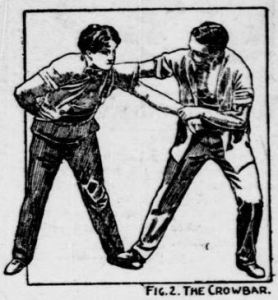 Perhaps you manage to get a hold of your opponent’s sleeve. In that case, shoot your arm up his sleeve and firmly grasp the opposite side of the coat so that your wrist will bear on the opponent’s neck. (Figure 2.) Then, keeping your body out of harm’s reach, grab a wrist of the opponent with your disengaged hand, step on the foot nearer you, pull him toward and past you and slam him down on the floor. Usually you will have to thresh your opponent all around the floor at arm’s length before he will tire sufficiently to be thrown down.
Perhaps you manage to get a hold of your opponent’s sleeve. In that case, shoot your arm up his sleeve and firmly grasp the opposite side of the coat so that your wrist will bear on the opponent’s neck. (Figure 2.) Then, keeping your body out of harm’s reach, grab a wrist of the opponent with your disengaged hand, step on the foot nearer you, pull him toward and past you and slam him down on the floor. Usually you will have to thresh your opponent all around the floor at arm’s length before he will tire sufficiently to be thrown down.
The Cross Collar Hold.
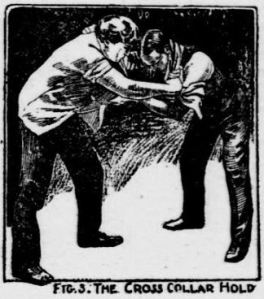 To execute the cross collar hold get the opponent’s jacket in a wad around his neck and well down on his arms. Run one hand through the crumpled mass in front of the neck and under the chin and grab the jacket at the opposite armhole (Figure 3.) Then put the heel corresponding to the arm under the chin back of the opponent’s leg and try to toss him backward. The opponent will find that, try as he will, his hands will not be of much use to him. He will try backing and breaking away, but a little pressure of the arm on the neck and chin will make him stop. As this hold and the crowbar can be made quite rough by means of choking, it would be better, and would serve the purpose of exercise just as well, not to carry the holds to their ultimate issues, but, once they are gained, count them as points and release the opponent.
To execute the cross collar hold get the opponent’s jacket in a wad around his neck and well down on his arms. Run one hand through the crumpled mass in front of the neck and under the chin and grab the jacket at the opposite armhole (Figure 3.) Then put the heel corresponding to the arm under the chin back of the opponent’s leg and try to toss him backward. The opponent will find that, try as he will, his hands will not be of much use to him. He will try backing and breaking away, but a little pressure of the arm on the neck and chin will make him stop. As this hold and the crowbar can be made quite rough by means of choking, it would be better, and would serve the purpose of exercise just as well, not to carry the holds to their ultimate issues, but, once they are gained, count them as points and release the opponent.
The Grapevine.
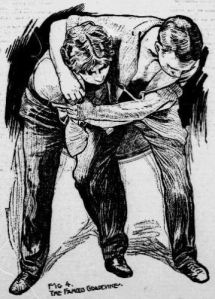 This is the most famous of all the Cornish holds, and is oftenest used. It can be secured in a variety of positions. A common way is as follows:
This is the most famous of all the Cornish holds, and is oftenest used. It can be secured in a variety of positions. A common way is as follows:
Get the opponent’s jacket bunched around his neck and clasp his head in an arm, the hand of which grasps the jacket by the side of the other hand. Entwine the leg nearer the opponent around his leg close to you in such a position that your toes come in front of his shin bone. (Figure 4.) Push the opponent’s leg out behind from under him, press down with the arms and pull his head under and his shoulders on to the floor. Executed in this fashion the grapevine corresponds in general to the “flying mare” in Cumberland and Northumberland.
In honor of African American History Month…
By Ben Miller
When asked to recall a great martial artist of African descent born in the Americas, the average person is likely to mention a twentieth-century boxer such as Joe Louis, or a more recent exponent of the Asian martial arts, such as Jim Kelly. Or, those of the younger generation might name the modern mixed martial arts competitor Anderson Silva, regarded by some as the greatest pound-for-pound fighter of all time.
What many do not know is that in centuries past, some of the greatest practitioners of European martial arts were of African descent.
Although Africans brought a number of their own indigenous techniques with them to Europe and the Americas (as can be read about here), they also sometimes trained in, adopted, and excelled at European swordsmanship—also known as classical and historical fencing.
During the 18th and 19th centuries, it was even possible (albeit difficult)…
View original post 3,989 more words

